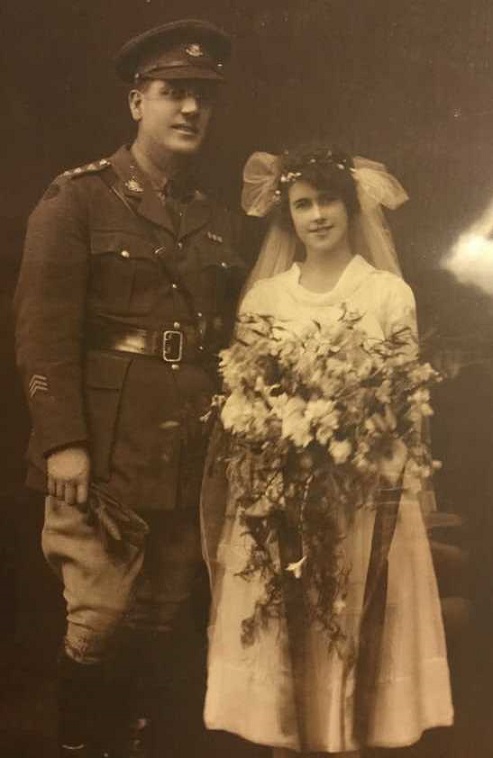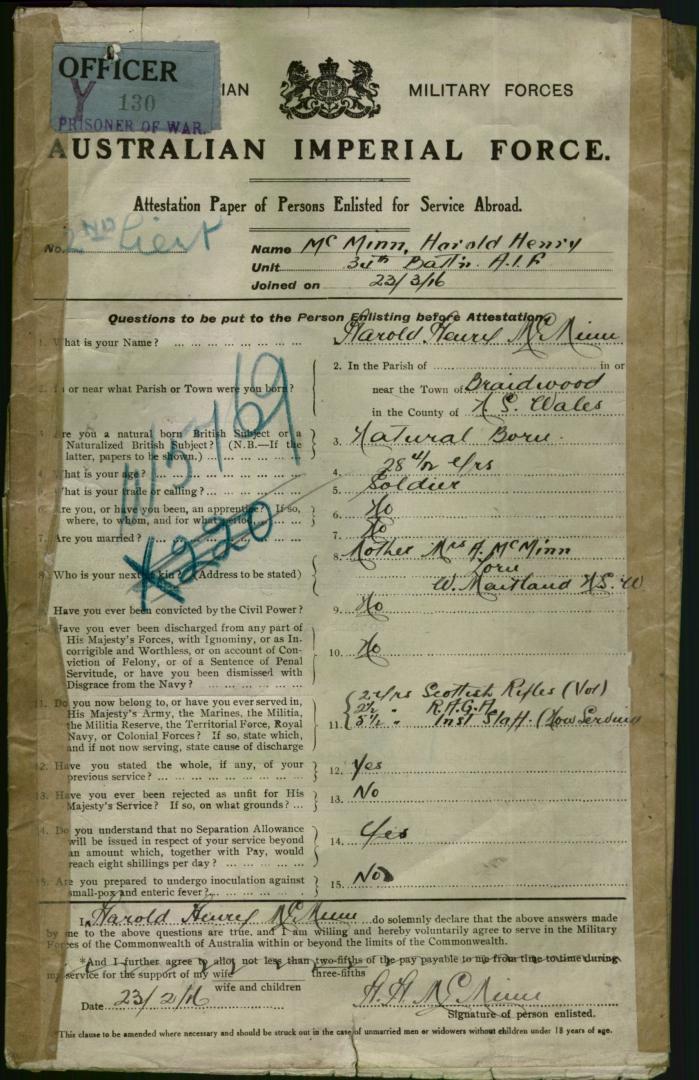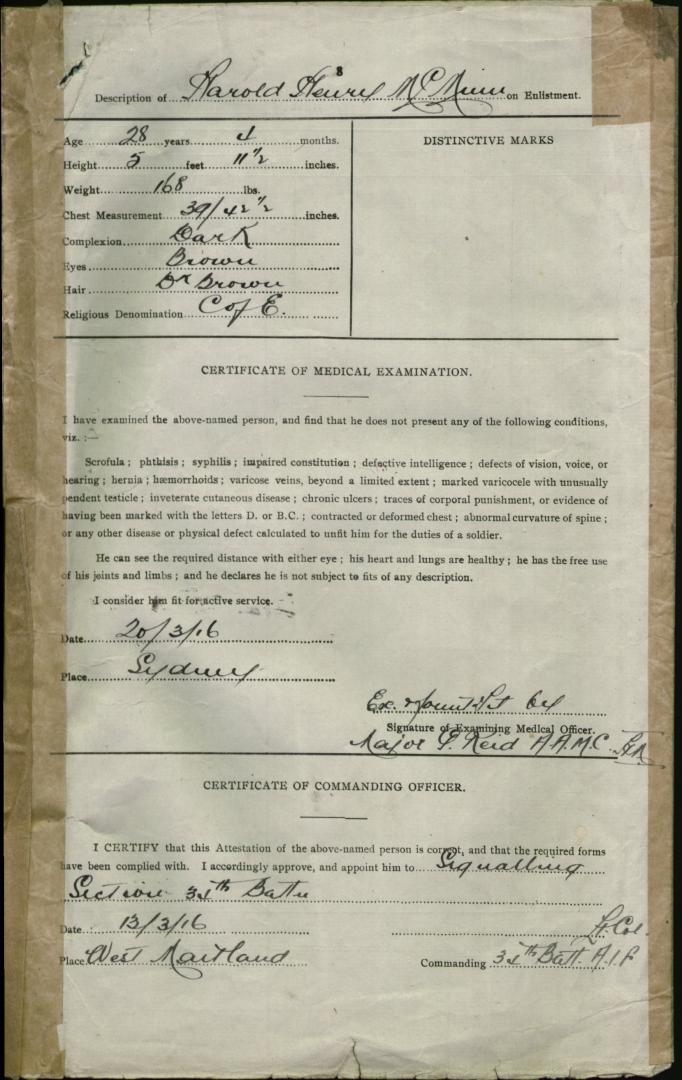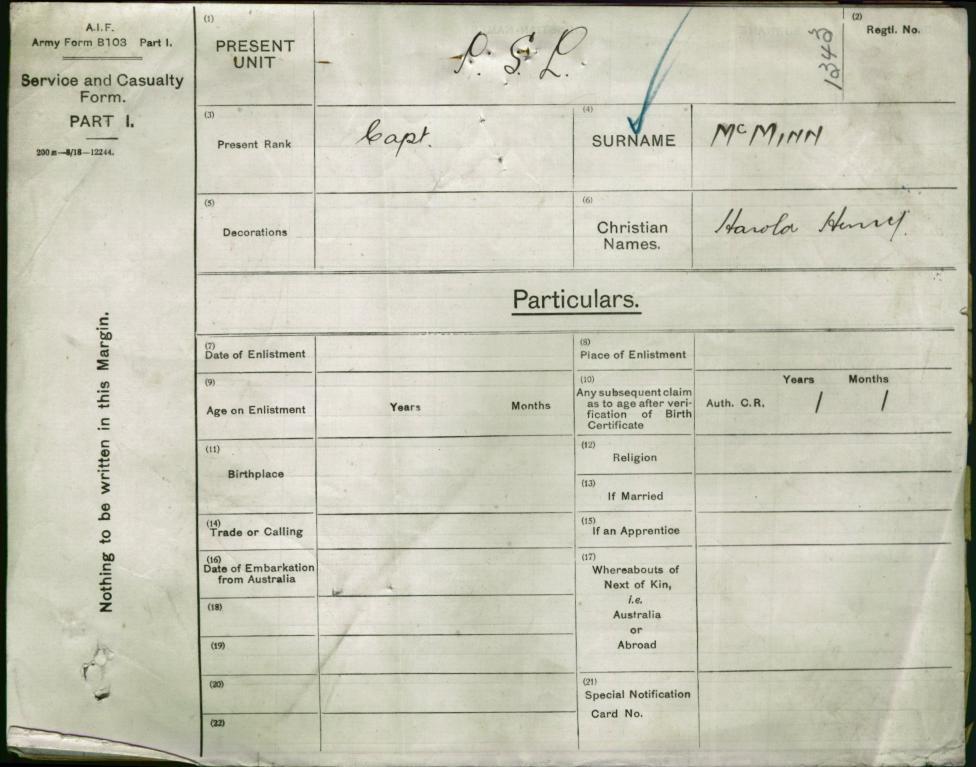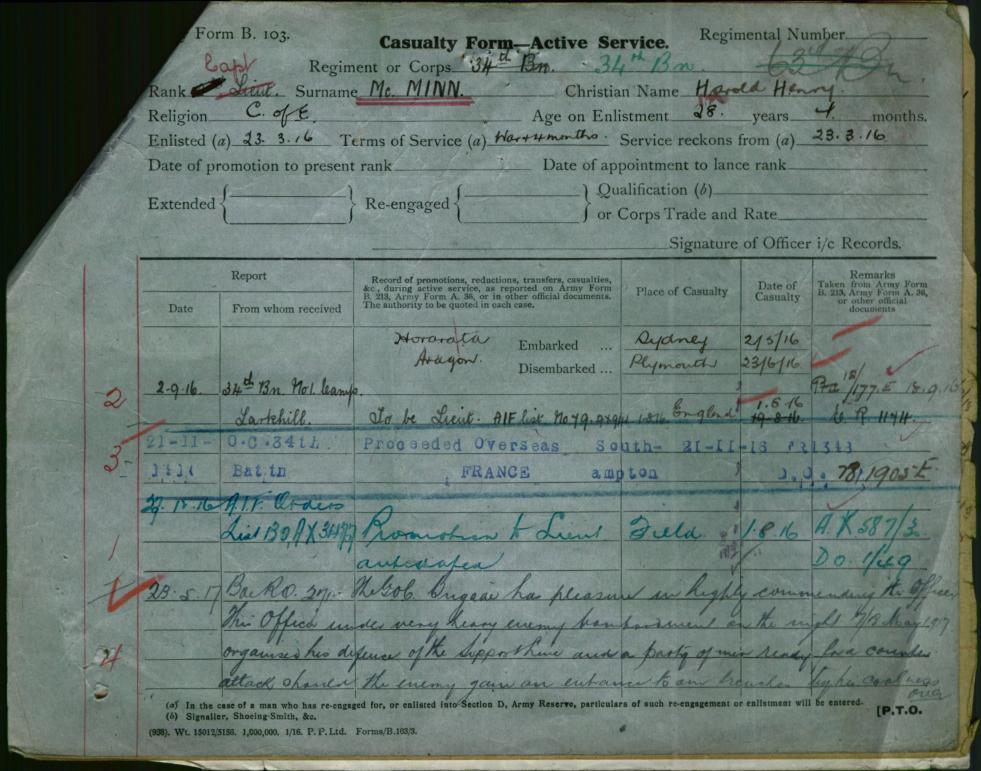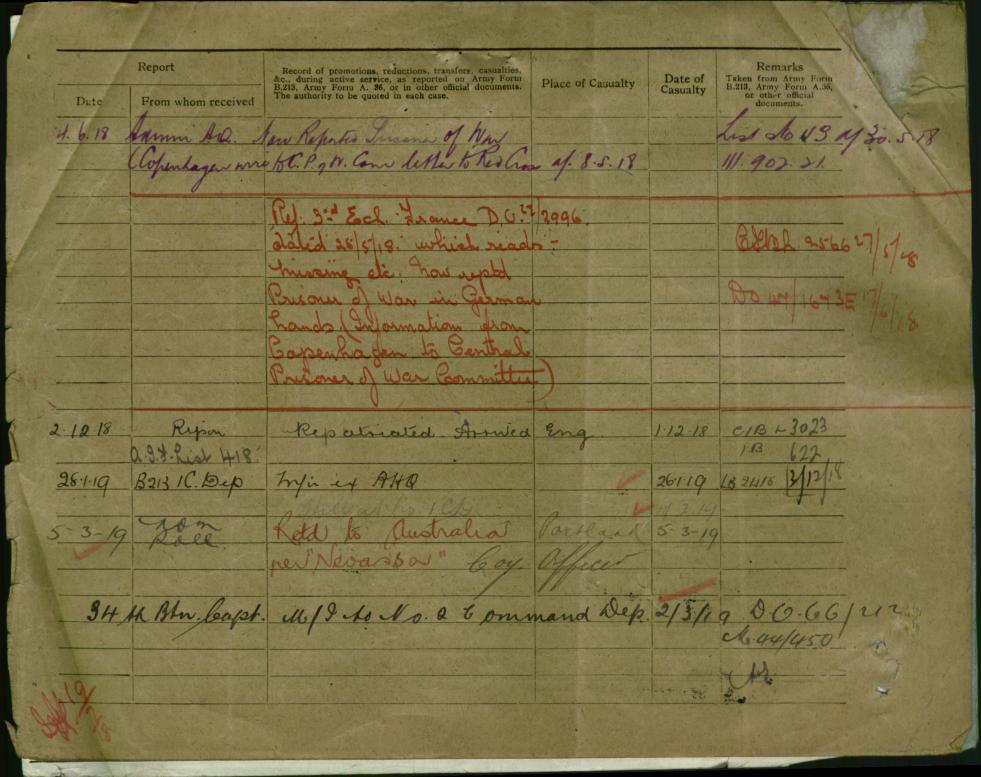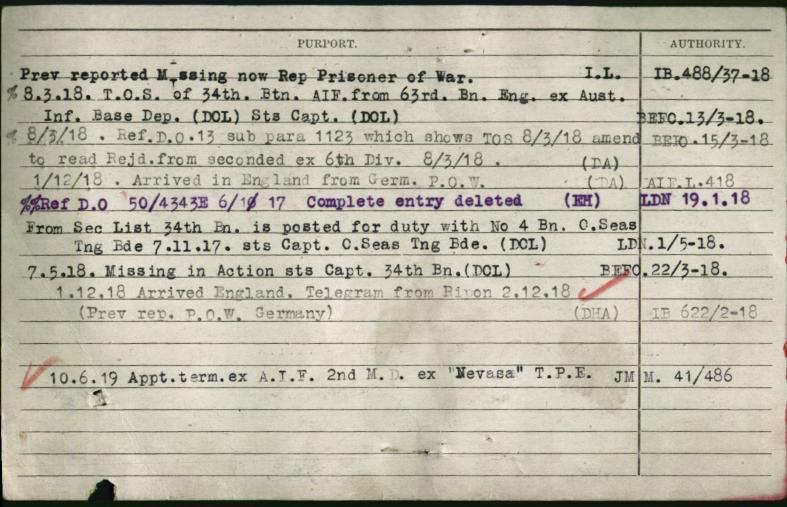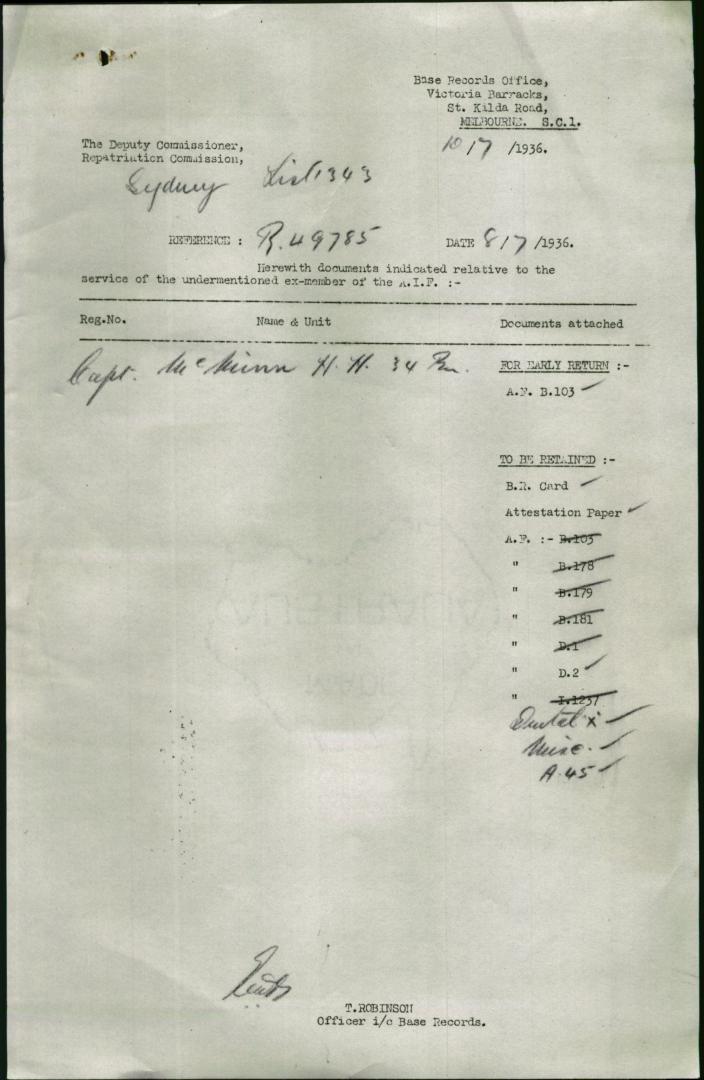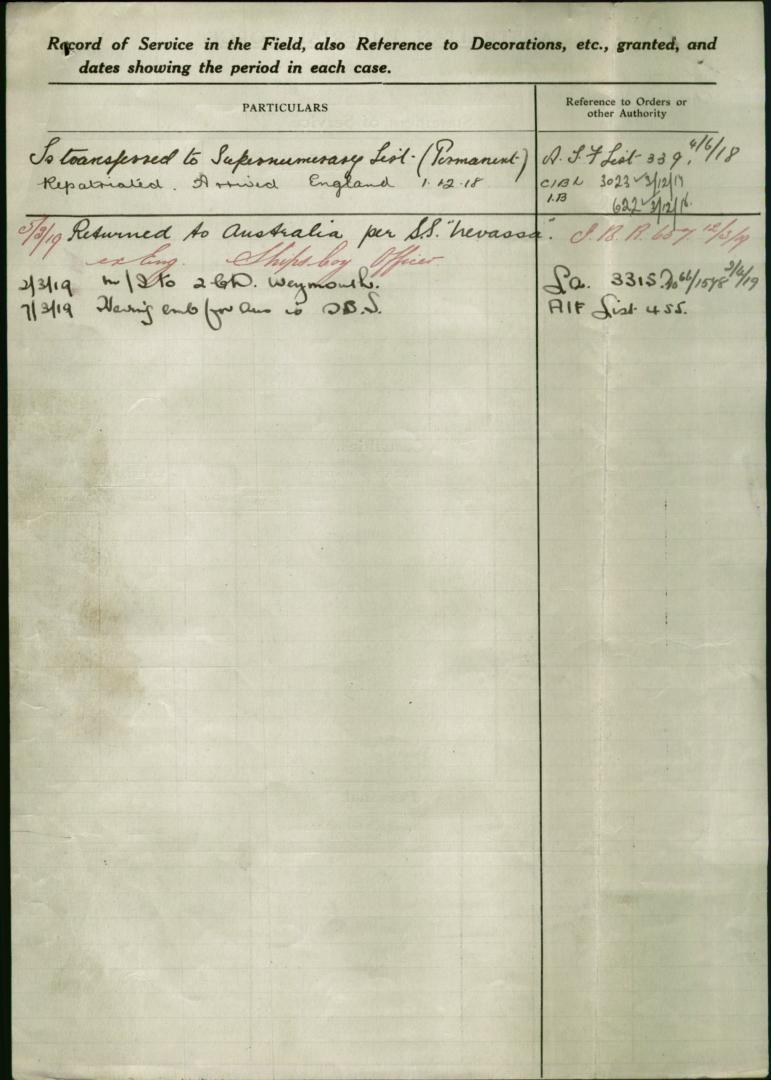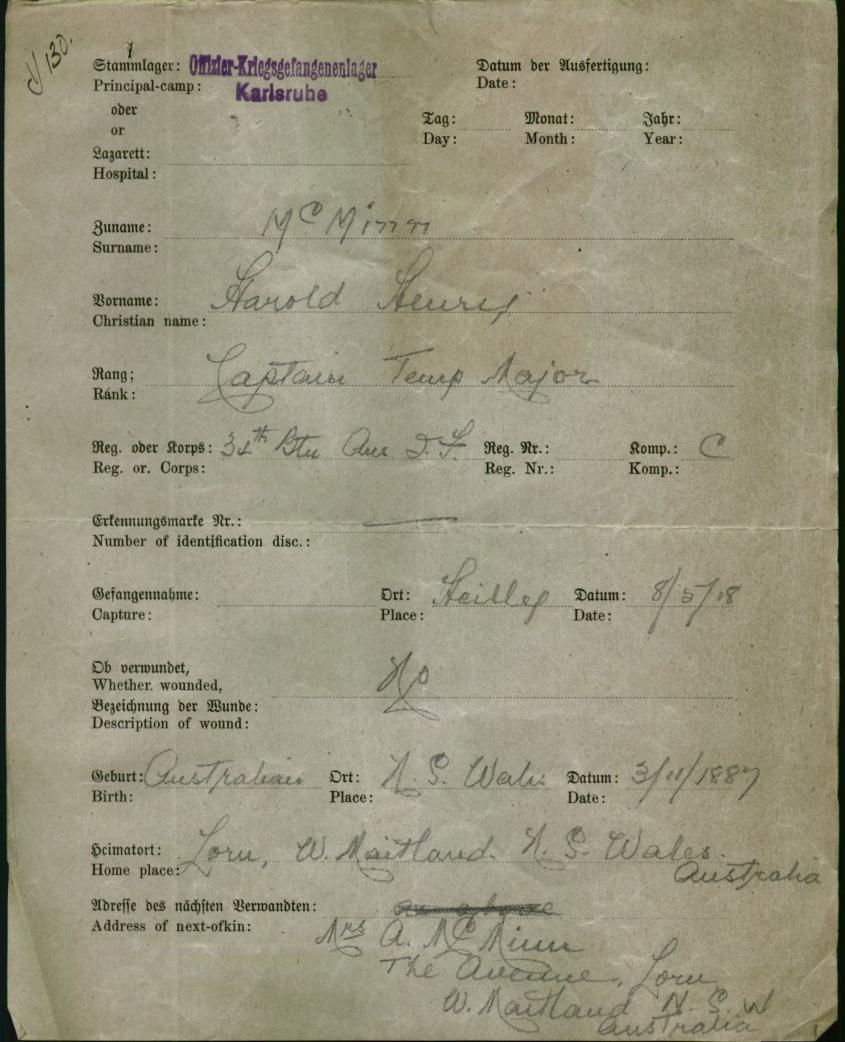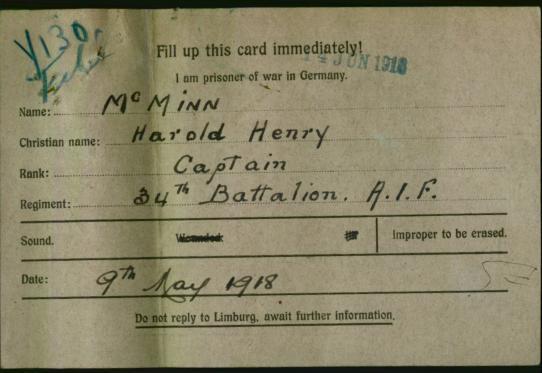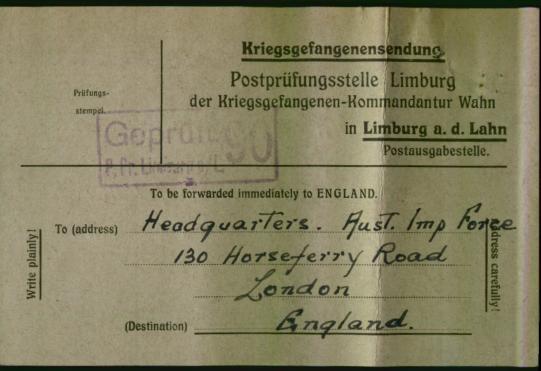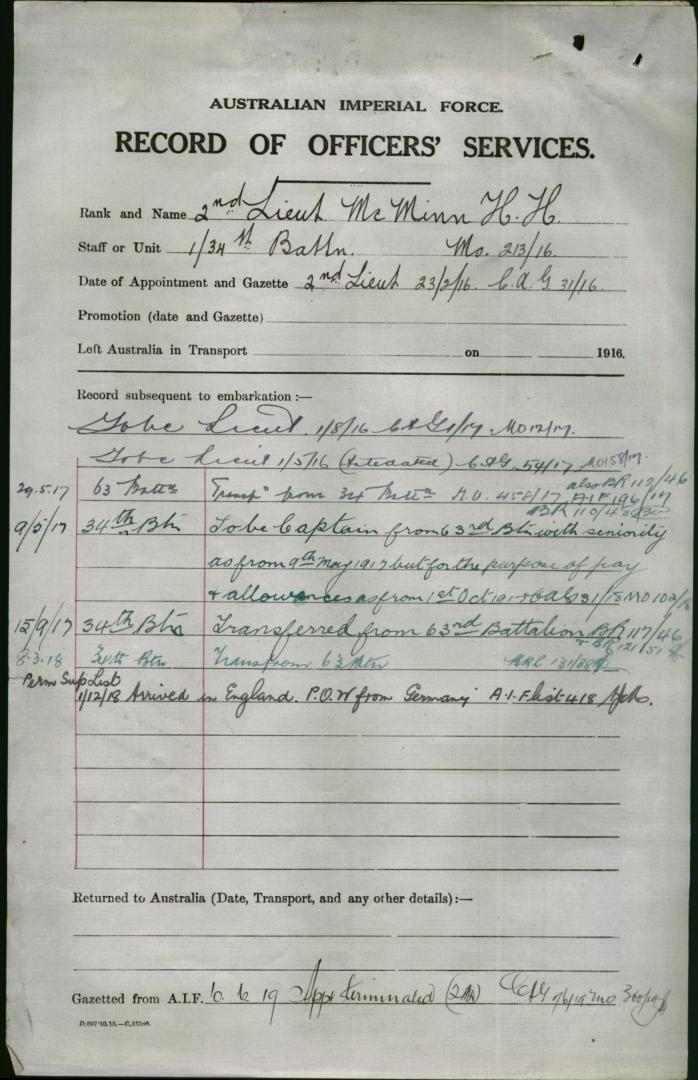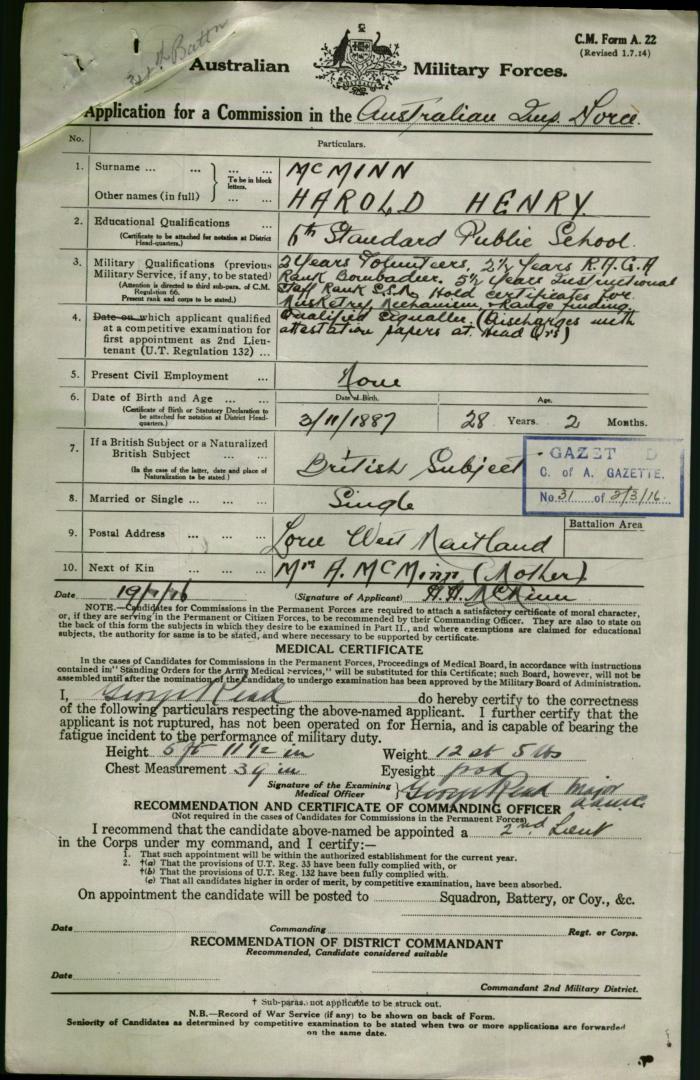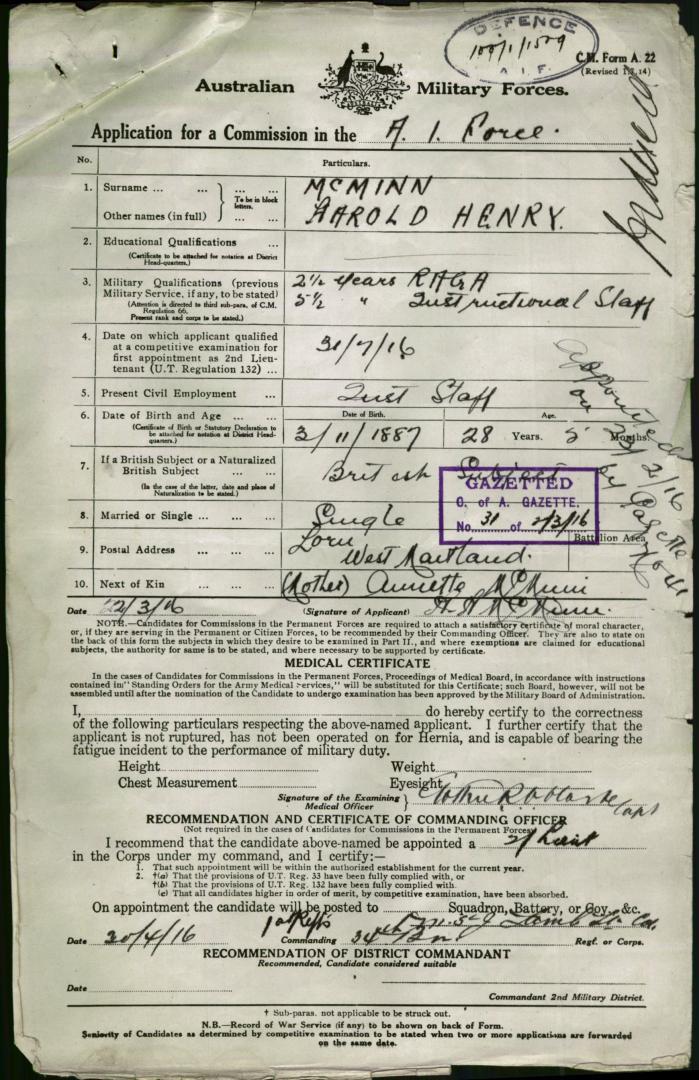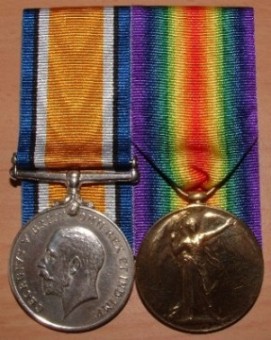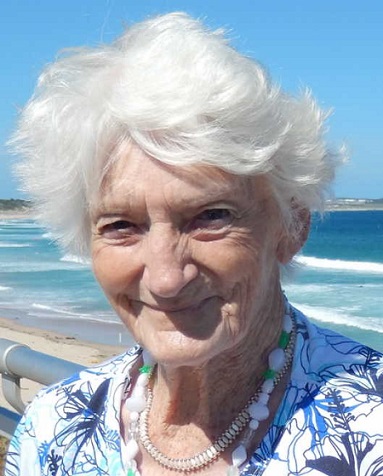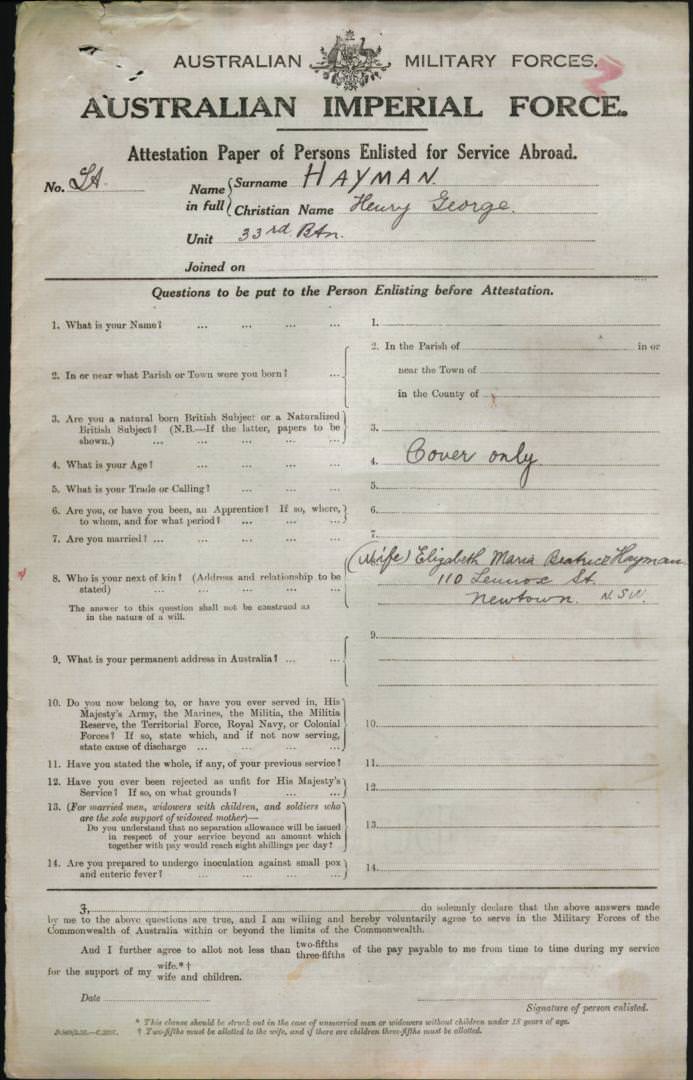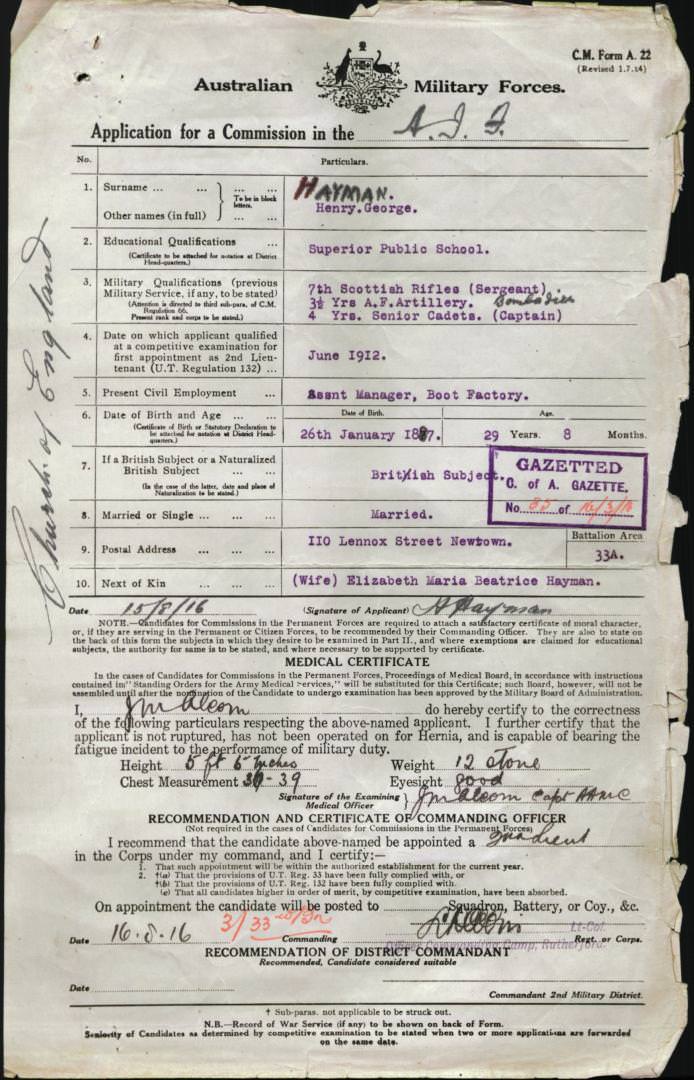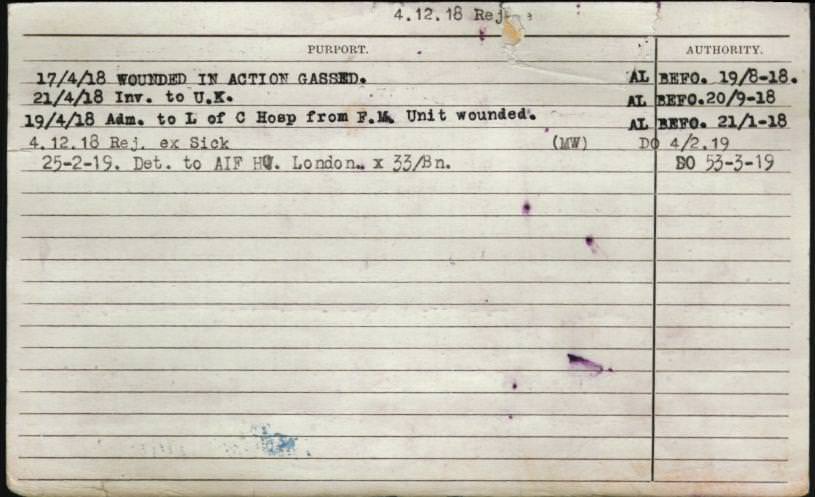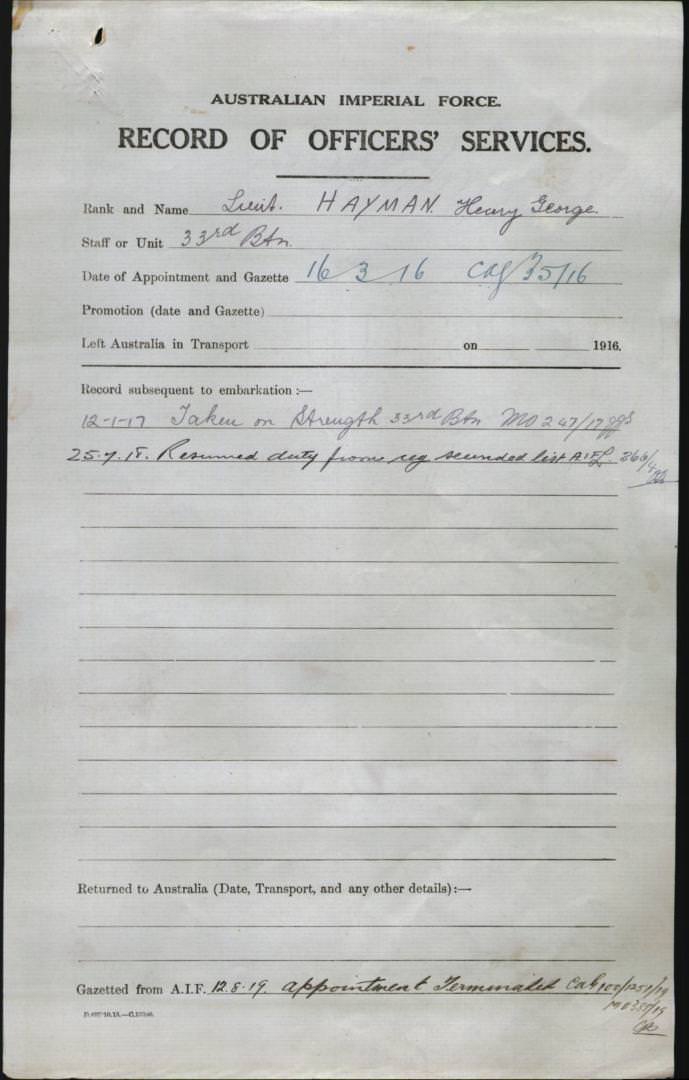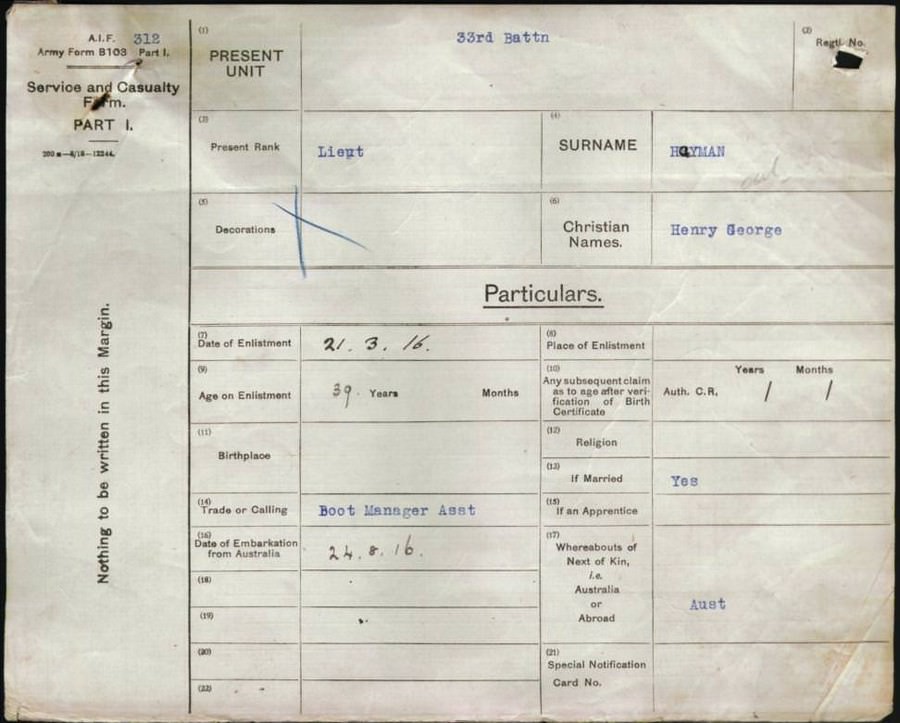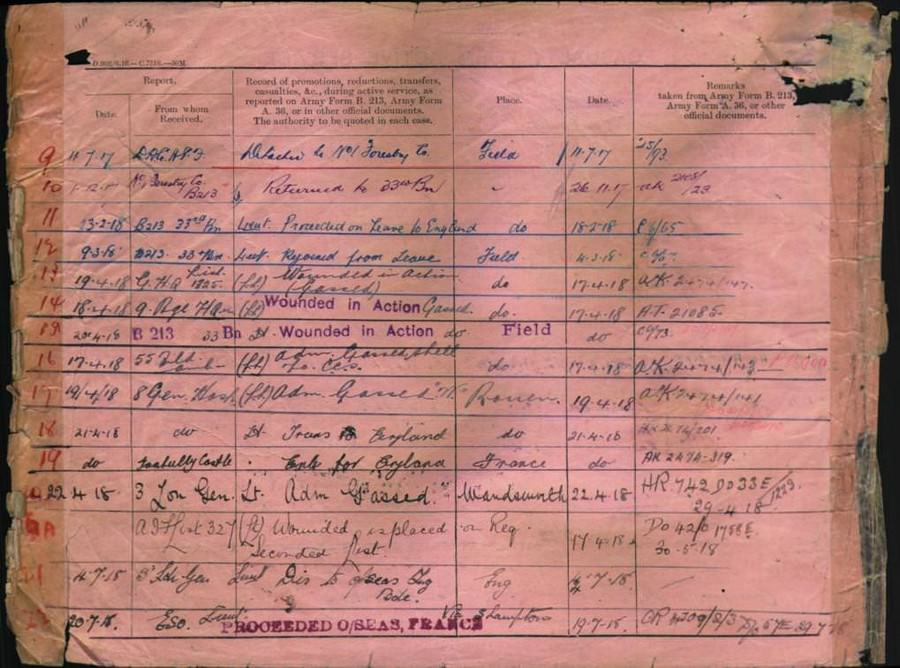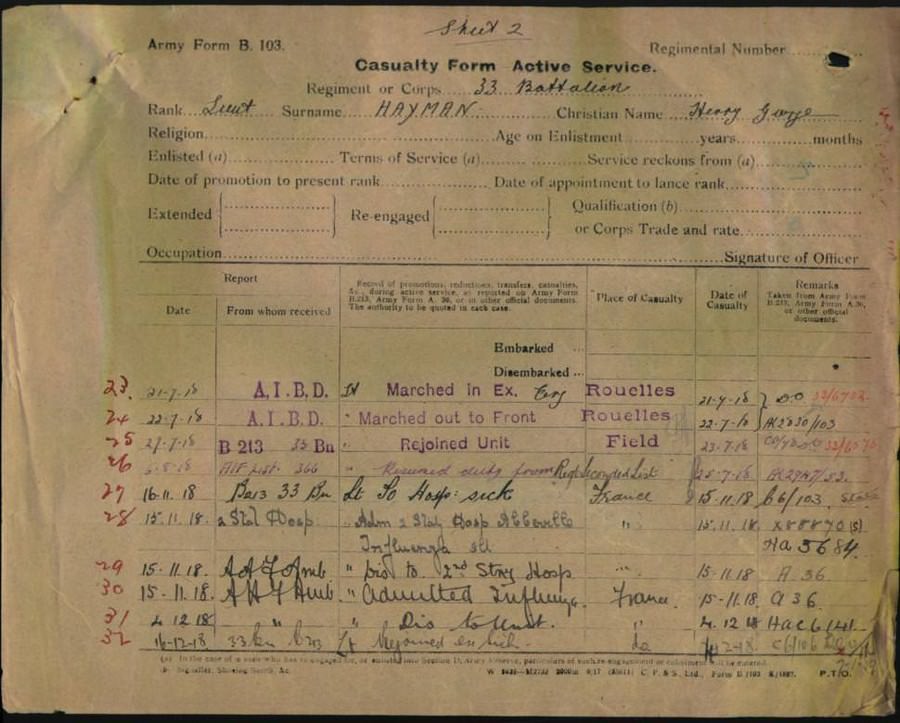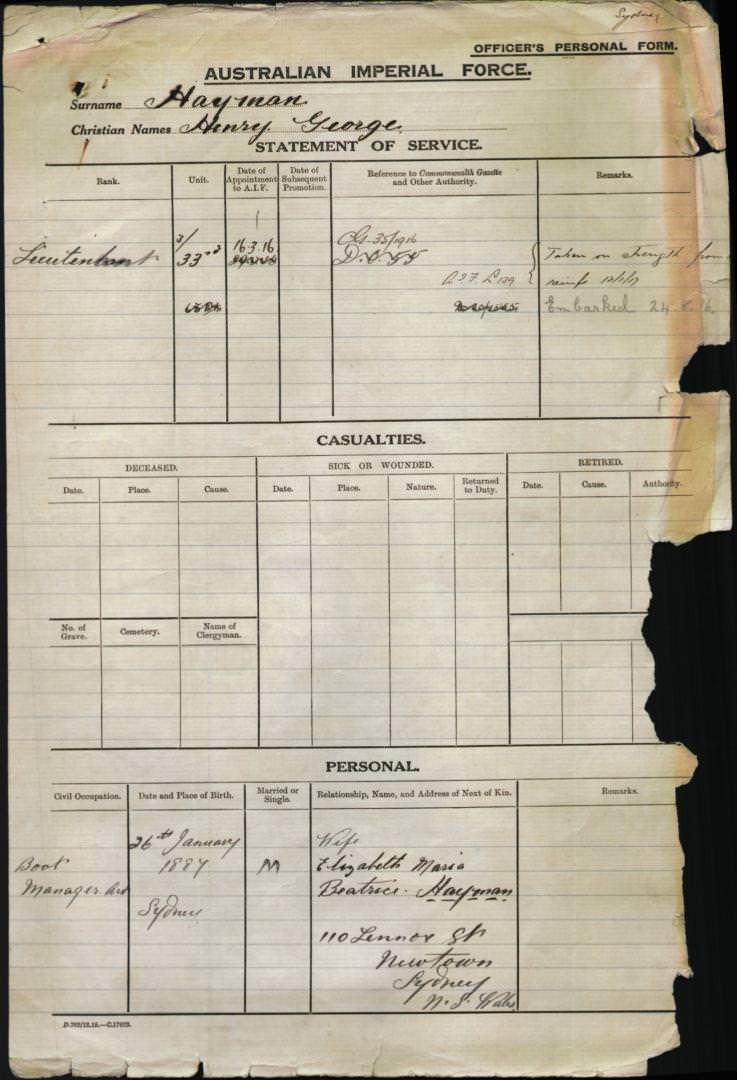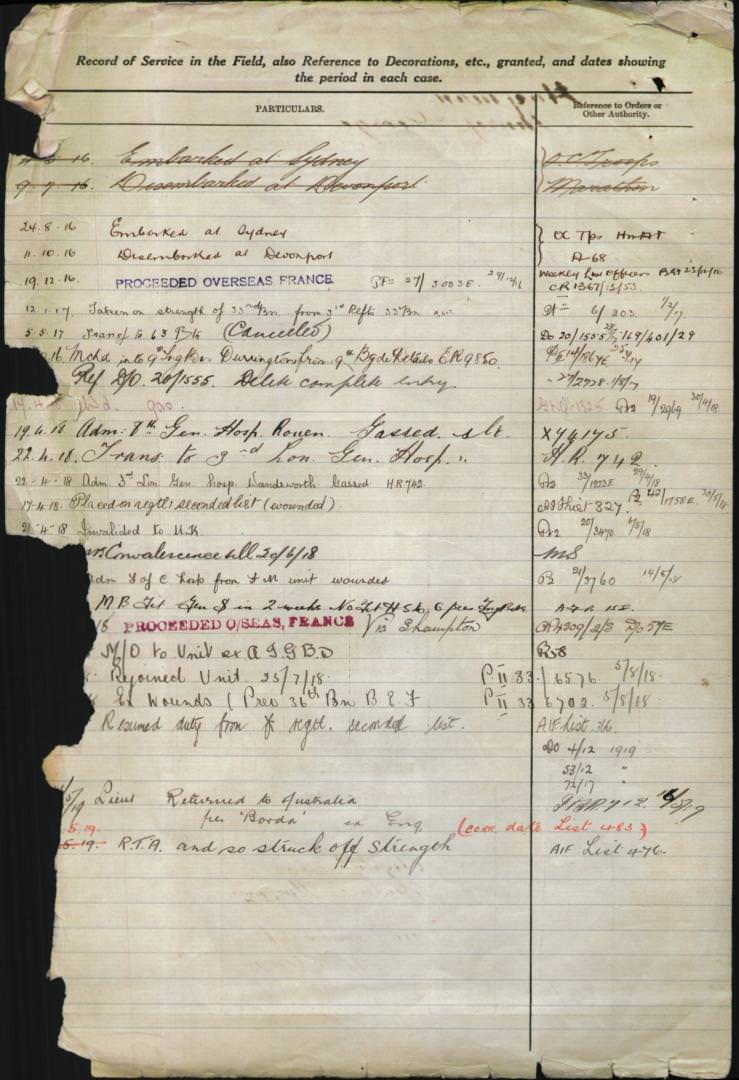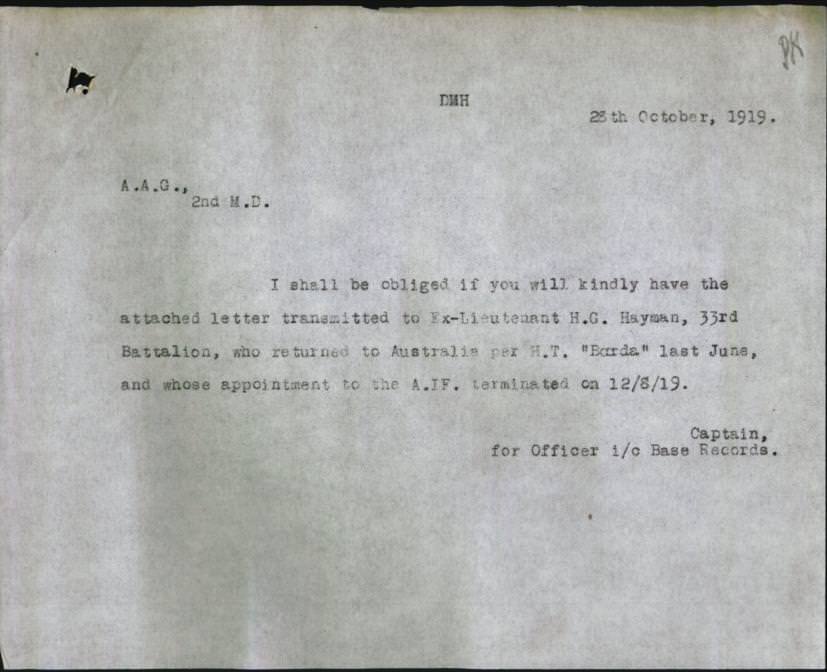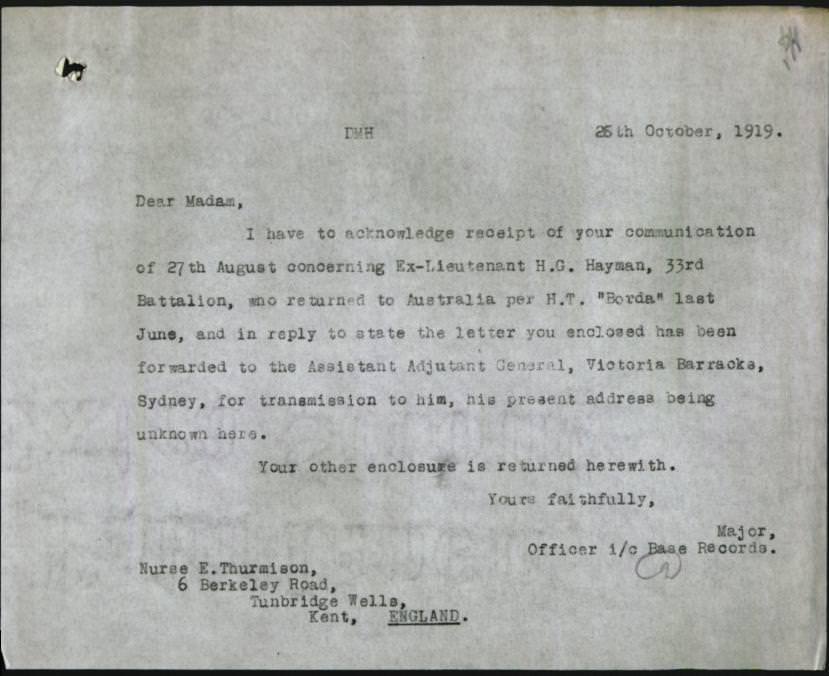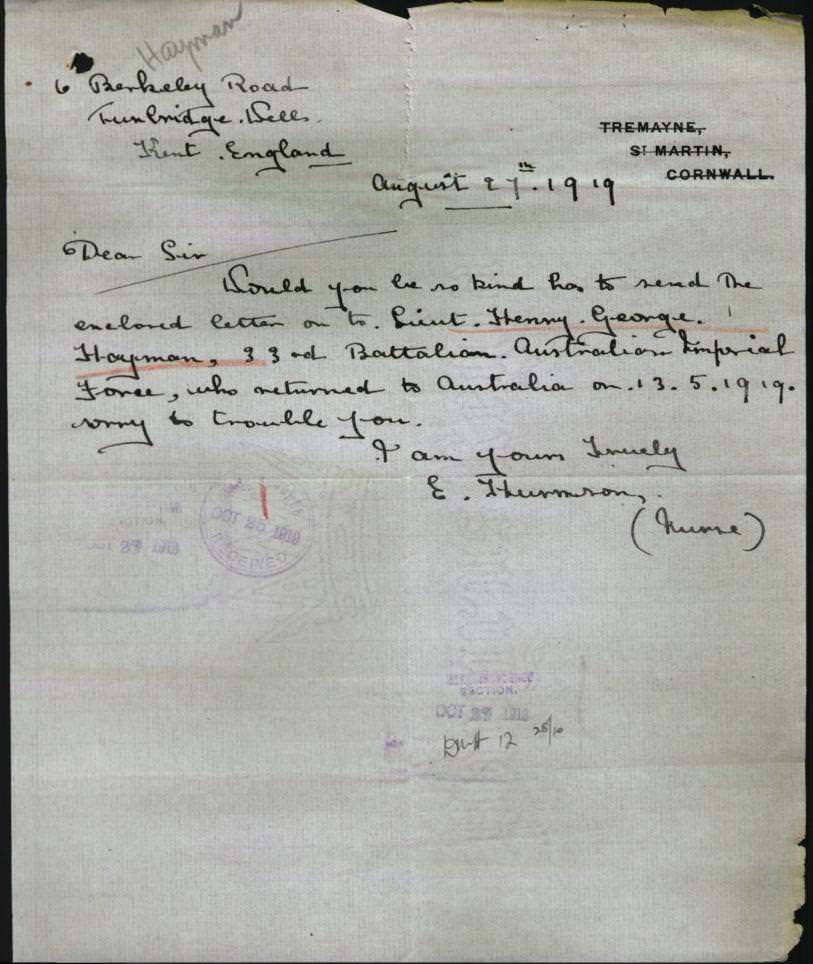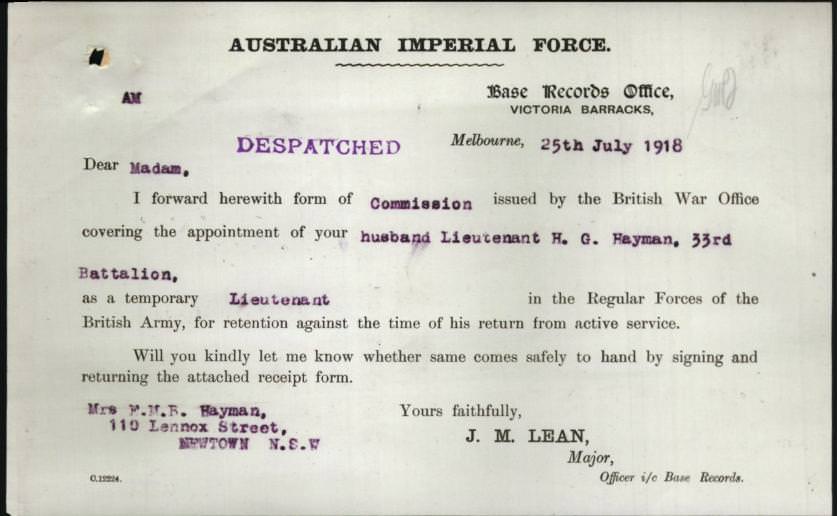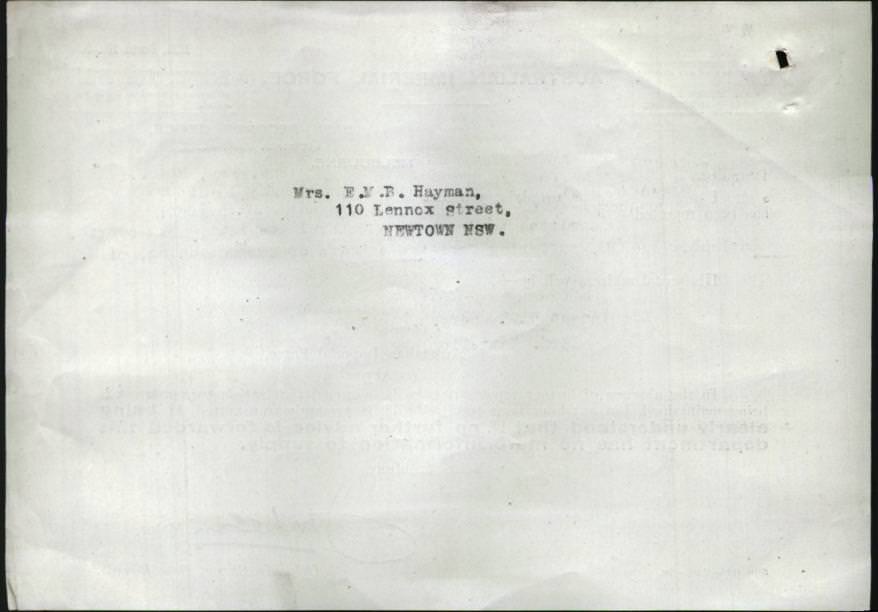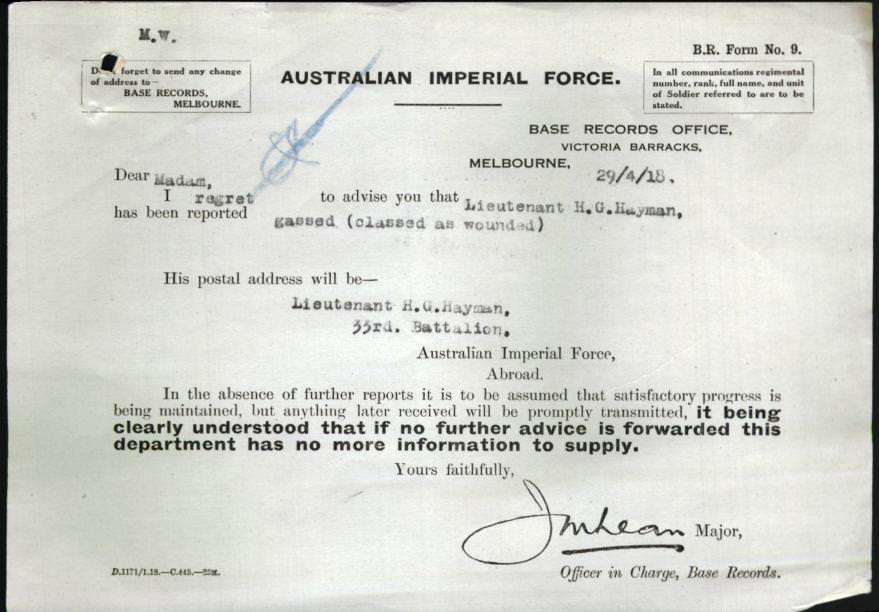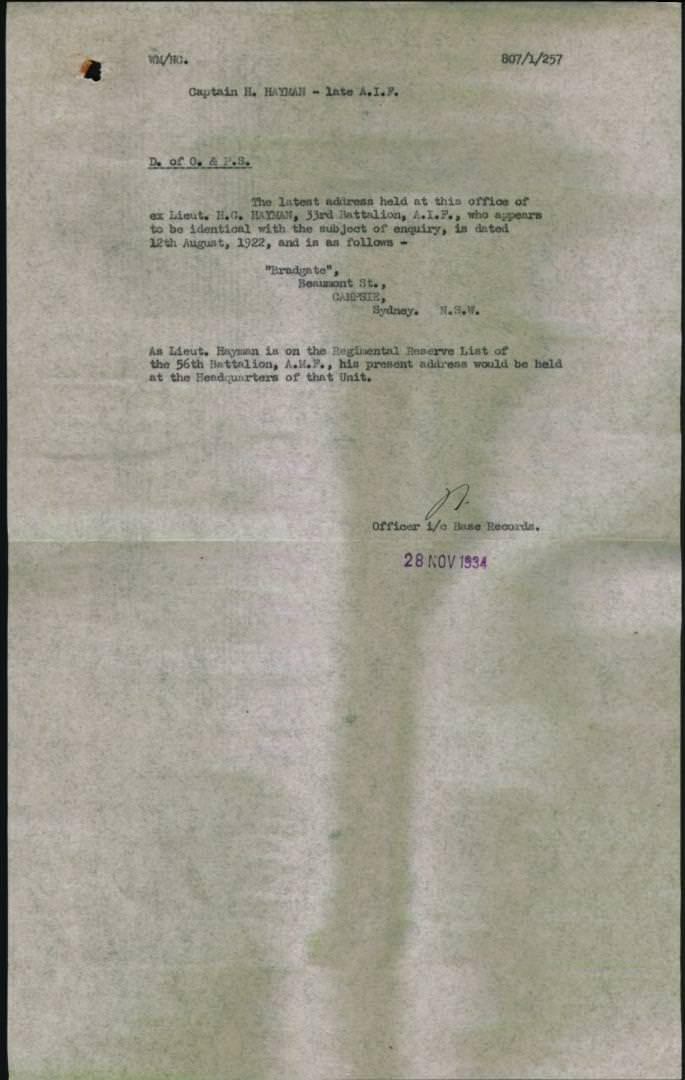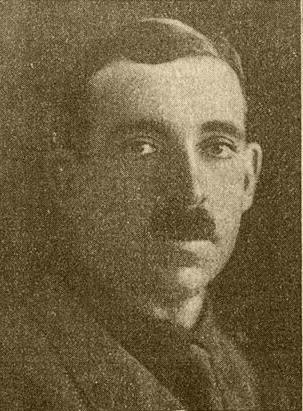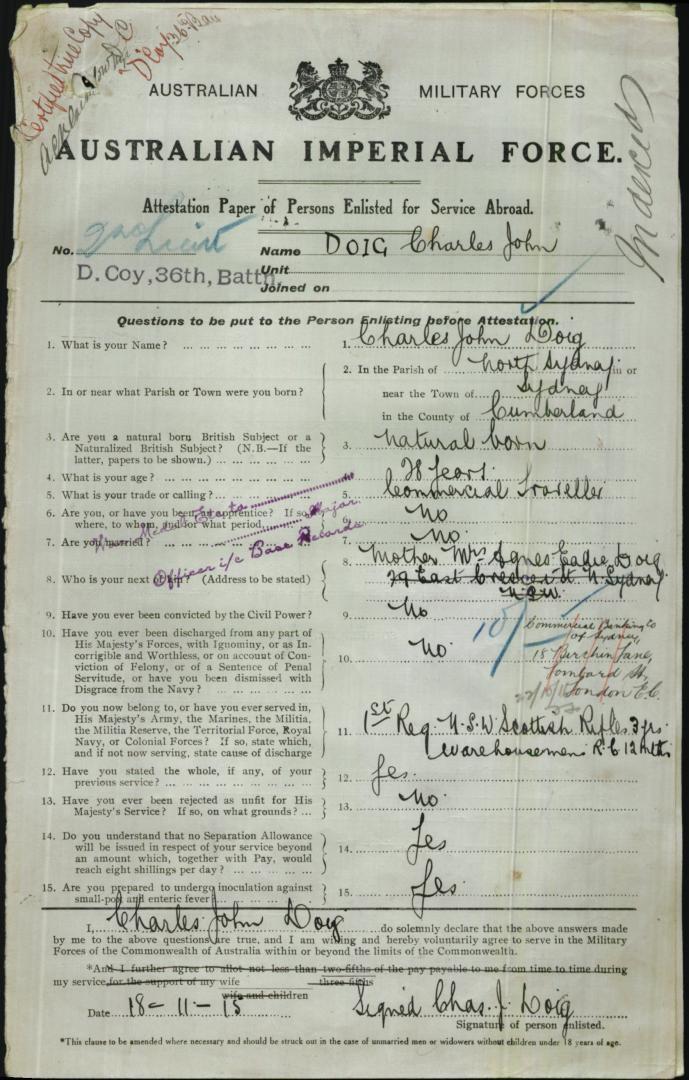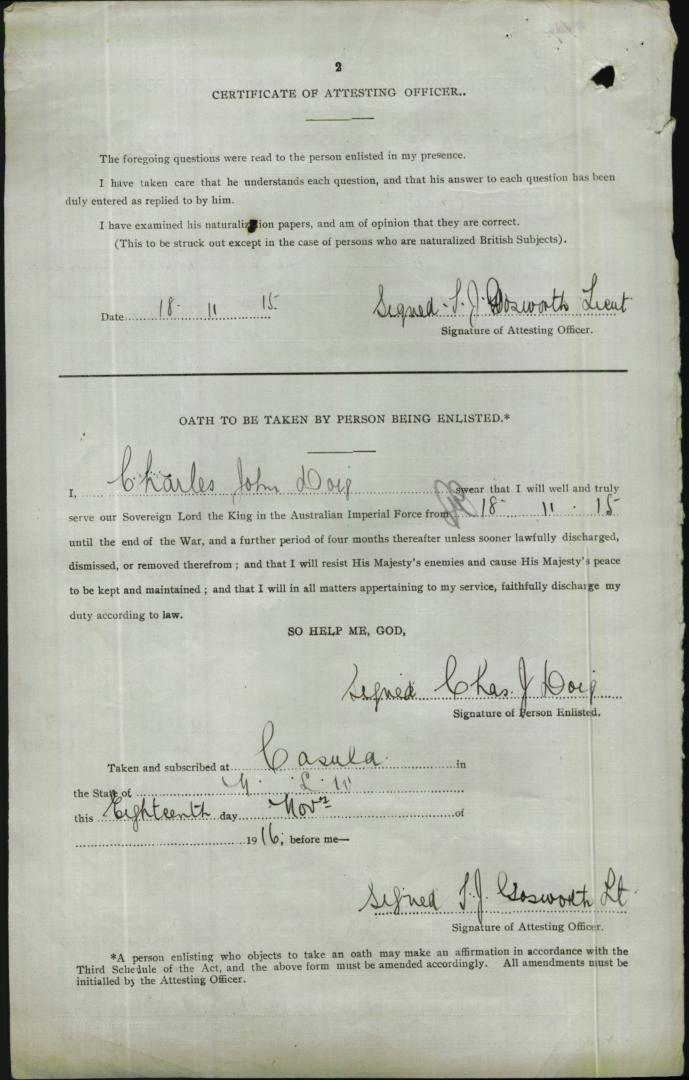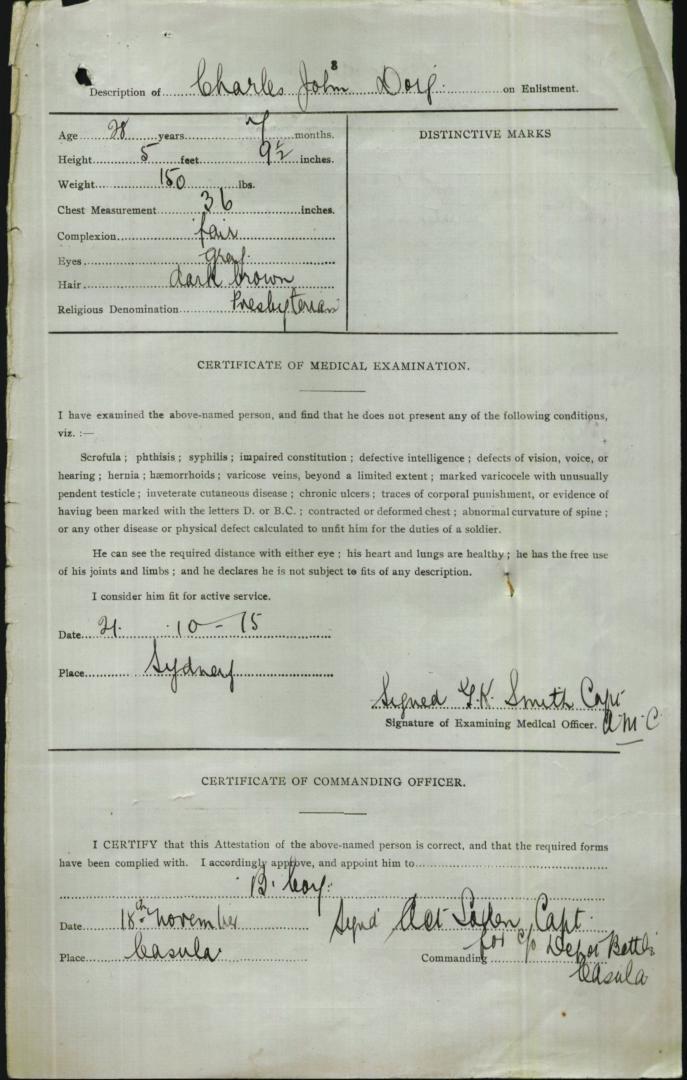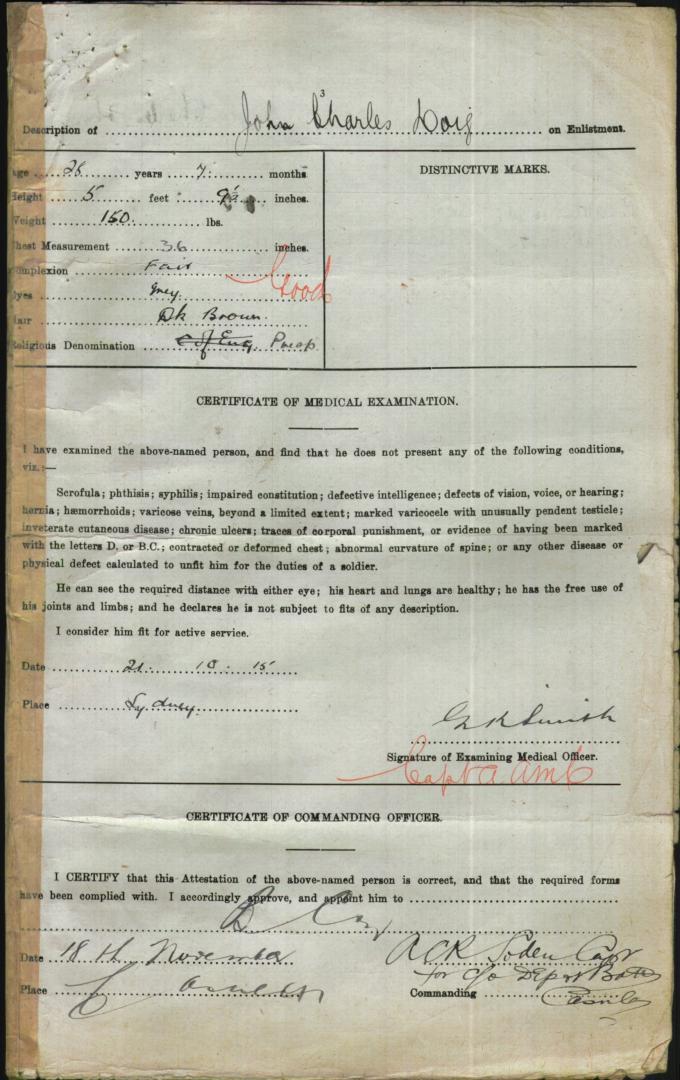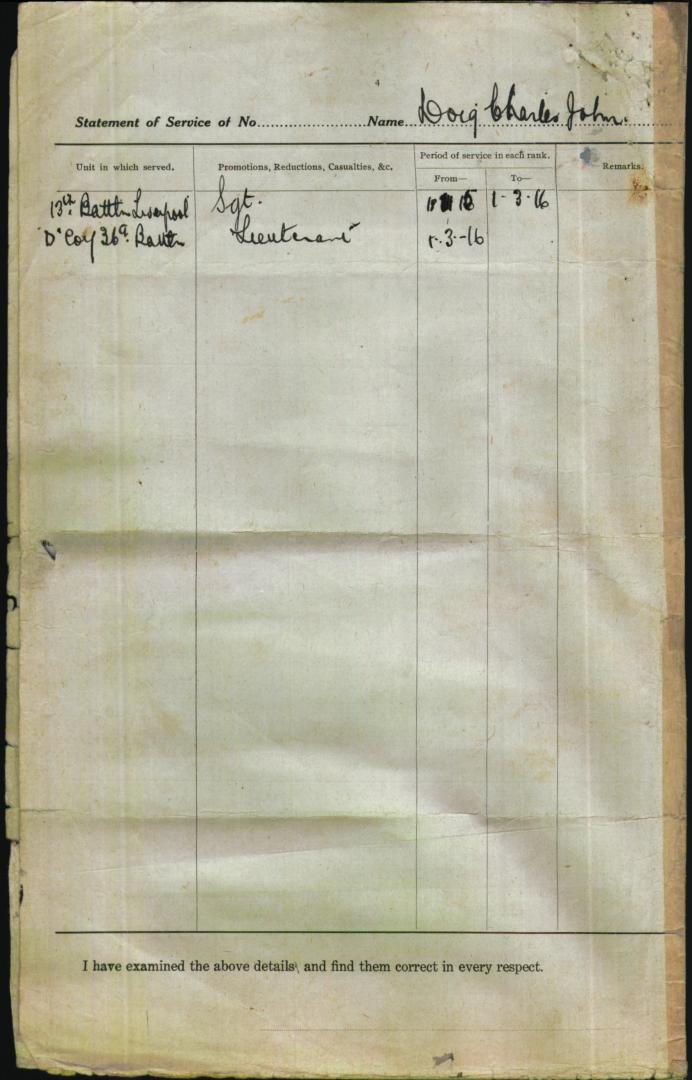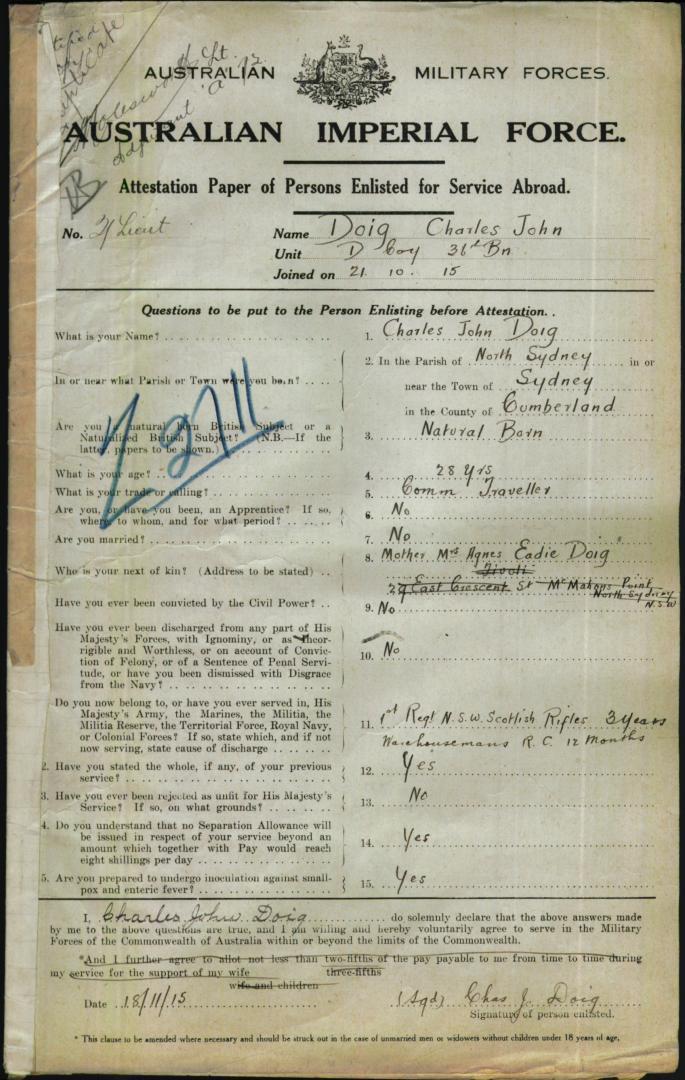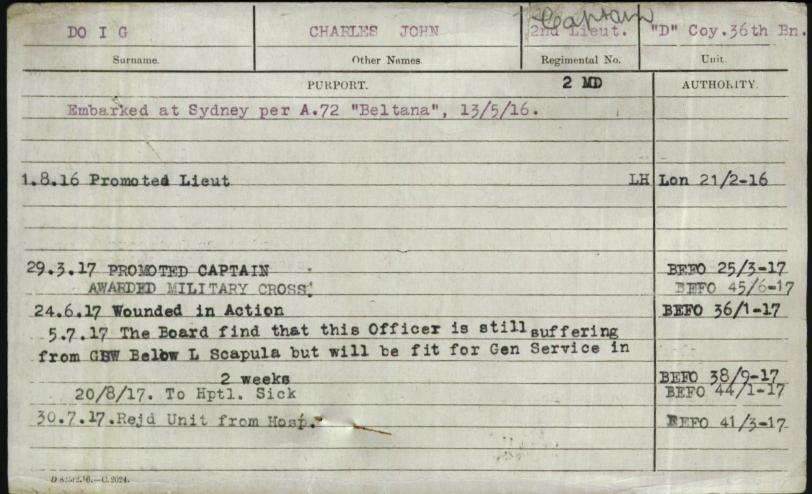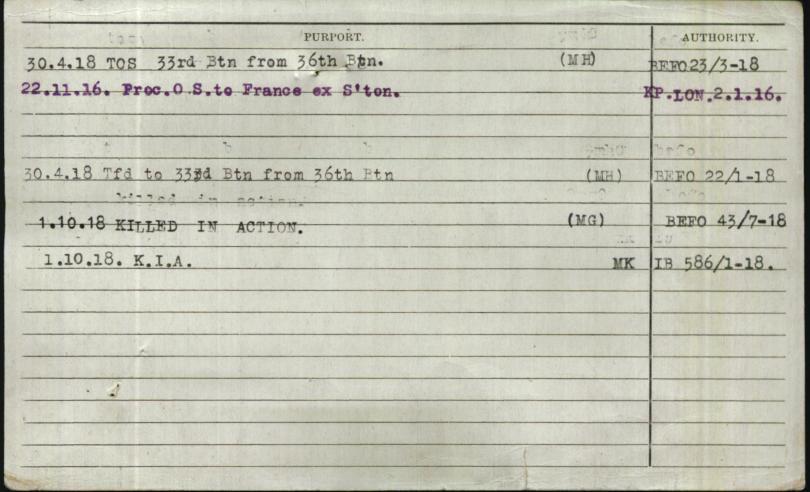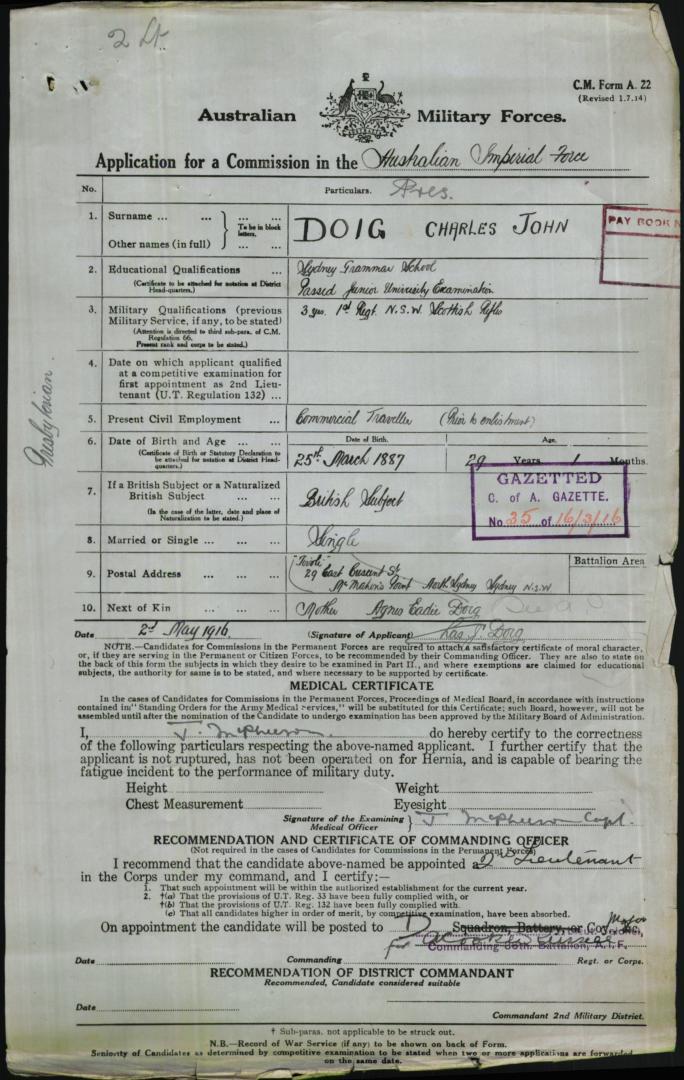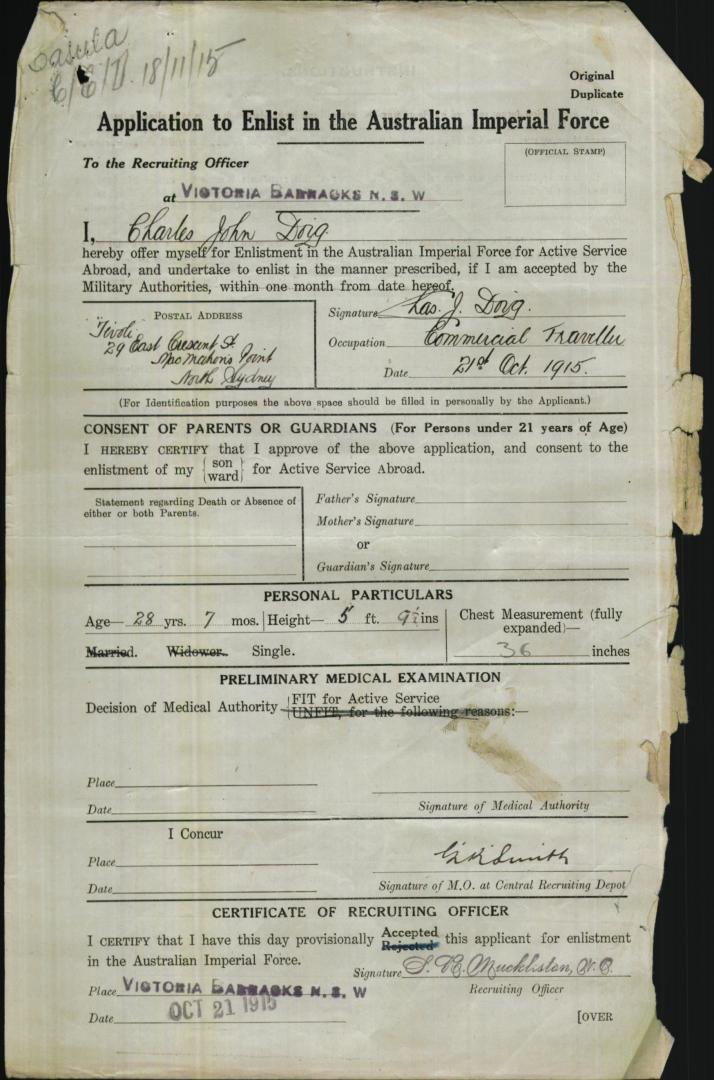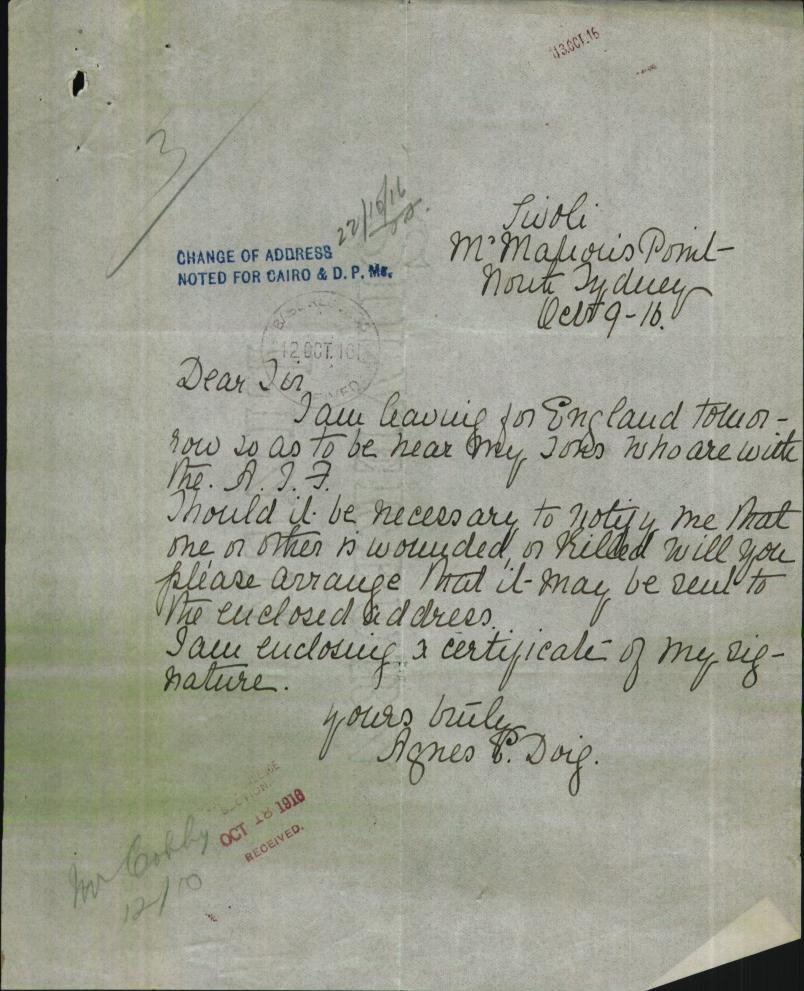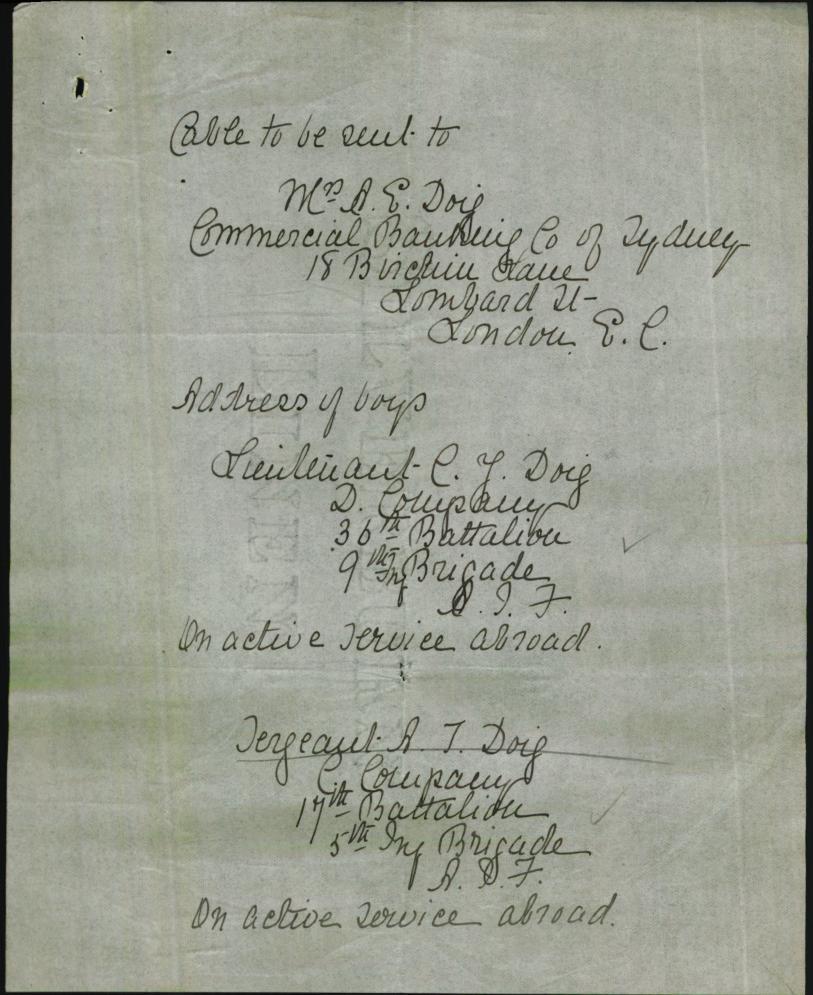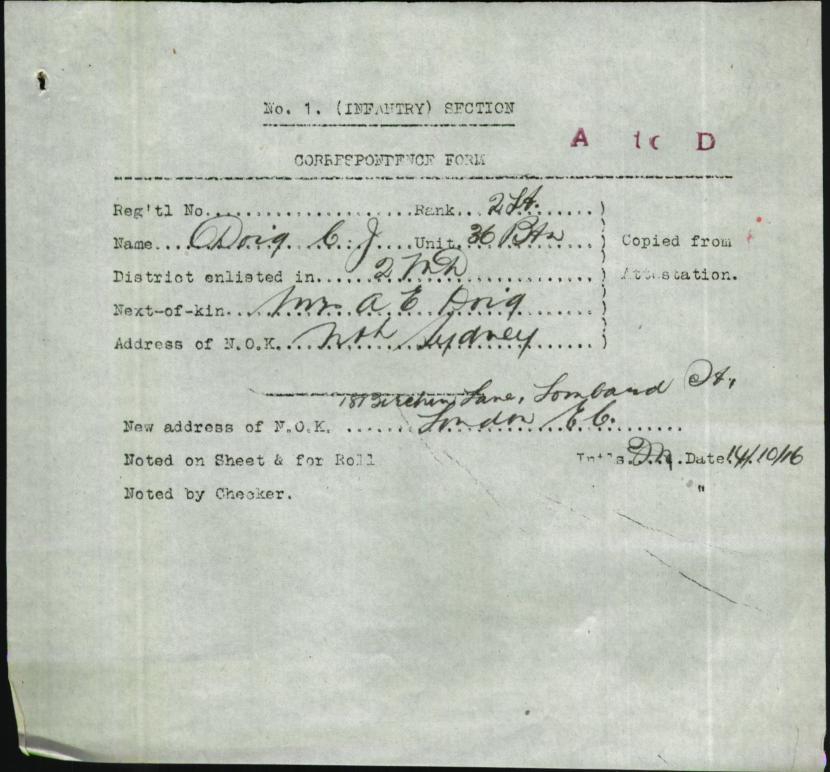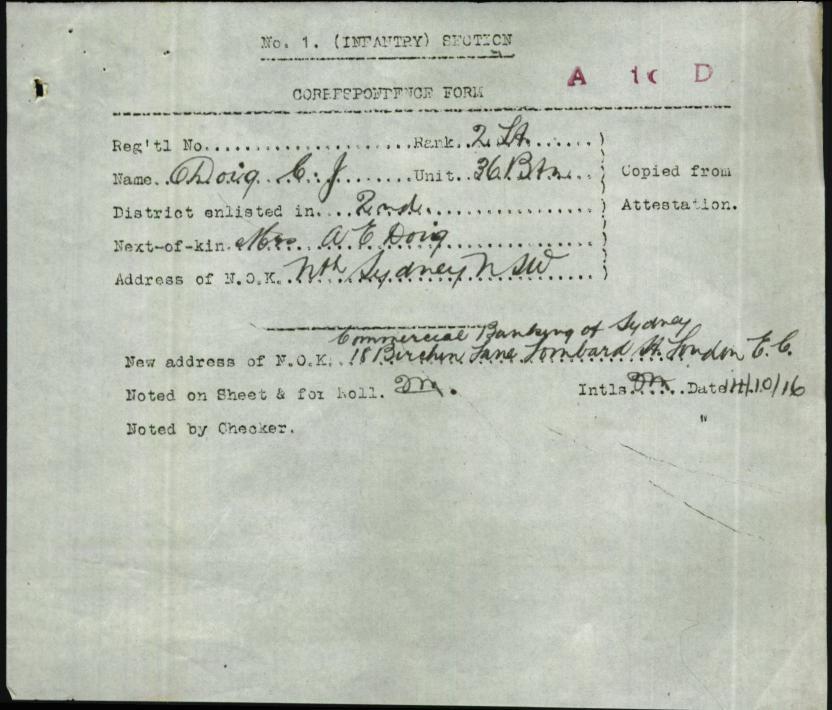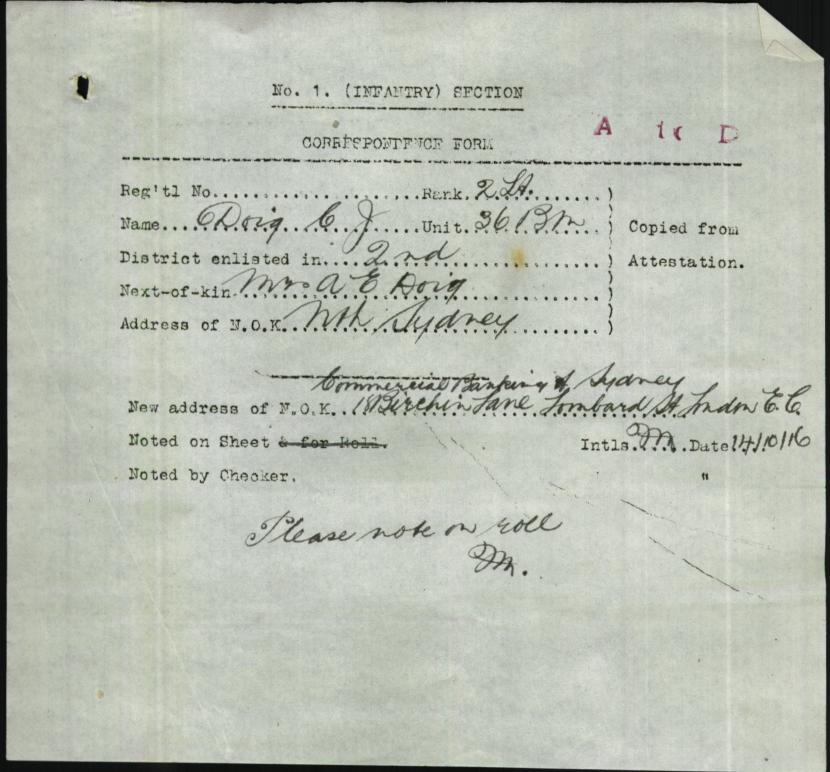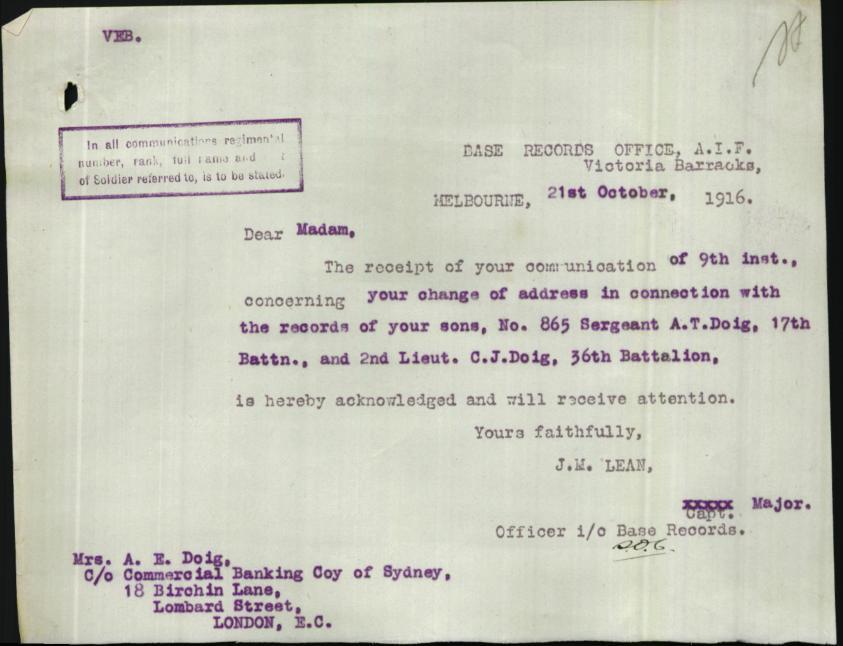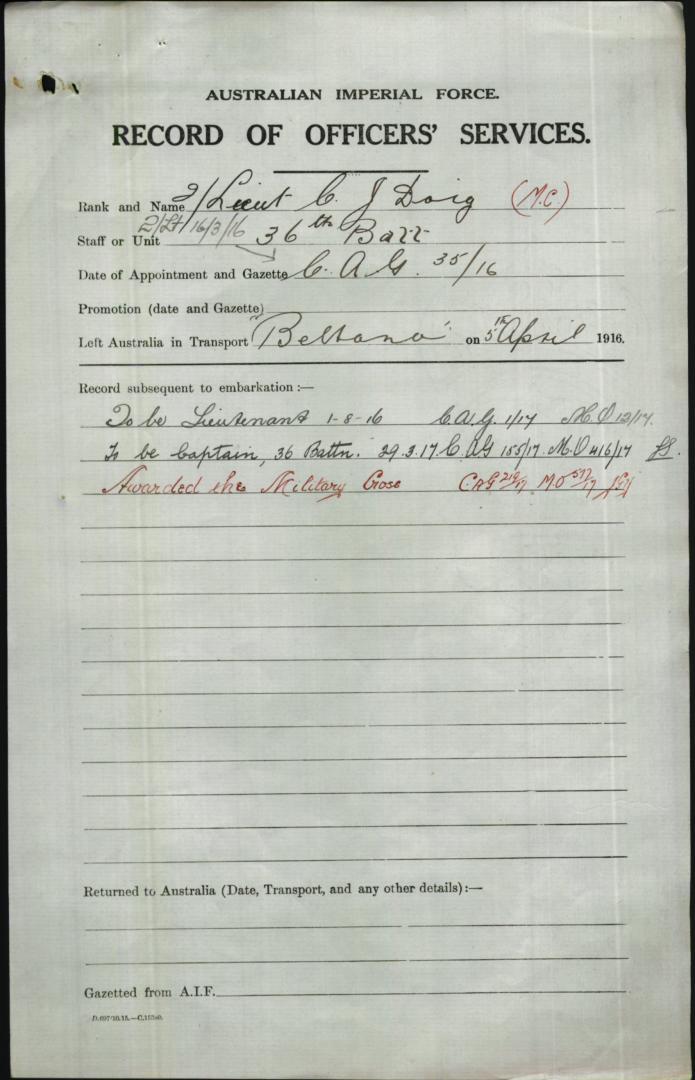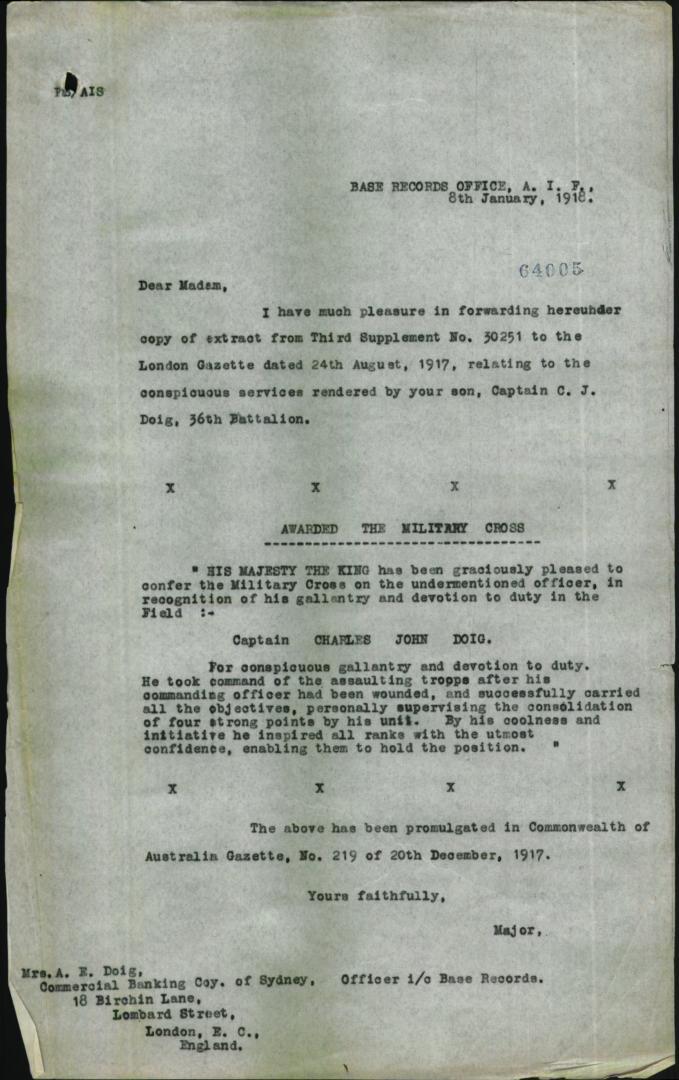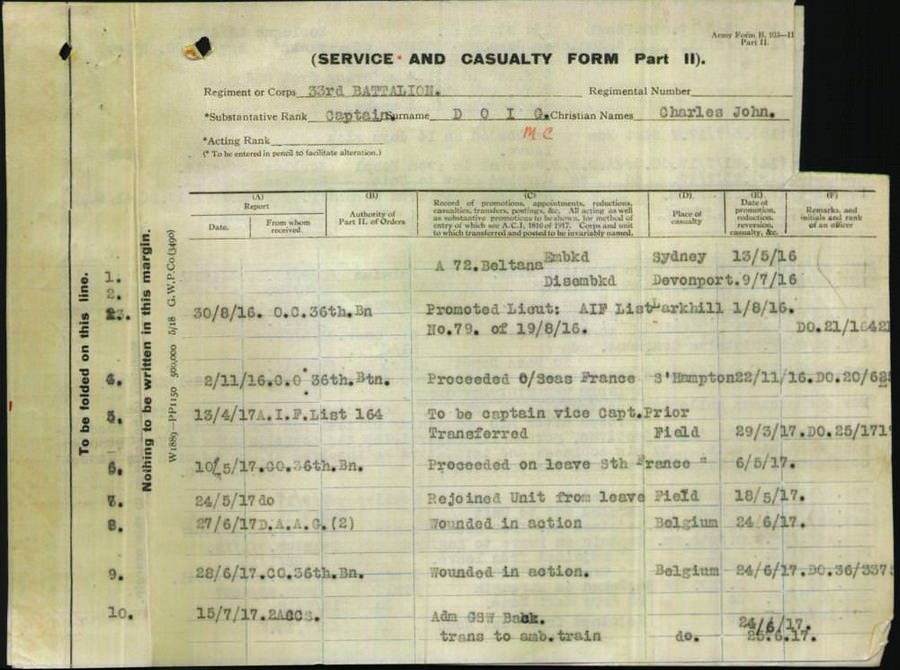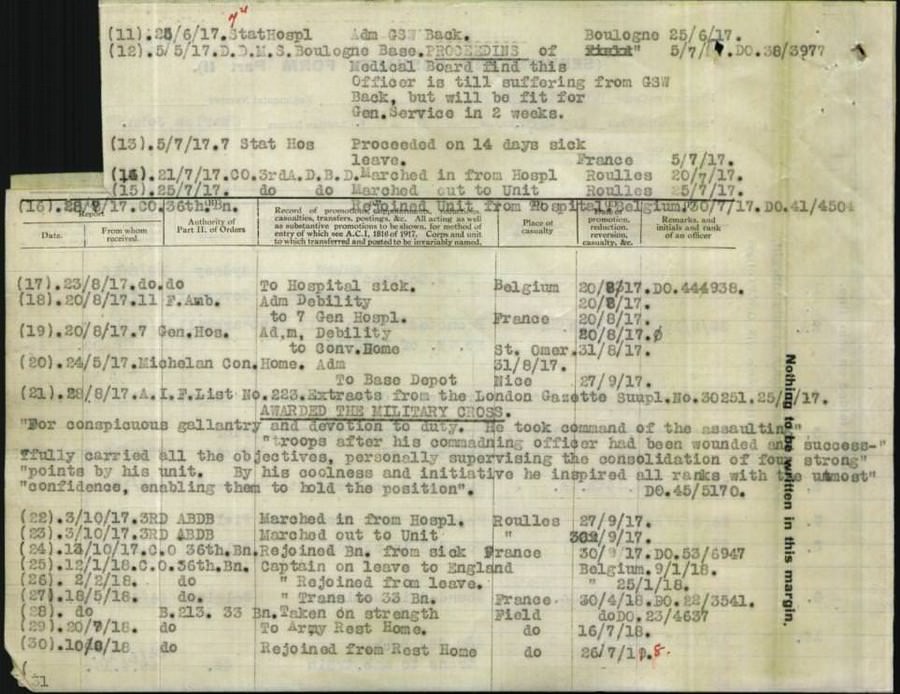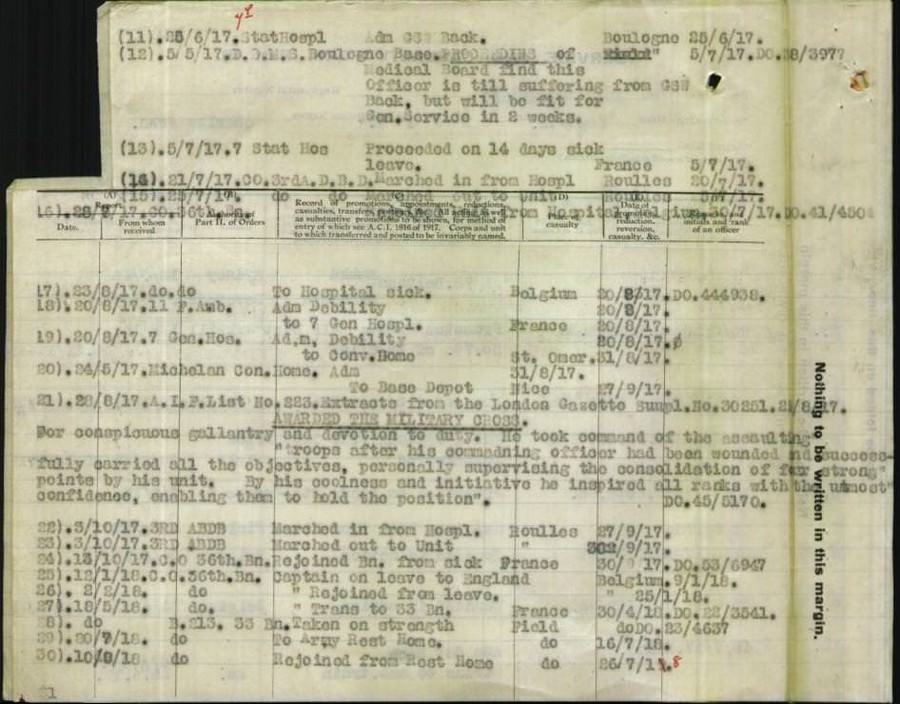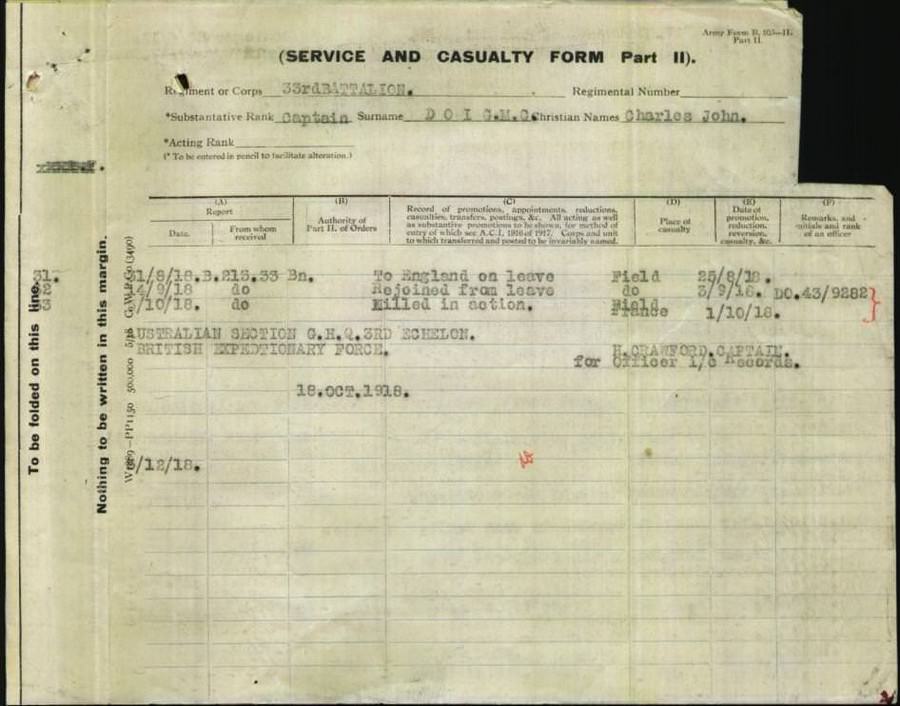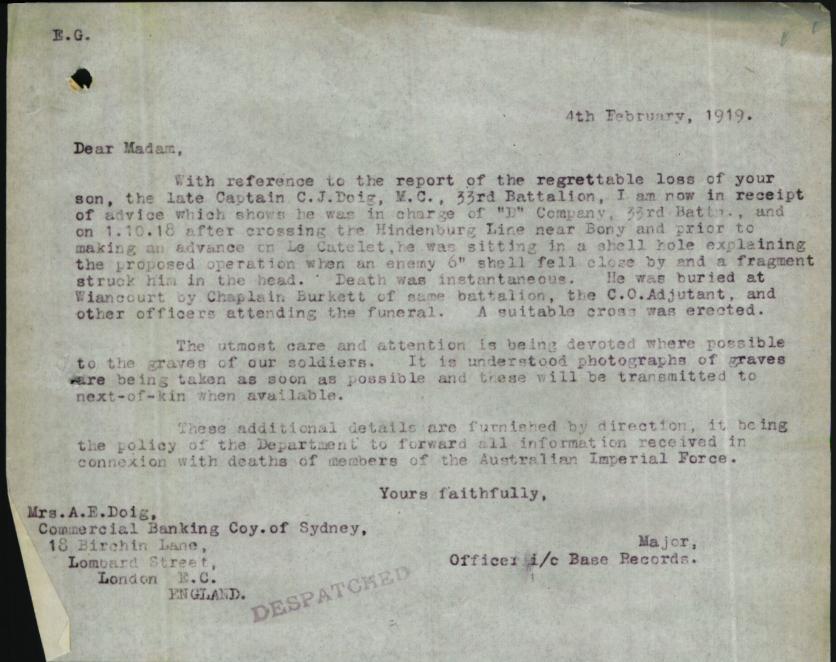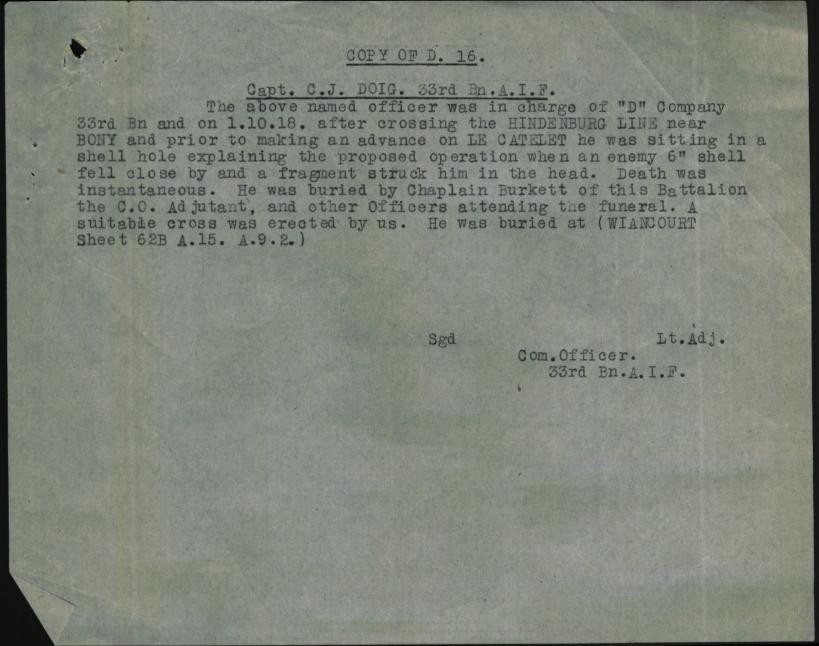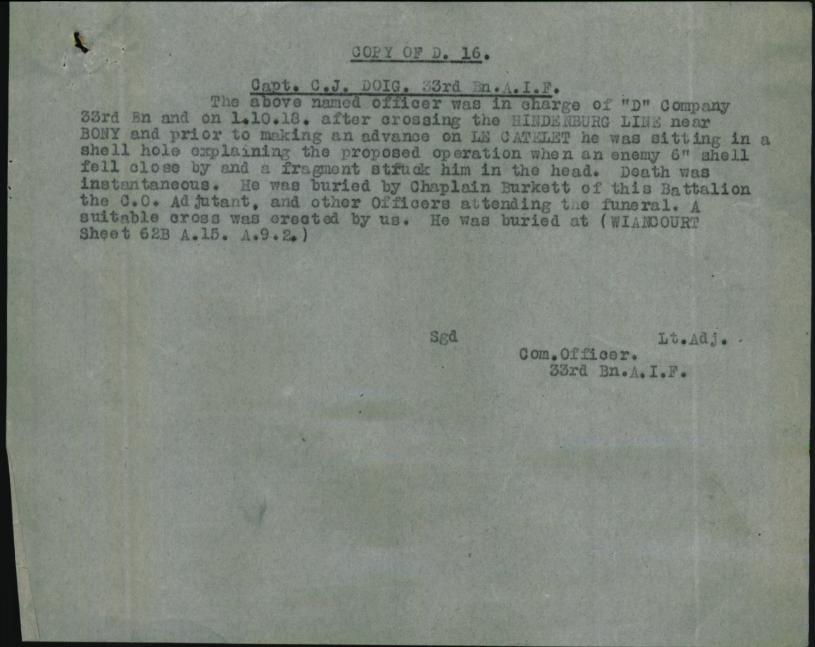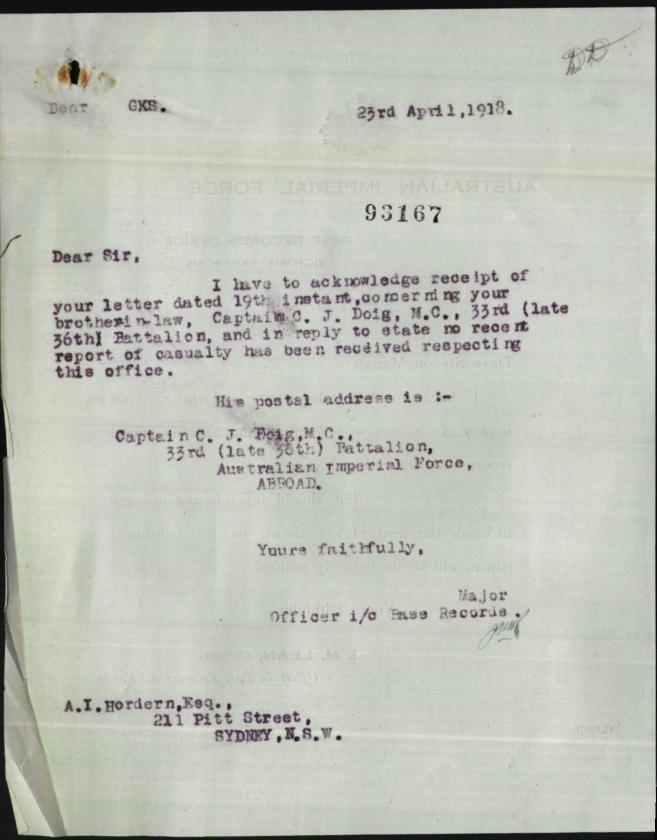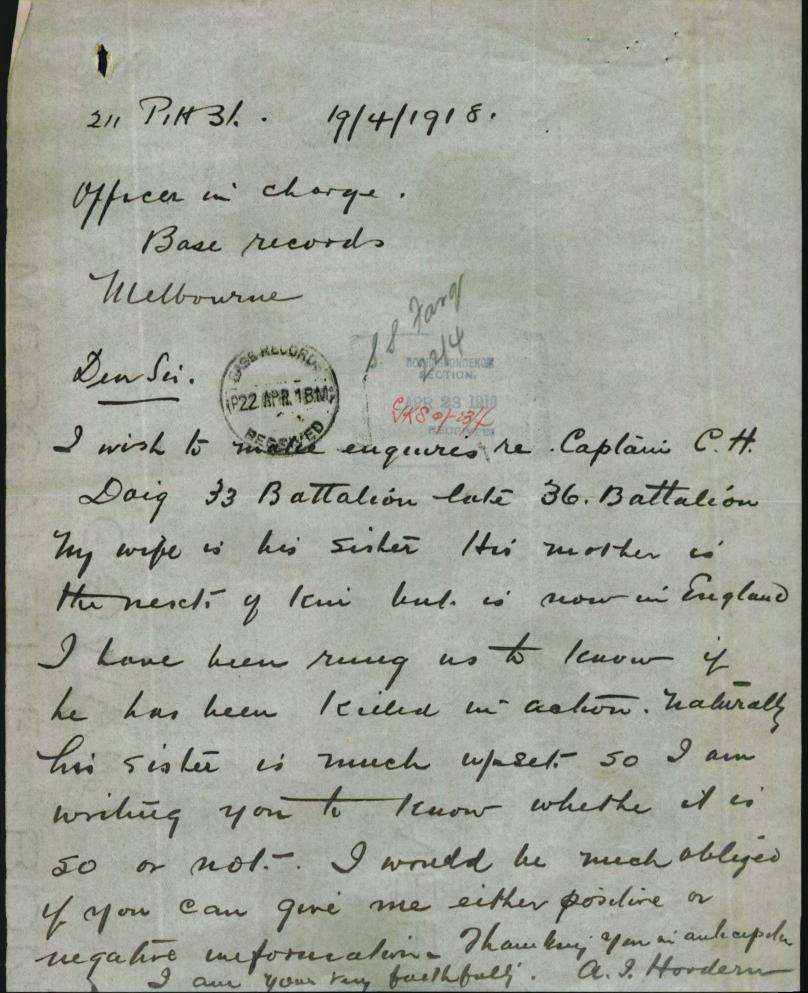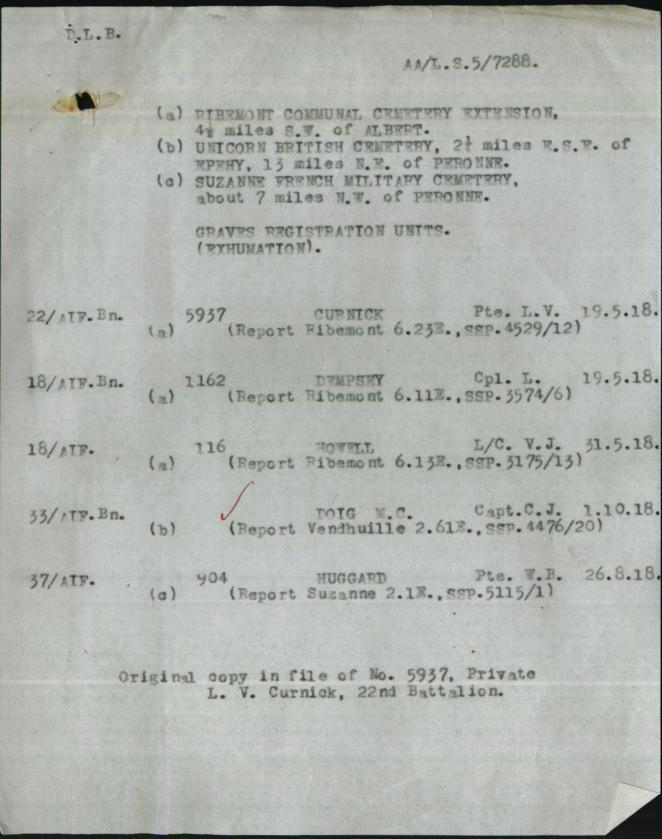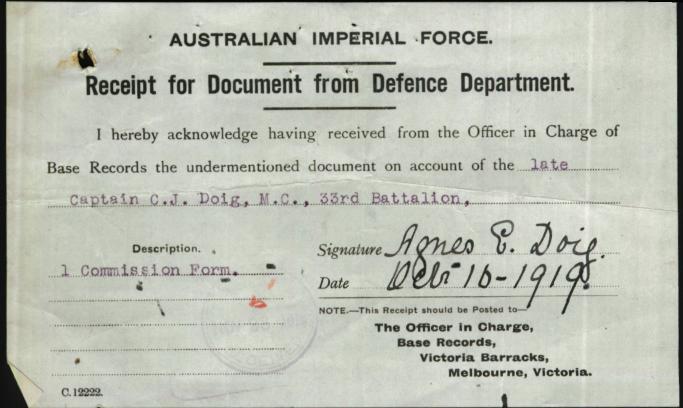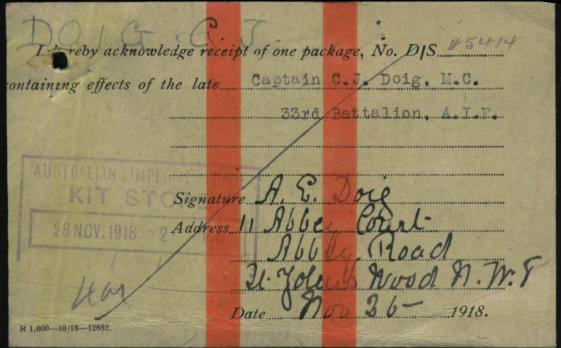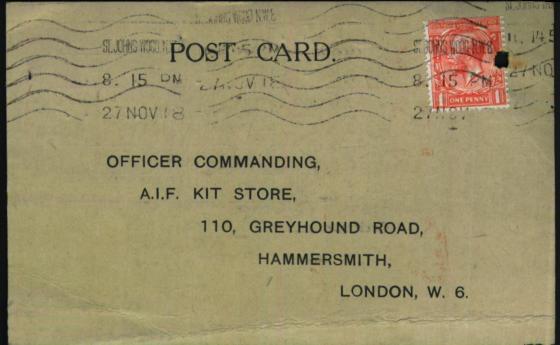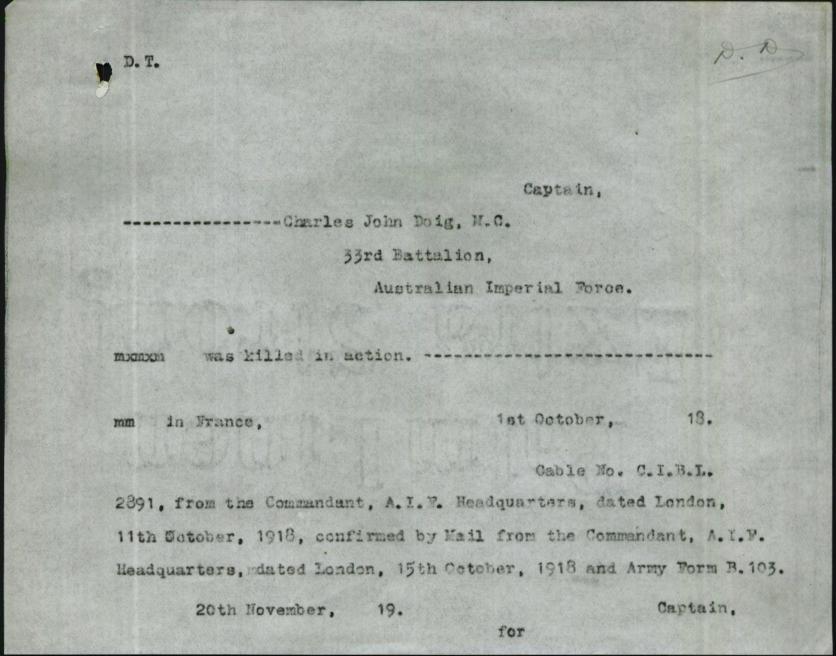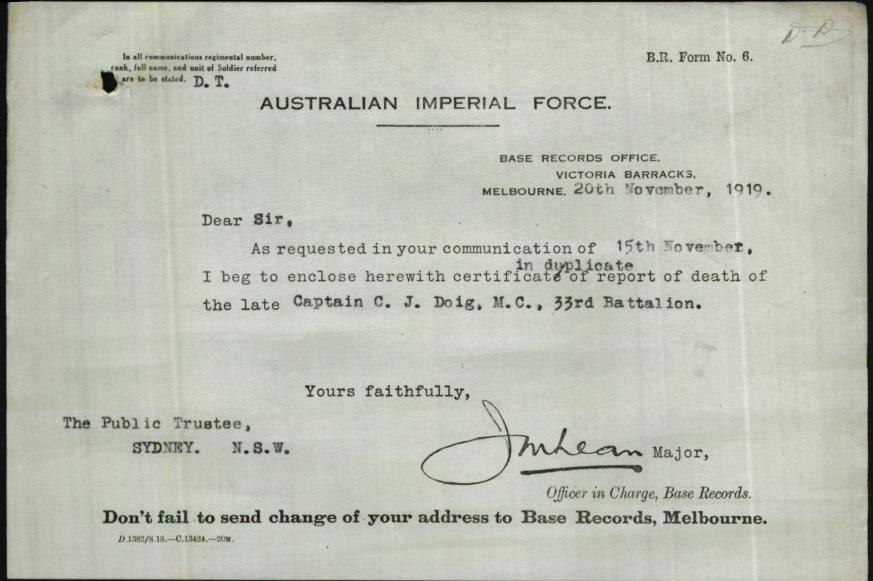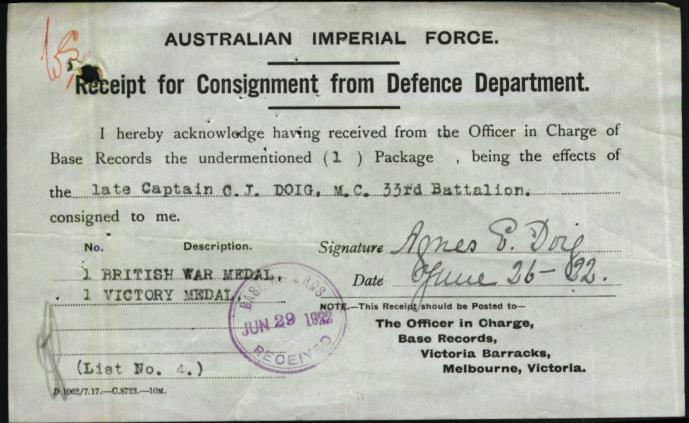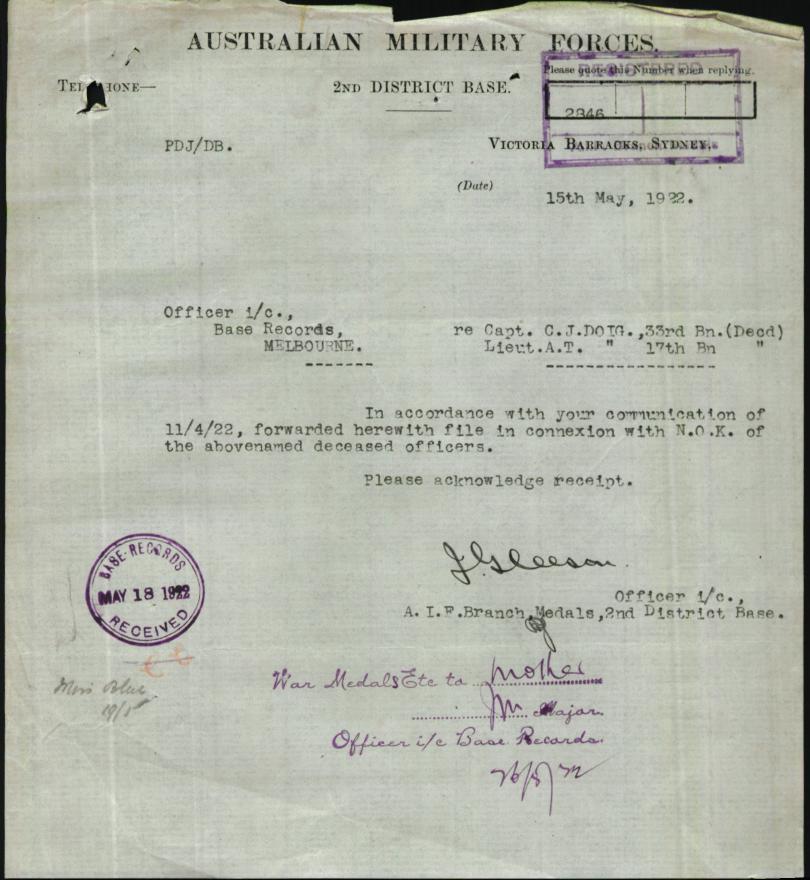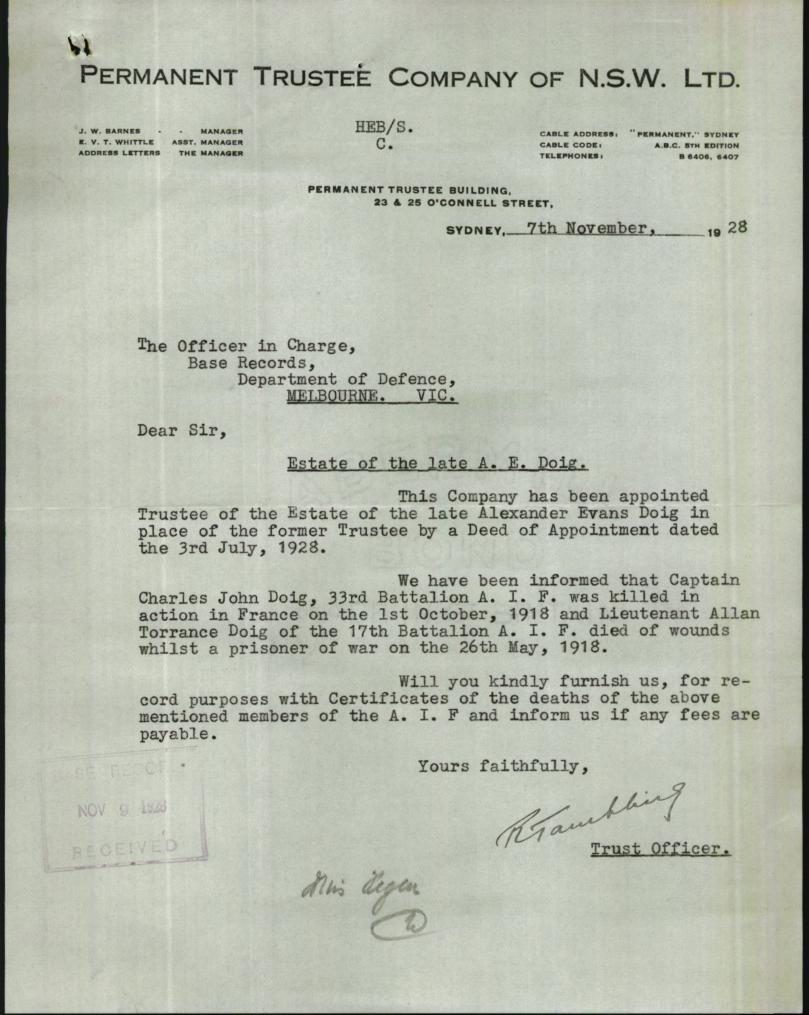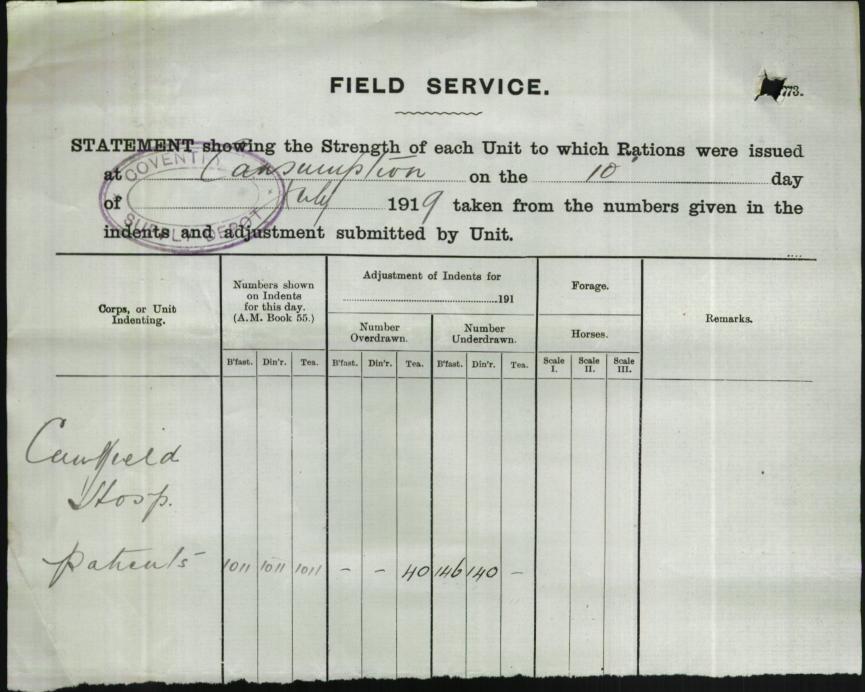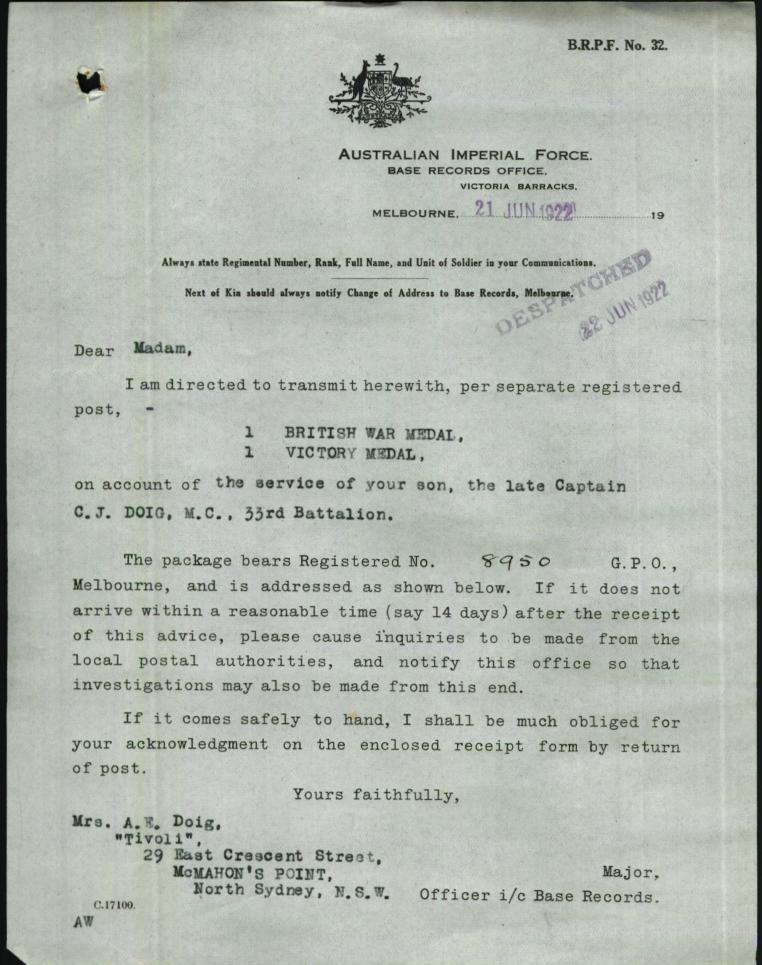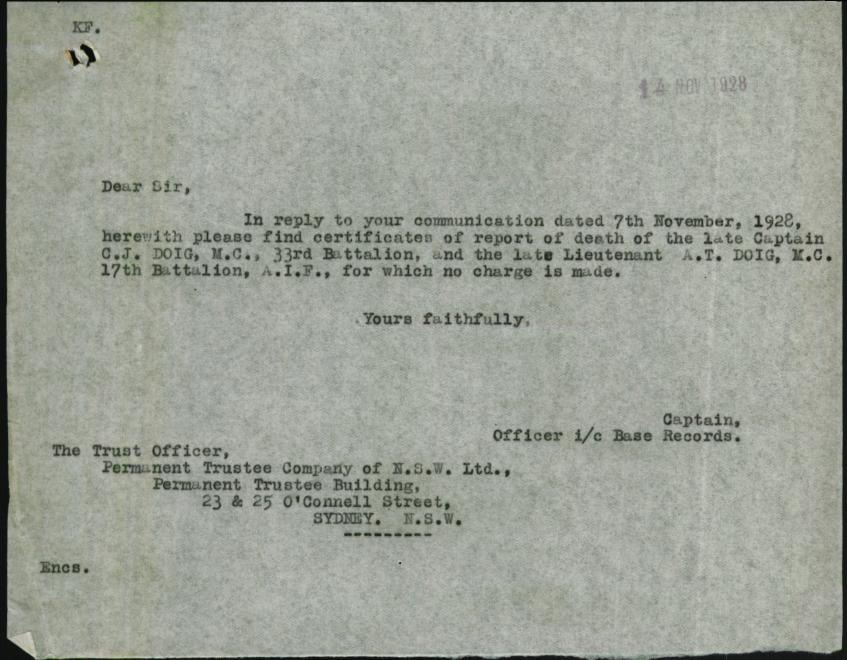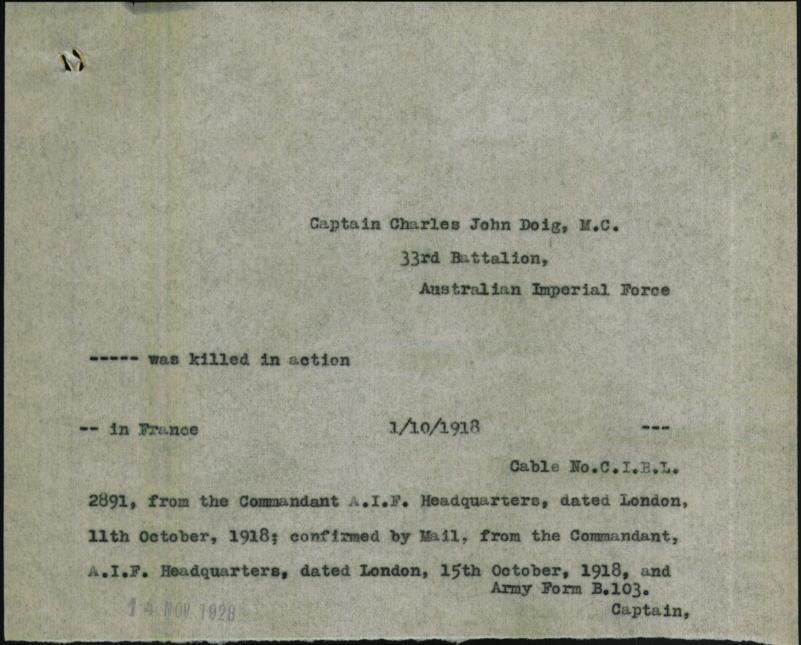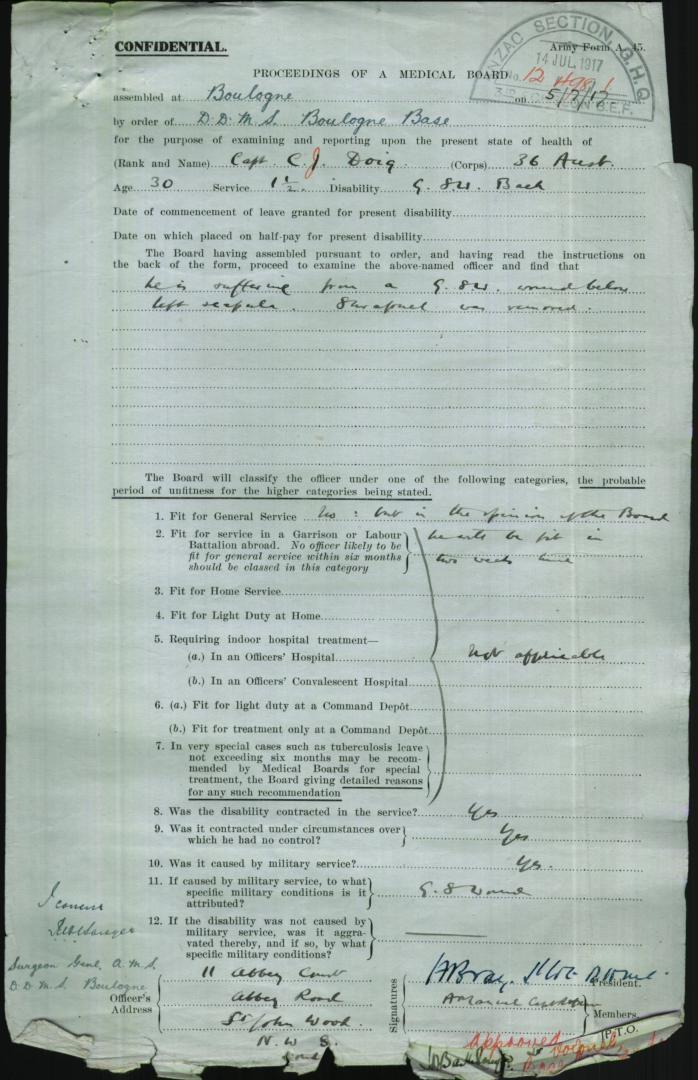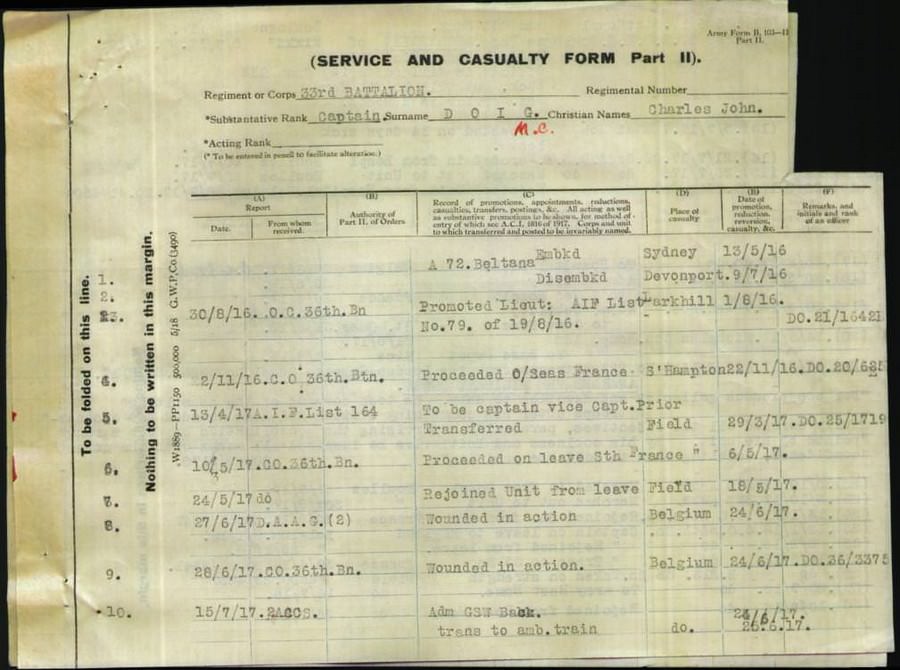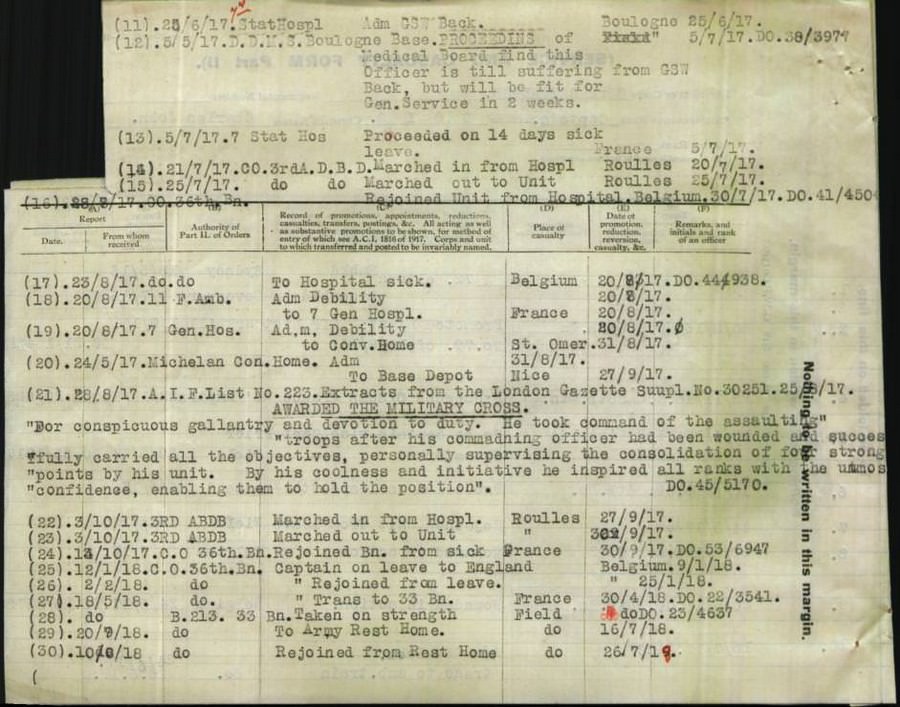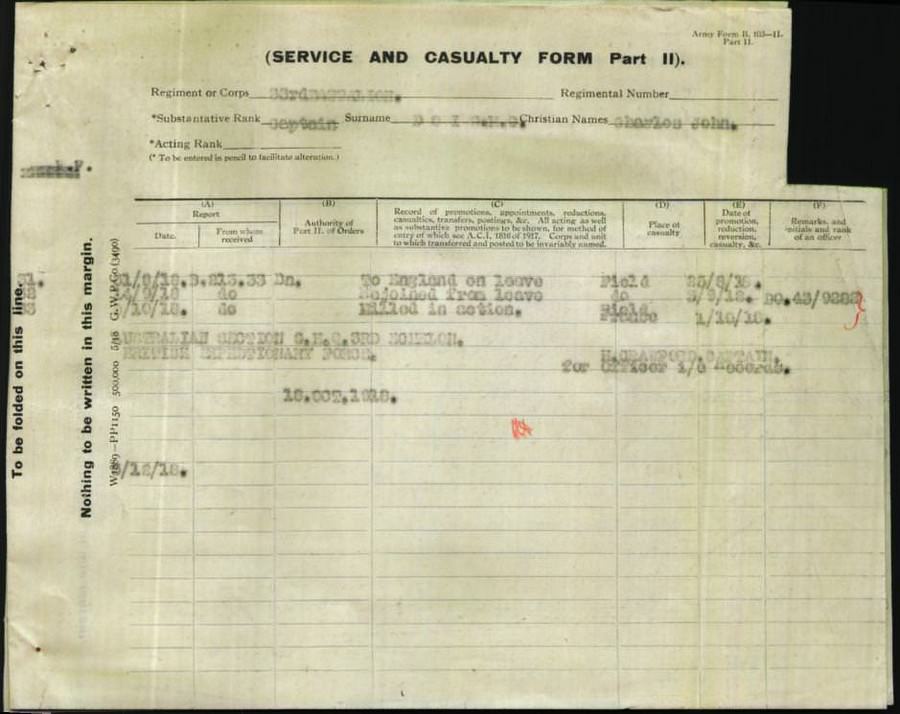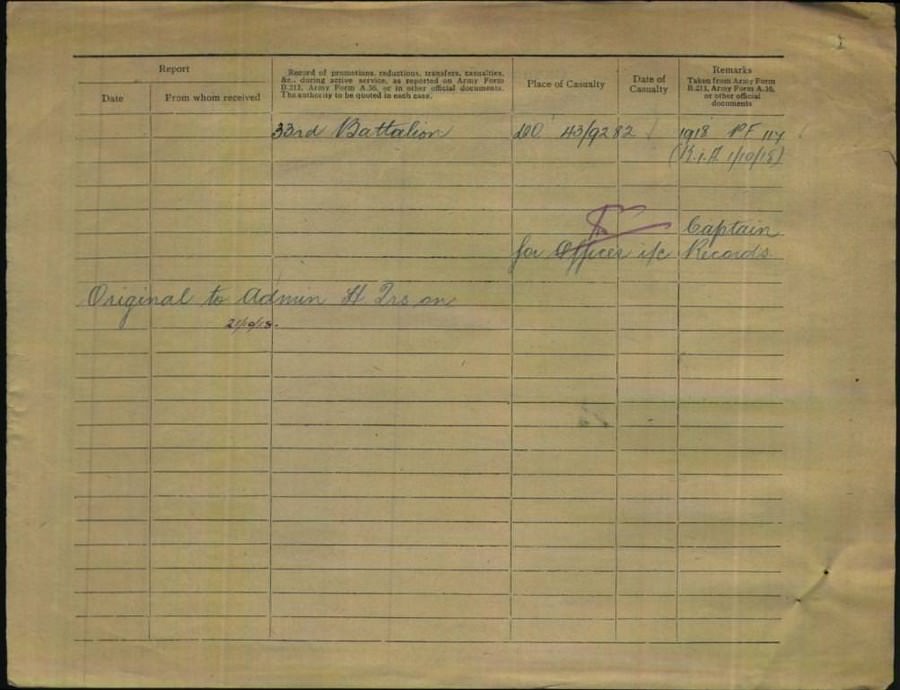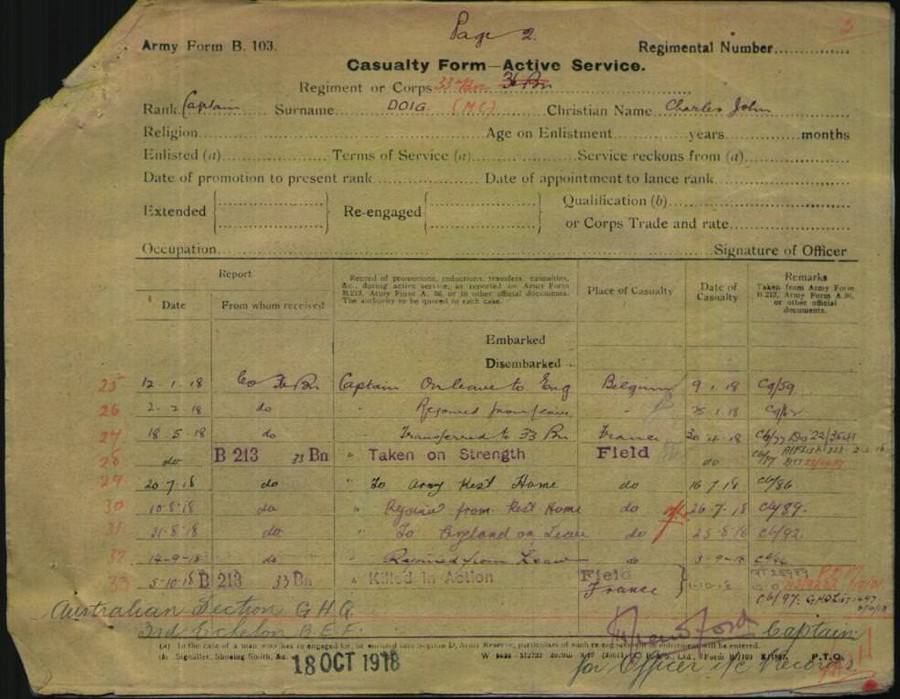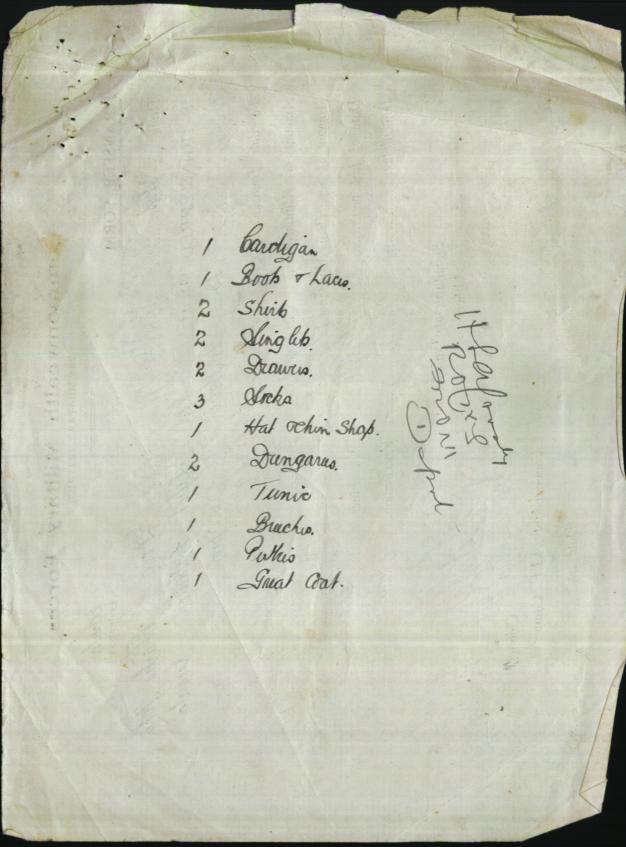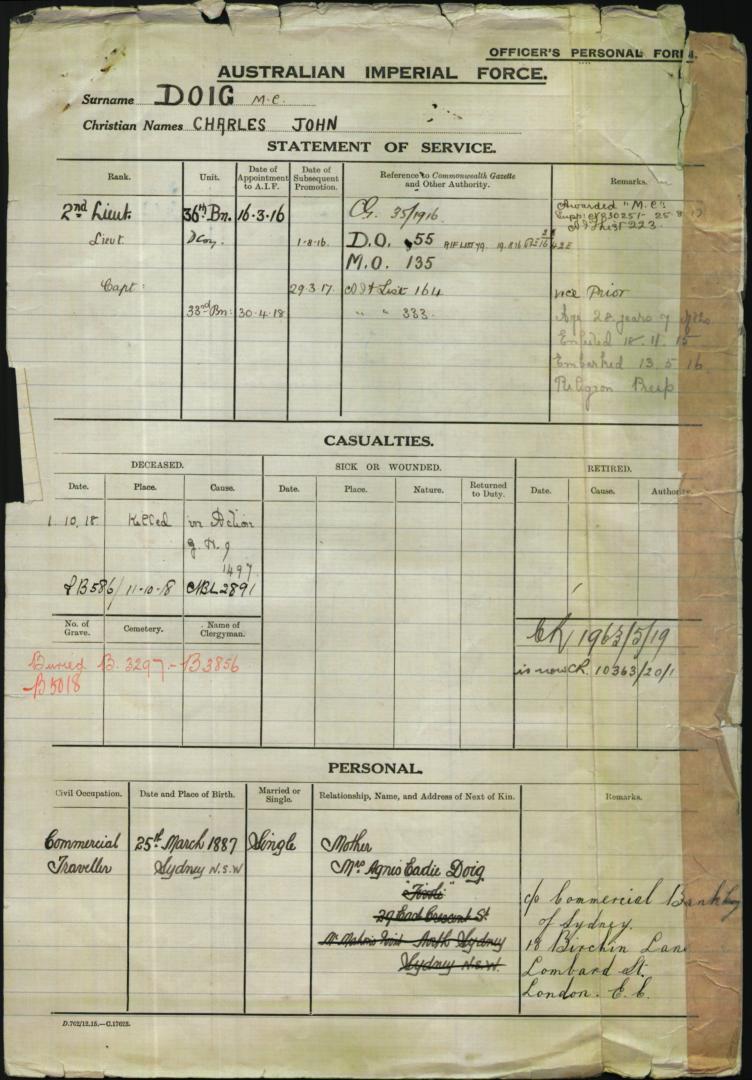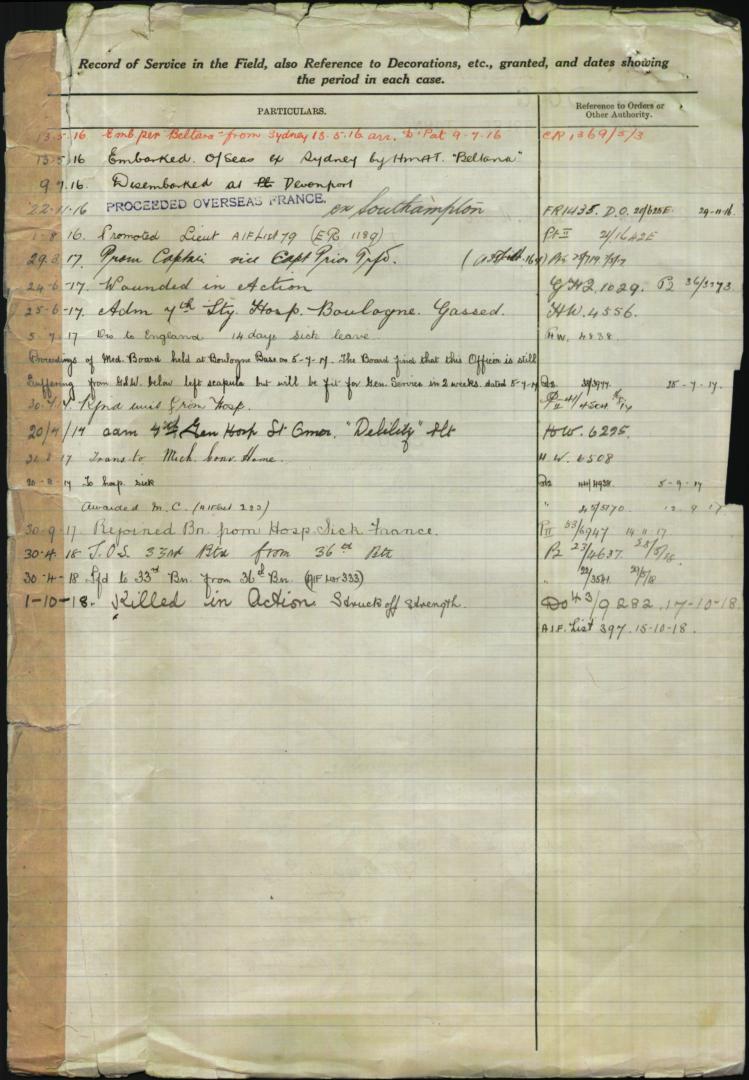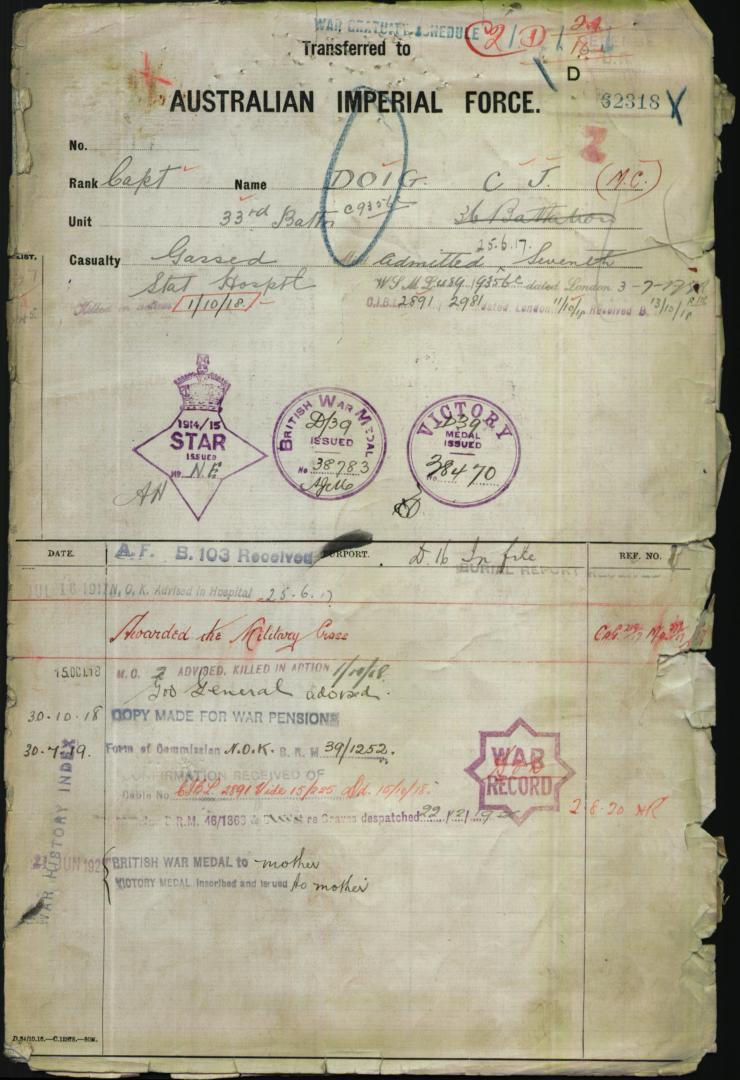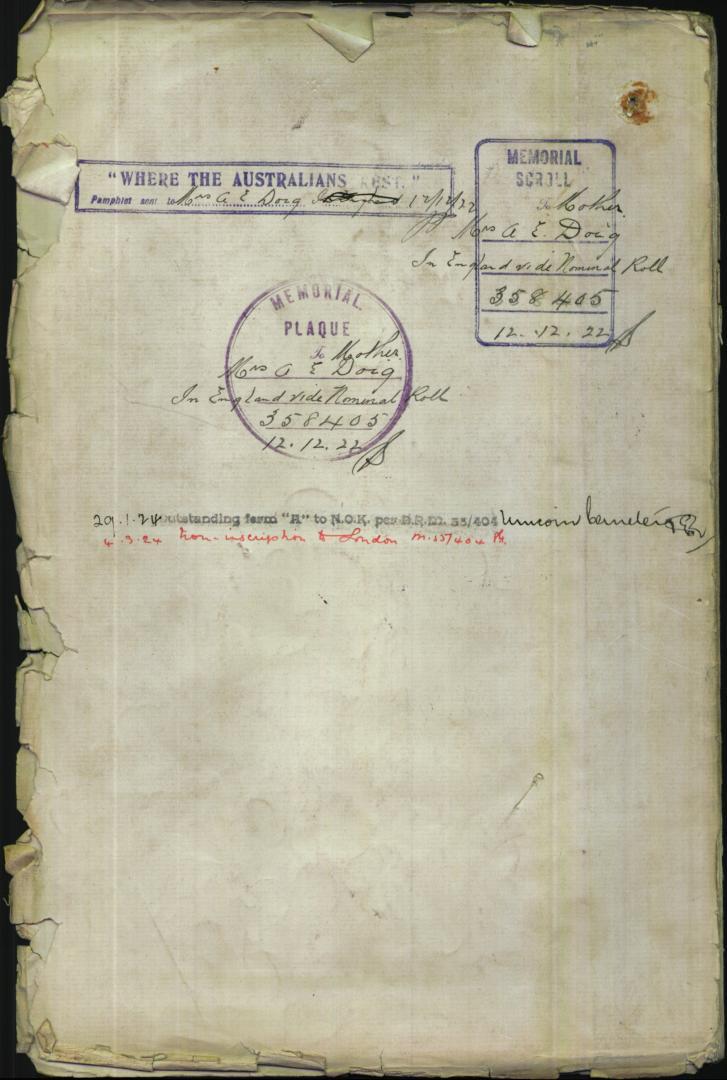
34th BATTALION A.I.F.
Captain: Norman Sydney CAINS. M.C. & Bar. M.I.D.
Born: 12th August 1893. Sydney, New South Wales, Australia. Birth Cert:38269/1893.
Married: 1923. Sydney, New South Wales, Australia. Marriage Cert:13361/1923.
Wife: Margerie Rolls Cains. nee: Austin.
Died: 29th December 1984. New South Wales, Australia. Death Cert:200134/1985.
Father: William Charles Cains. (18..-1924) Died Chatswood, N.S.W. Death Cert:5993/1924.
Mother: Fanny Amelia Cains. nee: Petherbridge. (1860-1917) Born Sydney, N.S.W. Birth Cert:1416/1860 and Died Waverley, N.S.W. Death Cert:13261/1917.
INFORMATION
Norman Sydney Cains enlisted with the AIF on the 24th July 1915 and was promoted to 2nd Lieutenant on the 20th January 1916 where he was allocated to the 34th Battalion AIF and was an original member of the Battalion. Norman had previous service with the 25th Infantry Battalion where he held the rank of Company Sergeant Major. 2: On 1st May 1916, the Battalion left by Train from Farley Station for the Showground in Sydney, equipped with kit bags and necessary clothing, and was reviewed in Moore Park by General: Gustave Mario RAMACCOTTI. On the following morning, 2nd May 1916 the men embarked on the transport HMAT A20 "HORORATA" and sailed at 4:00 pm".

H.M.A.T. A20 "HORORATA"
The voyage to England was without any unusual incidents and a good passage throughout. The first port of call was Albany, where three days were spent. Columbo was reached on Empire Day, 24th May. Here two days were taken up coaling and taking on provisions, etc. During the stay the Battalion carried out a route march through the town. Suez was reached on 8th June, where a party of Light Horse and some details were disembarked. Arriving at Port Said on 9th, the ship coaled and proceeded to Alexandria which was reached on 11th June 1916.
Here the Battalion transferred to S.S."Aragon", E867. Some Australian Details were on board, also a number of Tommies going to England on Furlough. Devonport was reached on the 23rd June, the Battalion disembarked at Plymouth at 1:00 pm and en trained during the afternoon for Amesbury, arriving at midnight.
1: Norman was promoted to Lieutenant on the 1st August 1916 after he completed his secondment with the 3rd Divisional Trench Mortar Battery. 2: In October the 34th Battalion was reviewed at a Divisional Parade by His Majesty King George V at Bulford.
The 34th Battalion left Larkhill on the 21st November and en trained at Amesbury for Southampton, embarking on the S.S "Arundel". The transport section left by S.S. "Princess Victoria". The Battalion arrived at Le Harve, France on the 22nd November 1916. Disembarkation commenced at 8:00 am and the Battalion marched to No;1 camp on the Hill, arriving at 2:00 pm. The men carried heavy loads, in some cases amounting to miniature Q.M.' Stores. The march over cobblestones was very tiring, notwithstanding the many route marches which had been carried out at Larkhill. However, after bathing their feet and receiving treatment, as well partaking of a good meal, some spent a comfortable night.
The following morning the Battalion moved to Le Harve Railway Station, leaving D Company behind. On arrival at the Station en training commenced at 8:00 am and the train left at 11:15 am. The journey was slow and occupied until 4:30 pm on the 24th. On arrival at Bailleul the men de trained and marched to Outtersteene. D Company arrived at 4:00 pm the following day. The Battalion rested here in billets for two days previous to taking over garrison duties in the Line at Armenties. The Commanding Officer Lieutenant Colonel. Malcolm St John LAMB. with the Adjutant, Company Commanders, N.C.O's and Specialists went into the Line to inspect Trenches, Stores, Plans and to arrange for the taking over this Section of the line on the following day.
The specialists and N.C.O's remained in the Line. On 27th November the Battalion went into the Line in the L'Epinette Sector. The men were taken up by motor lorries as far as the Square near Houplines Station, and marched via Butterne Avenue and Willow Walk to the Line, carrying their packs and blankets into the trenches. Lewis Gun ammunition was taken into the Line with the tin cases. The going was difficult owing to the conditions of the Trenches and the heavy and bulky loads. Later the blankets were dumped near Tussage Dump, from which most of them disappeared. This was the main incident of our relief in the Line.
MENTIONED in DISPATCHES
London Gazette 28th December 1917. Page 13565 Position 114.
Commonwealth of Australia Gazette 18th April 1918. Page 843 Position 44.
March 1918.
Recommended for MILITARY CROSS
This Officer had commanded a Company for 10 months in a most efficient manner. the lead Company in the attack on MESSINES with the greatest courage and dash, his personality inspired his unit with complete confidence and his general handling of his men for the last 18 months has been of the highest possible order.
2: On 5th May "D" Company plus 2 Platoons of "A" Company and "B" Company plus 2 Platoons of "A" company in conjunction with the 35th Battalion again advanced the picquet Line, capturing about 100 Prisoners and Machine Guns. The success of the operation was greatly assisted by the bravery of the signal Officer, Lieutenant. 932 Hector Reginald McLEOD, who after members of his Signal Staff had become casualties, in over 1,000 yards of line repaired 62 breaks. At 9:00 pm on 6th May "C" Company moved forward to occupy a new line of Posts. Owing to the darkness touch was lost between Platoons and No: 9 and 10 were unable to advance due to wire obstacles and enemy Strong Posts. No: 11 Platoon came into contact with a cluster of Strong Points and suffered a number of casualties without being able to eject the enemy from their position.
The Platoon Commander, Lieutenant: 1790 Stanley Harold HUBBARD. collected his men and moved in a North Easterly direction and on reaching the Bray-Corbie Road, made contact with "B" Company, at 1:30 am. As there were no Trenches and the men were only occupying pot holes, he placed his Platoon in drainage holes beside the road, in order to cover "B" Company's flank with Lewis Guns. At 2:00 pm on 7th May this platoon and one from "B" Company under Lieutenant: Sydney Rodgers NICKLIN attacked the enemy Pot Hole Line extending 150 yards South of the road. Captain: Norman Sydney CAIRNS ably assisted from his position on the road with Lewis guns and Rifle Grenades fired by Lieutenant: Harold Wydham LILJA on anything holding up the advance. A Stokes Mortar Barrage helped clear the enemy from his position, with the result that the operation was entirely successful.
5-6th May 1918.
MILITARY CROSS
For conspicuous gallantry and devotion to duty during an attack on enemy position in the vicinity of MORLANCOURT near ALBERT on the night of May 5/6 1918. He was in command of a Company during the attack and led his men in a most courageous manner to the final objective. He consolidated the captured position most skillfully. The enemy during the night counter attacked the Company and drove in the right flank. Captain CAINS immediately organised and led a counter attack and promptly ejected the enemy. He exhibited magnificent leadership and fearlessness throughout the operation.
London Gazette 16th September 1918. Page 11046 Position 3.
Commonwealth of Australia Gazette 4th of February 1919. Page 134 Position 17.
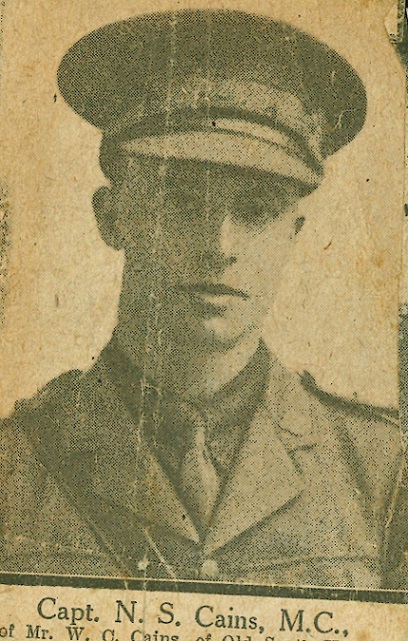
Captain Norman Sydney Cains (1893-1984)
8th August 1918.
Report of the Operation Conducted by the Battalion This Day. Headquarters 34th Battalion AIF. 8-8-18 ASSEMBLY.
The Assembly March passed without incident and there were no casualties. The Battalion was in position for the assault at 3:25 am.
BARRAGE. The barrage opened at 4:20 am and was accurately placed. The enemy immediately fired single and double Red and Golden Rain Light Signals. The enemy's reply to our barrarge was very ineffective but his Machine Gun fire was considerable during the early stages of the advance, but caused very few casualties.
LOCATIONS. Battalion Headquarters was located at P.16.c.1.7 before Zero, after Zero a temporary Headquarters was established at the Quarry at P.16.b.2.8 pending the report and the capture of ACCROCHE WOOD, from the two flank Companies.
THE ADVANCE. Owing to the dense fog observation was impossible and the tanks appeared to have great difficulty in keeping in touch with the direction. Runners were sent forward at 4:45 am to get in touch with the assault parties and at 5:15 am they brought back word from Captain: Albert Edward YATES 35th Battalion that his Company was through the Wood. Battalion Headquarters then moved forward through the wood towards CERISY VALLEY.About 150 stragglers of all Battalions including 3 Lewis Gun Teams were collected during the advance and formed into a Company.
Owing to the density of the fog and the obscurity of the forward position forward I deployed the Company and took them forward as far as GAILLY Line arriving there at 5:45 am. We later met a detachment of prisoners and were told by the escort that CERISY VALLEY was partially mopped up and most of the Units were moving forward to their objective. I than ordered all men of the 33rd and 35th Battalions to go forward to join their respective Units, and organised two posts with the men of the 34th Battalion, placing one in the enemy trench at P.24.b.3.3 (approx) and the other at P.18.d.0.7 (approx).
This latter post shortly afterwards established liaison with the 11th Brigade. The remainder of the Battalion assisted the 33rd and 35th Battalions in capturing and consolidating the GREEN Line. They were released from the GREEN Line between 9:45 am and 10:15 am and proceeded then to consolidate the GAILLY and RESERVE Lines as shown on map forwarded.
BOOTY. Owing to the conditions existing it was impossible to estimate the number of prisoners captured by the Battalion as prisoners from the 3 Battalions were grouped to reduce the number of men required for escort. So far no estimate has been made of the number of Trench Mortars and Machine guns etc, captured in the area. Salvage operations are in progress and as soon as they are completed a detailed report will be forwarded. In the CERISY VALLEY one 21 cm and eight 7.7 cm guns were captured together with large quantities of ammunition.
Commanding Officer 34th Battalion AIF. (34th Battalion War Diary)
18th August 1918.
3: Weather threatening but clearing, following project bombardment on our right, heavy bombardment followed. C.O. called on left headquarters. Our planes brought down enemy plane in flames but it dropped behind BRAY. C.O. visited posts. 3 O/Rs Killed 1 Officer Lieutenant: 10480 Robert WIGHT and 6 O/Rs wounded.
21-22 August 1918.
"Zero Hour, August 21st, at thick fog lay across the front. The allied 3rd Army's Guns were clearly audible to the north. As reports filtered to the waiting Diggers, they learned that the Germans had been surprised, all objectives had been achieved and 2,000 prisoners had been taken. Because of the comparative ease of the victory of that first phase, it was decided to extend the second phase of the objectives. Gellibrand issued orders to continue the assault if the British 47th, on the Australian left flank, were successful and Bray was cleared. Unfortunately these orders, being last-minute, did not arrive at all units.
For the Australians their first active involvement in the action was planned for dawn on the 22nd August, at 4:45 am. At 2:20 am the Germans, possibly anticipating an attack, opened up with a barrage of artillery which went for an hour.
BAR to MILITARY CROSS
'For conspicuous gallantry and devotion to duty west of Bray on 22nd August 1918. He commanded a company on the left flank during a withdrawal of the line, protecting that flank which was in the air, and maintaining liaison with the next unit. His courage, determination, and ability were a fine example to the men, and contributed to the defeat of the counter attack.'
London Gazette 1st February 1919. Page 1635 Position 3.
Commonwealth of Australia Gazette 3rd June 1919. Page 944 Position 11.
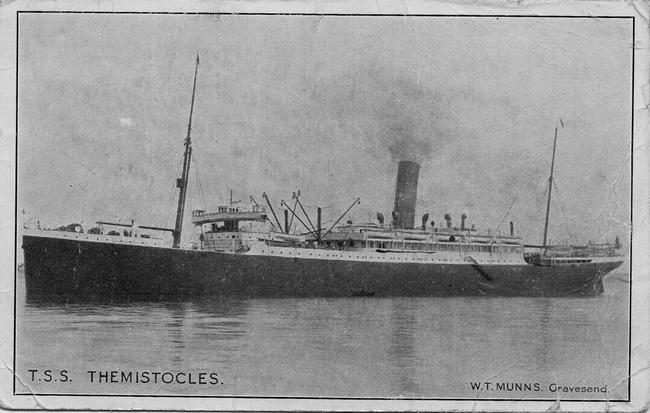
Norman embarked from England on the 12 June 1919 on board the HMAT "THEMISTOCLES".
1: David Harrower.
2: 34TH BATTALION AIF SHORT HISTORY.
3: 34th Battalion War Diary
Family Information
Norman was a single 21 year old Architect and Draughtsman upon enlistment. Norman's parents William and Fanny Cains were married in 1883 at East Maitland, N.S.W. Marriage Cert:5509/1883 and had 6 children (2 sets of twins) Percival E Cains born 1884 at Paddington, N.S.W. Birth Cert:8953/1884 and died 1910 at Woollahra. N.S.W. Death Cert:16125/1910. Vera C Cains born 1887 at Paddington, N.S.W. Birth Cert:10288/1887. William H Cain born 1887 at Paddington, N.S.W. Birth Cert:10289/1887. Lydia O Cain born 1889 at Ashfield, N.S.W. Birth Cert:5590/1889. Norman Sydney Cain born 1893 at Waverley, N.S.W. Birth Cert:38269/1893. Robert Harold Cain born 1893 at Waverley, N.S.W. Birth Cert:38270/1893 and died 1969 at St Leonards, N.S.W. Death Cert: 26296/1969.
Norman served during world War 2 with the 30th Infantry Battalion, service number: NX 112693. He was living at 18 Clifford St Gordon, N.S.W. at this time. Norman was cremated and the service was conducted at Macquarie Park Cemetery and Crematorium for Norman Sydney Cains on the 2 January 1985.
Burial Location: GENLAWN/V6/0057.
Military Records
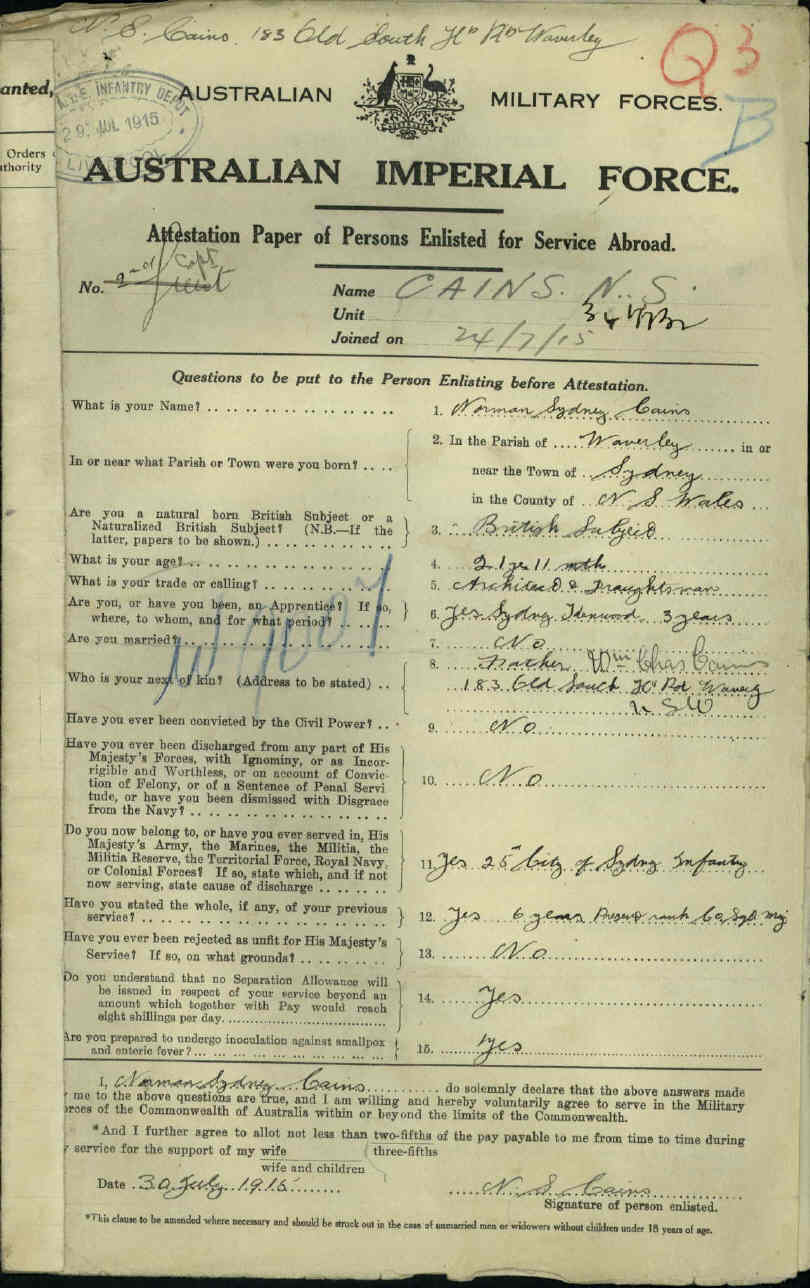
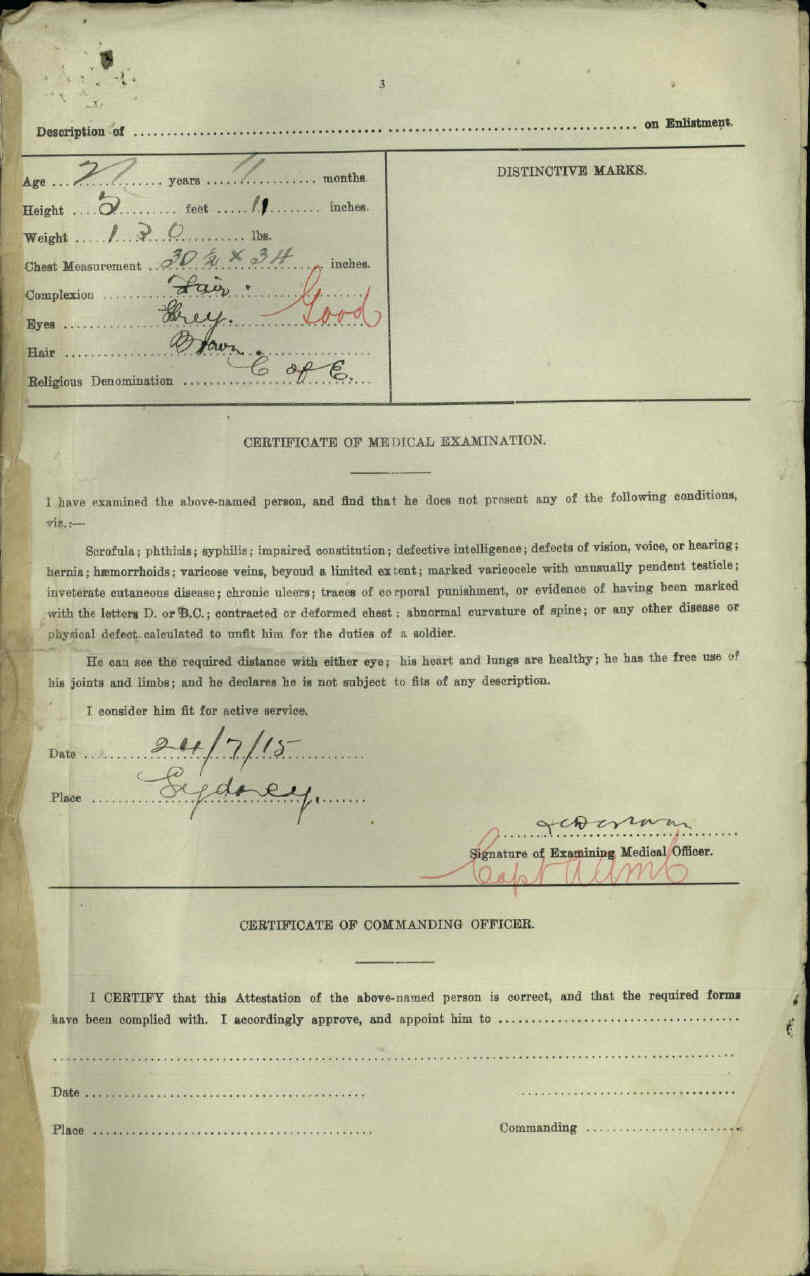
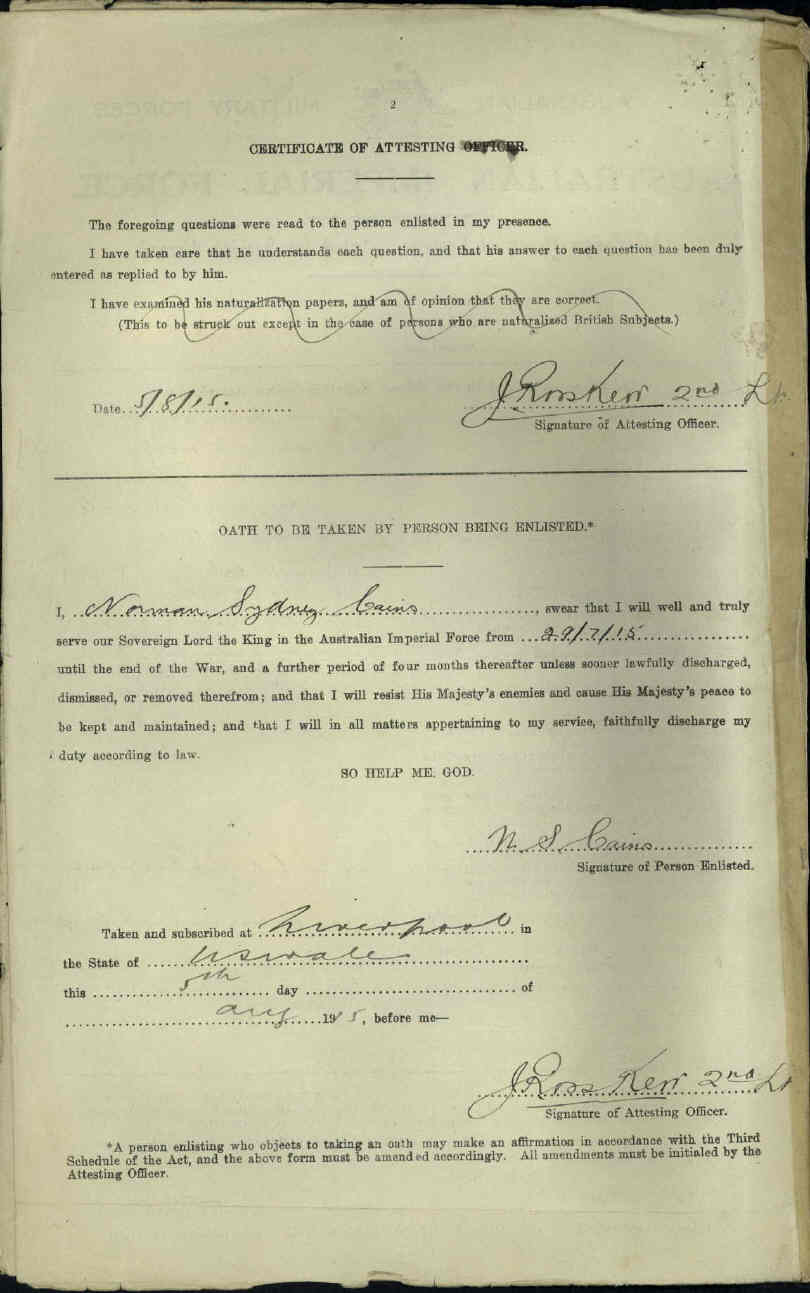
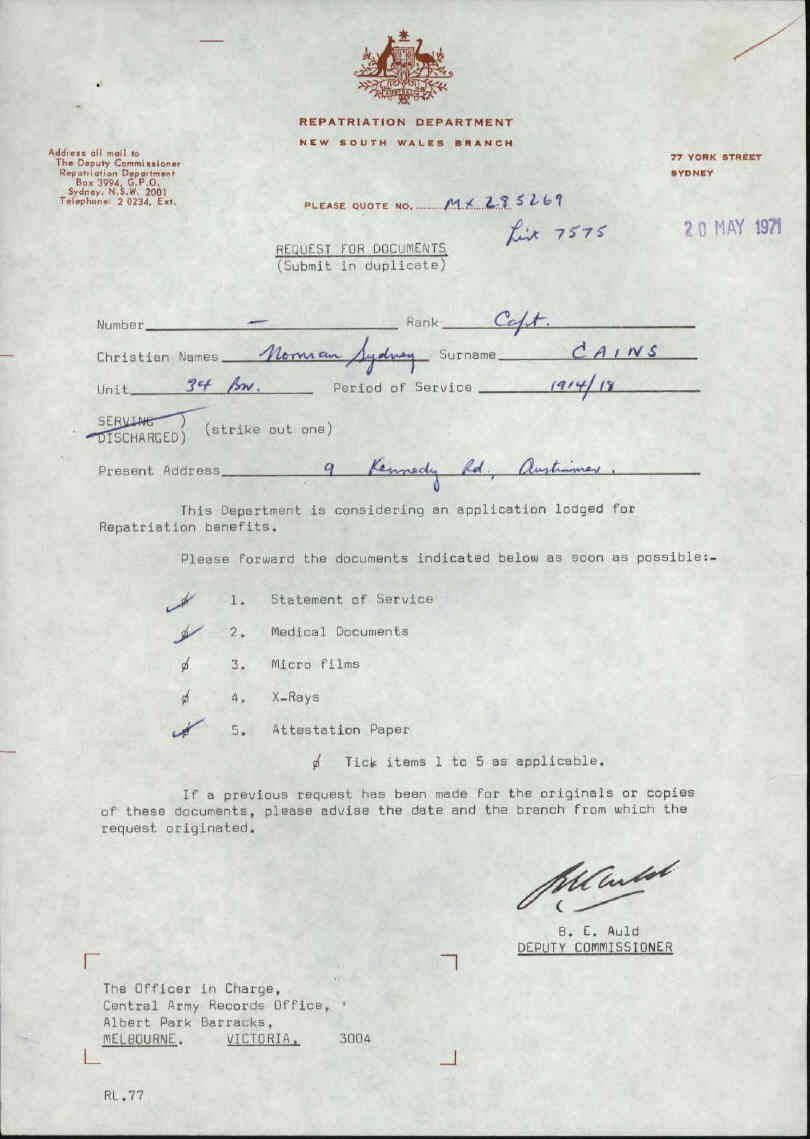
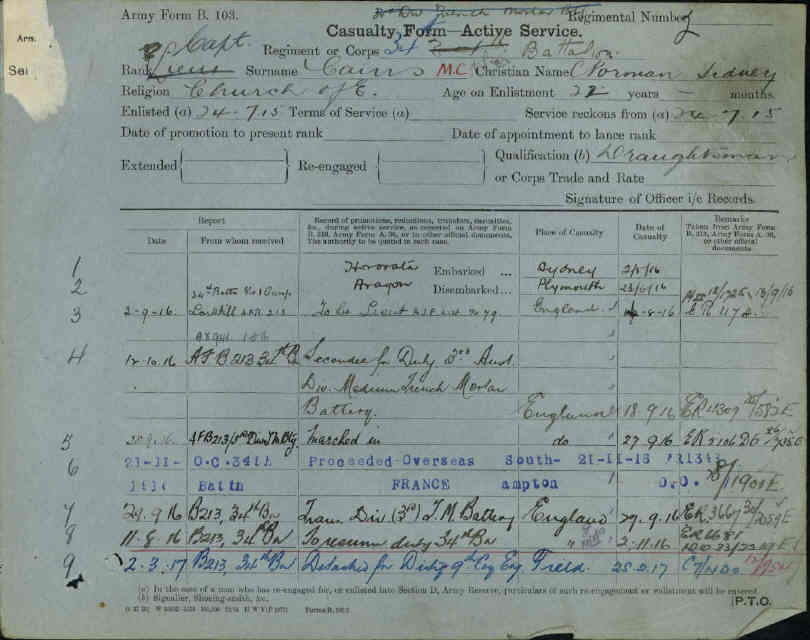

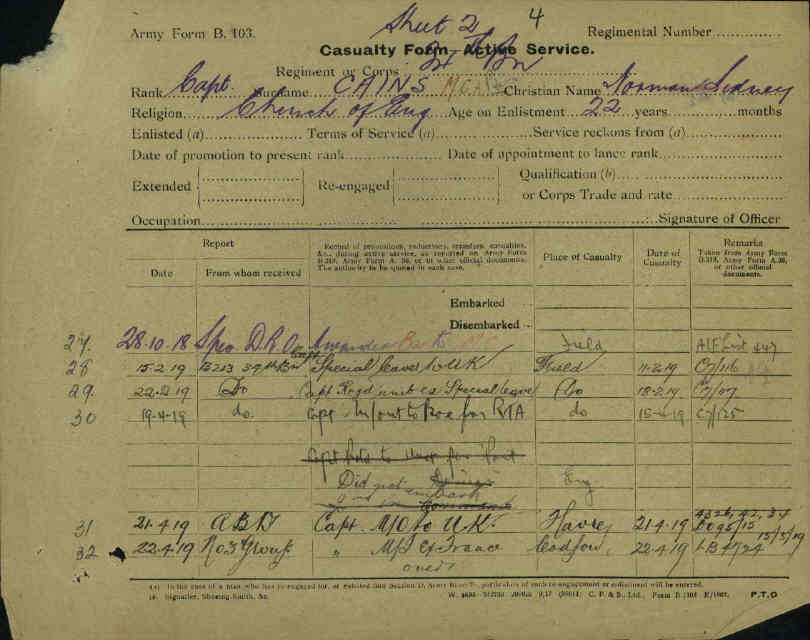
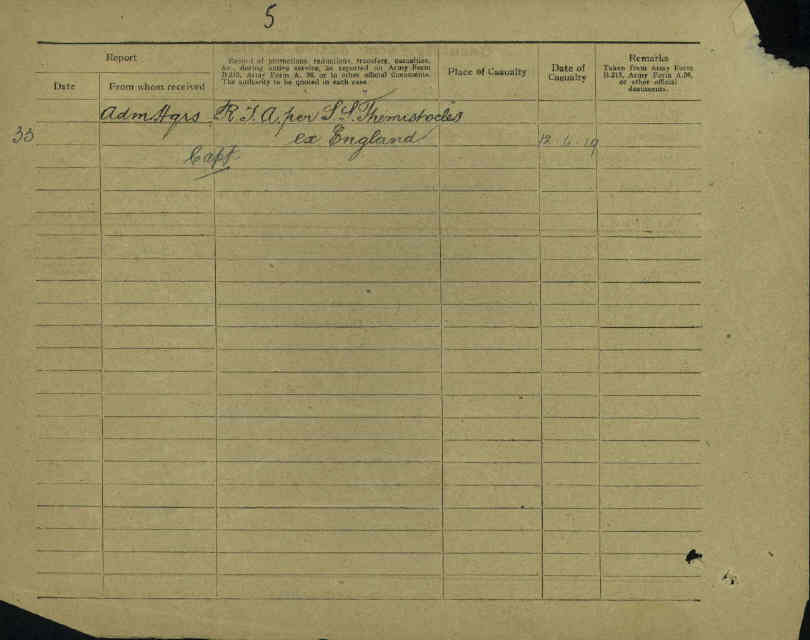

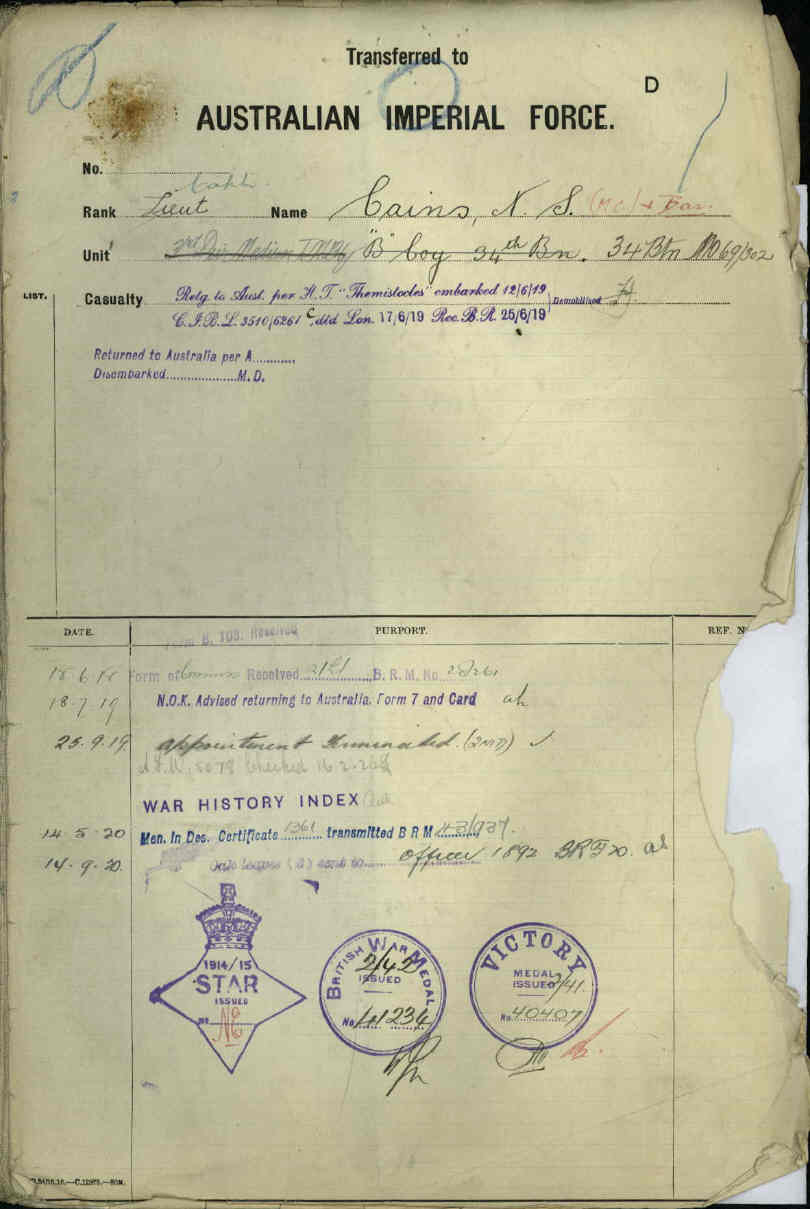
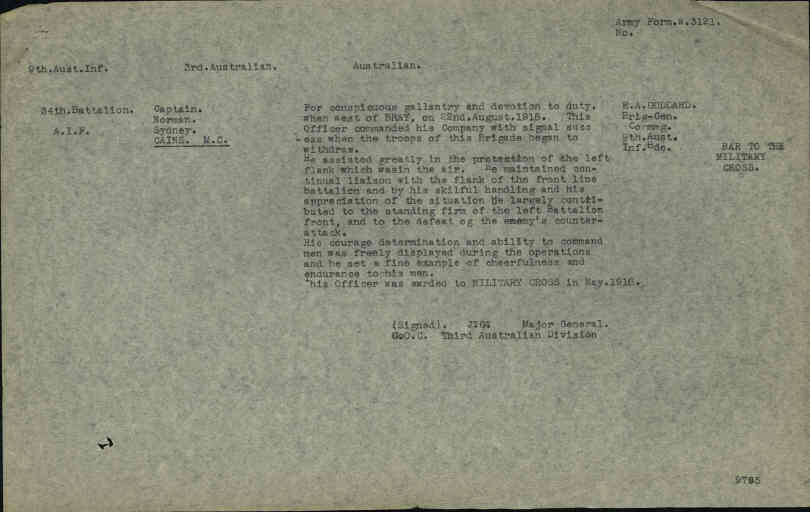
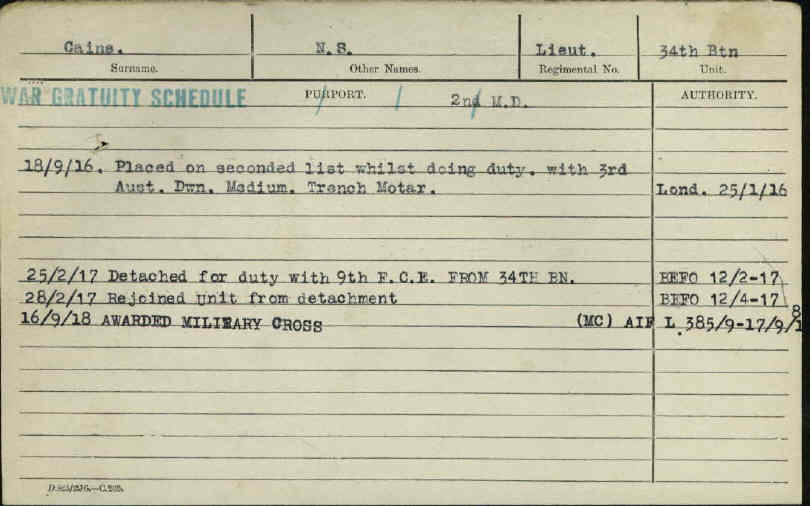


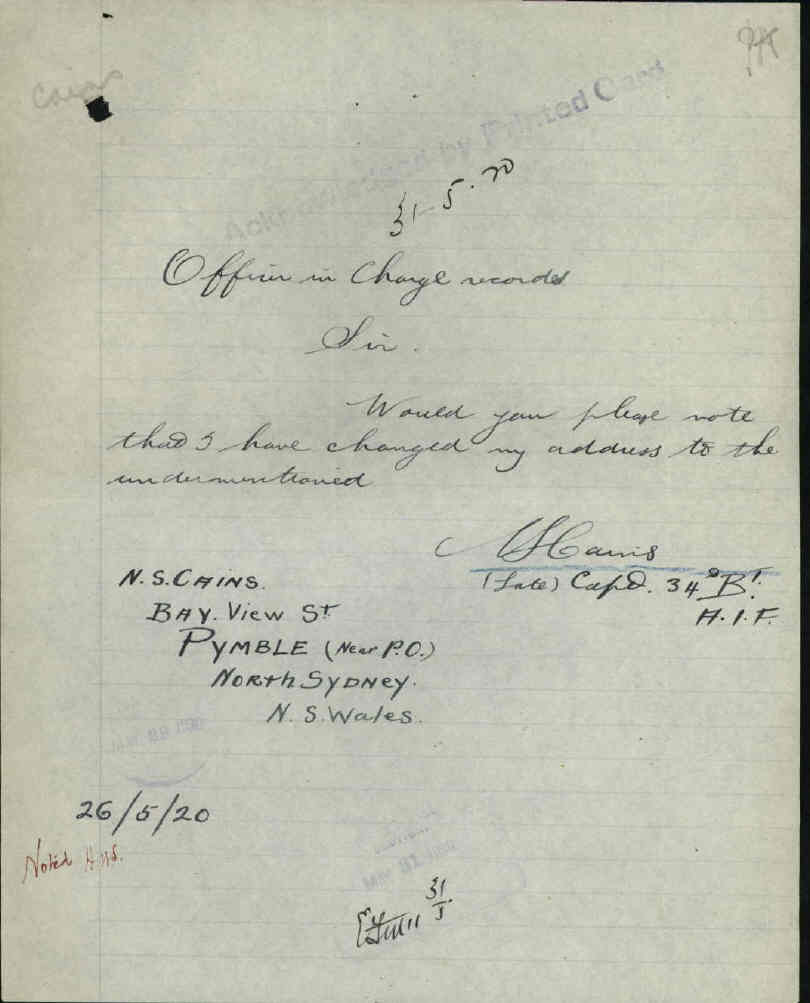

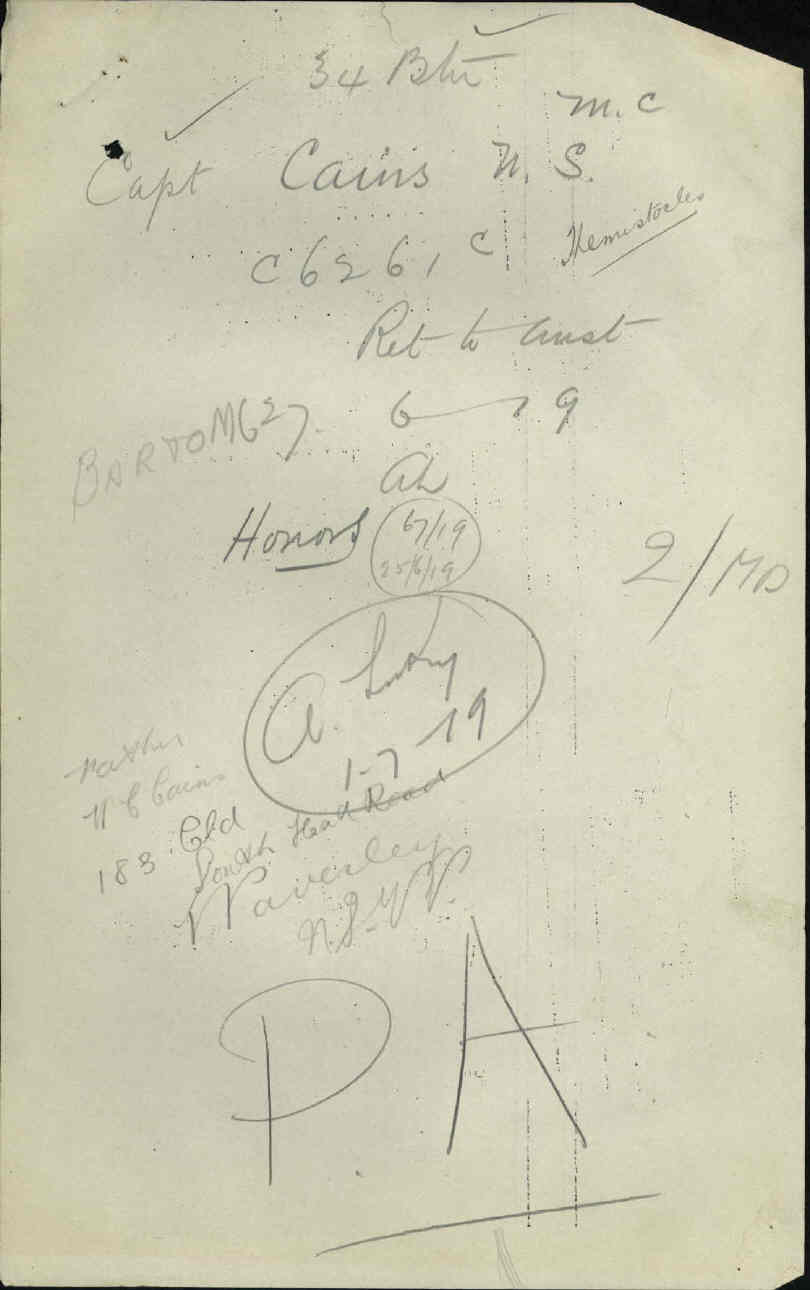


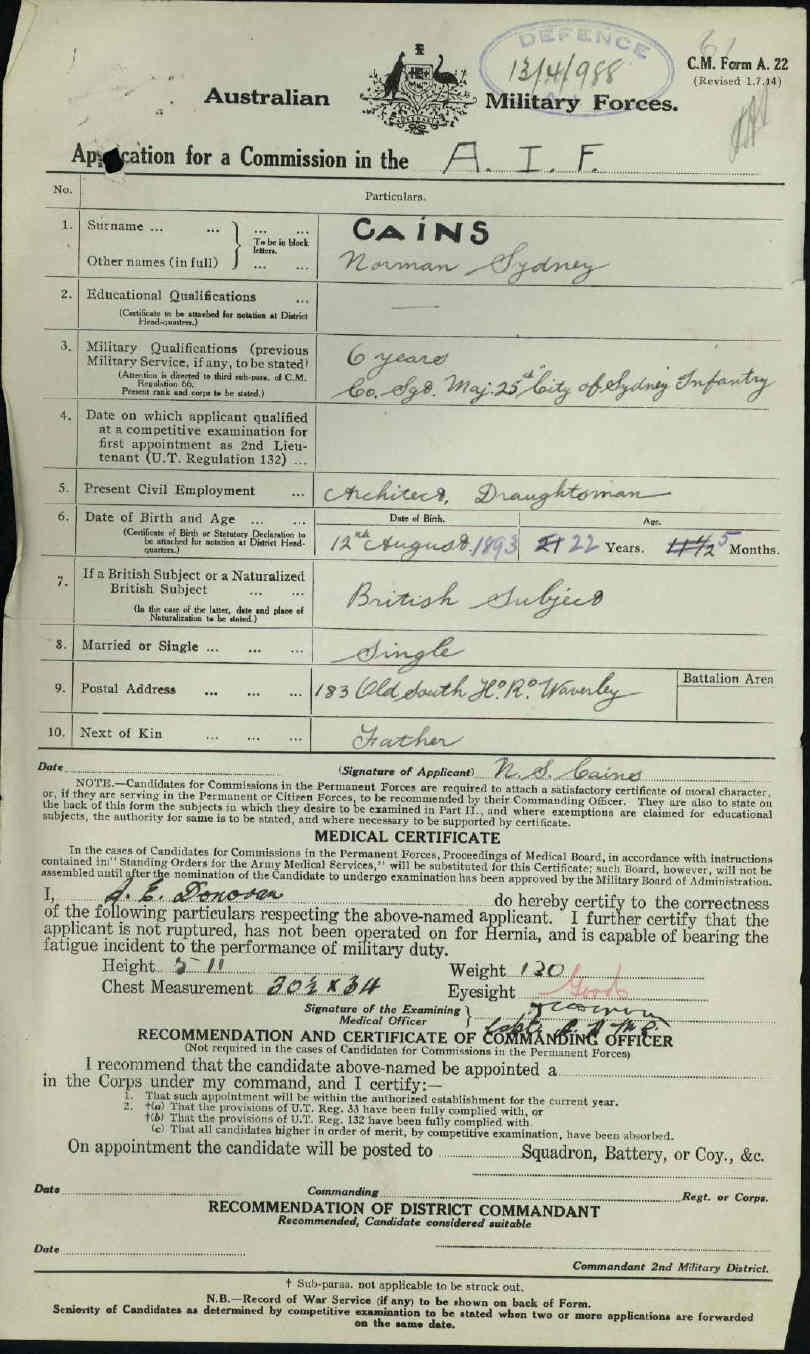


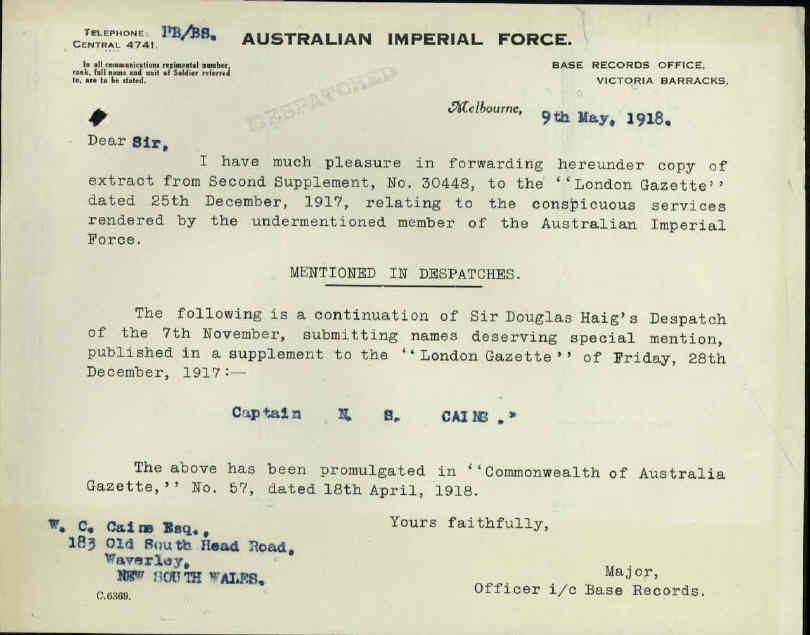


World War 2 Records



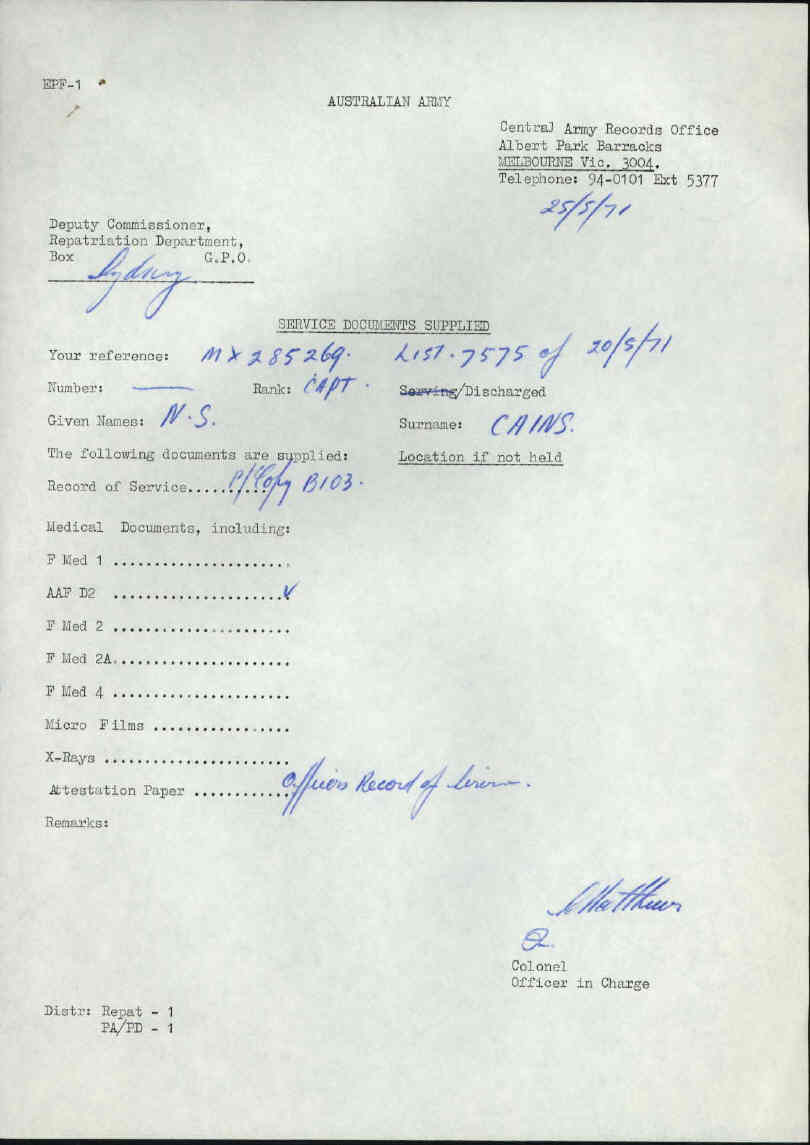
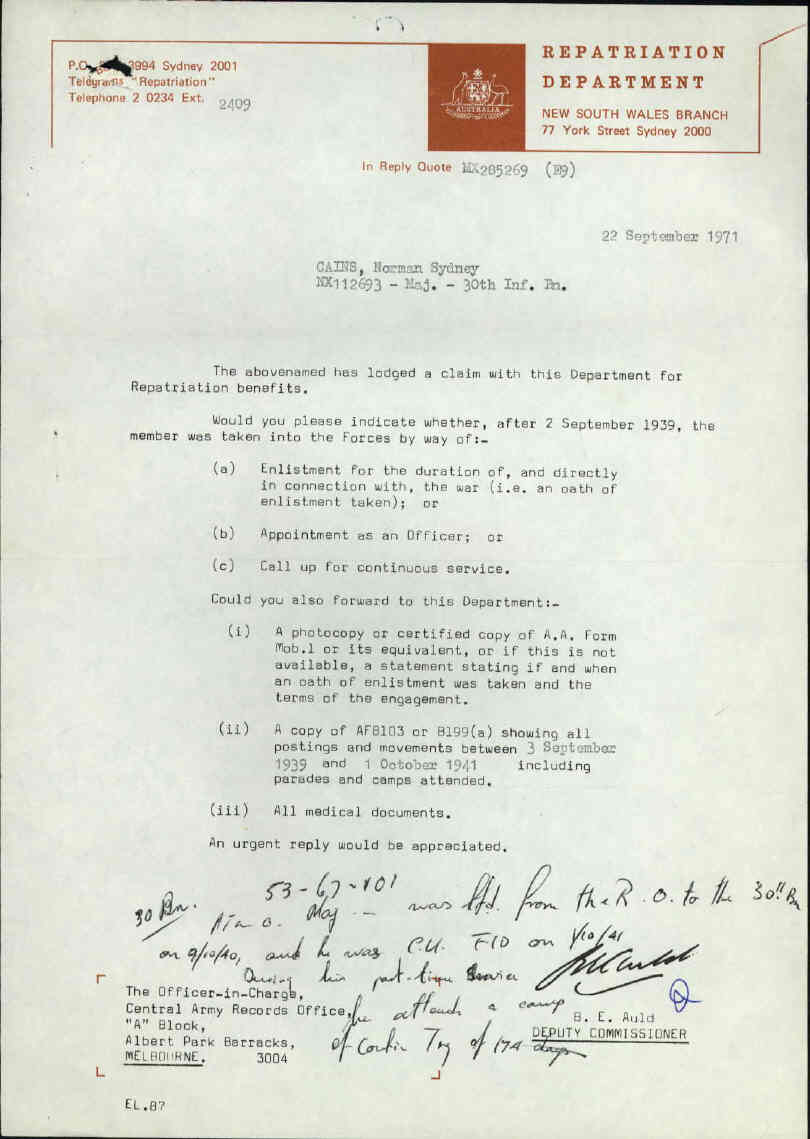

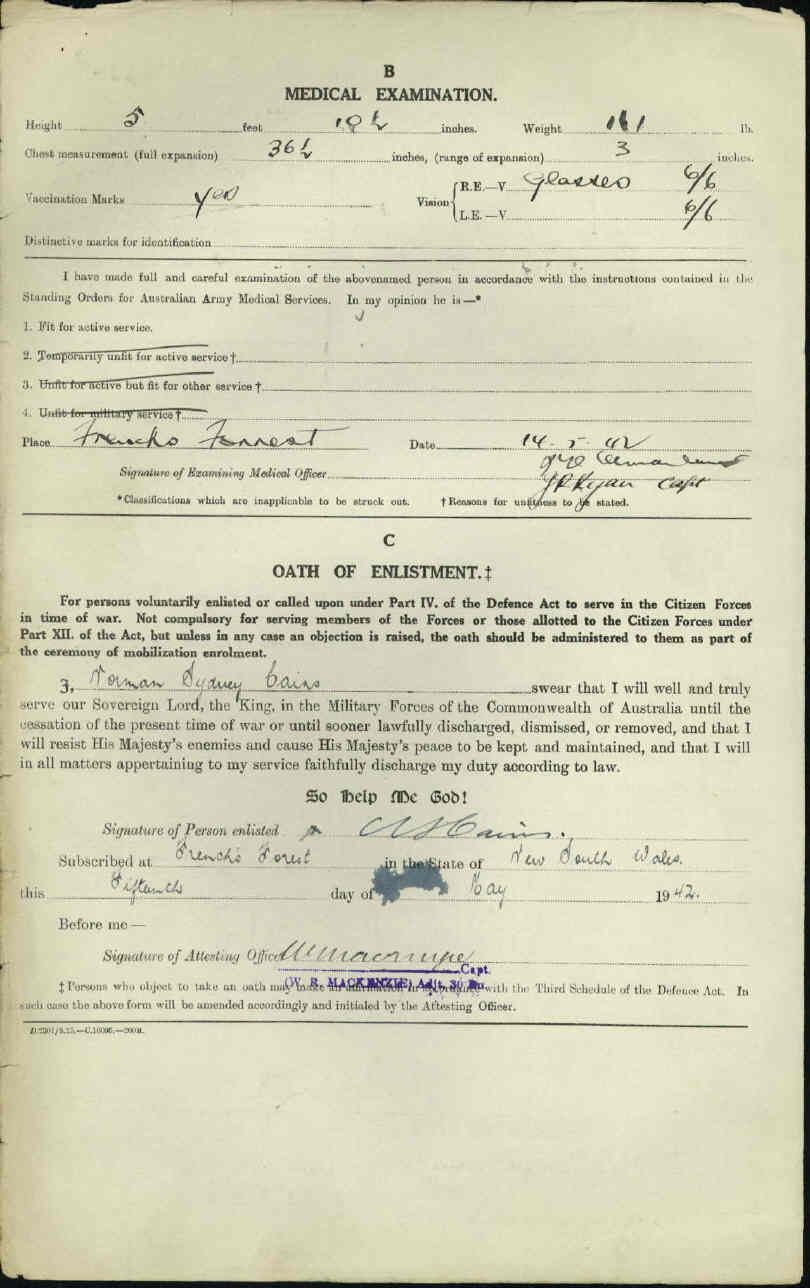
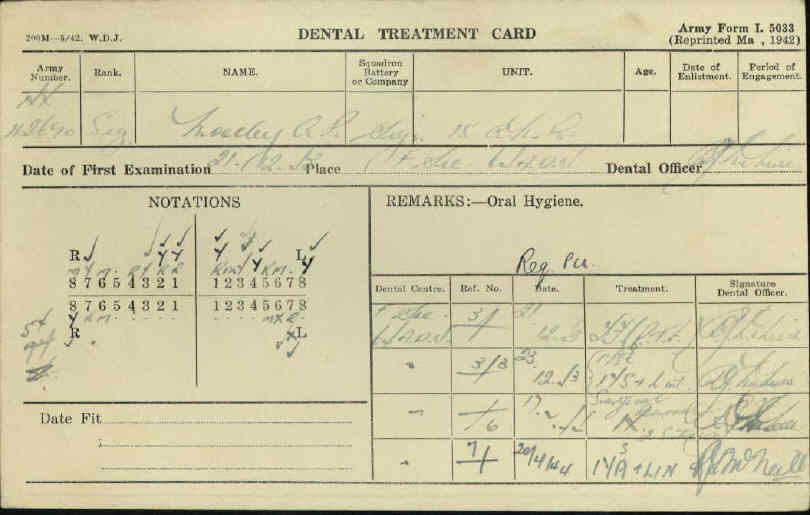
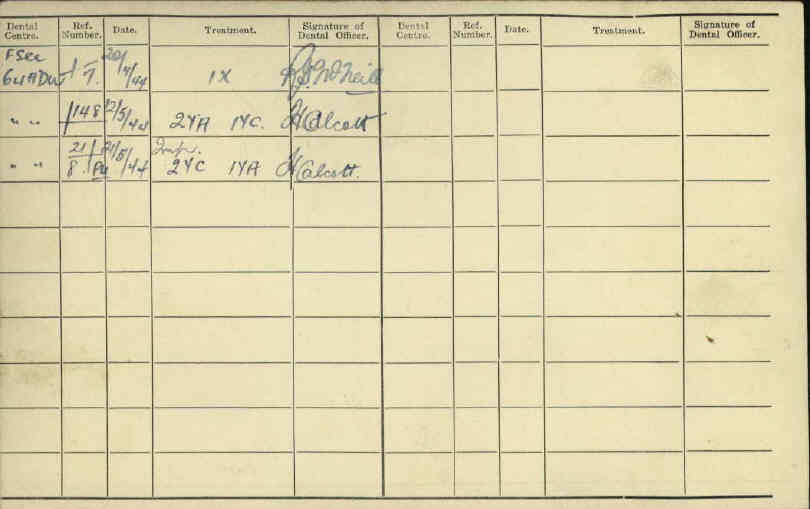
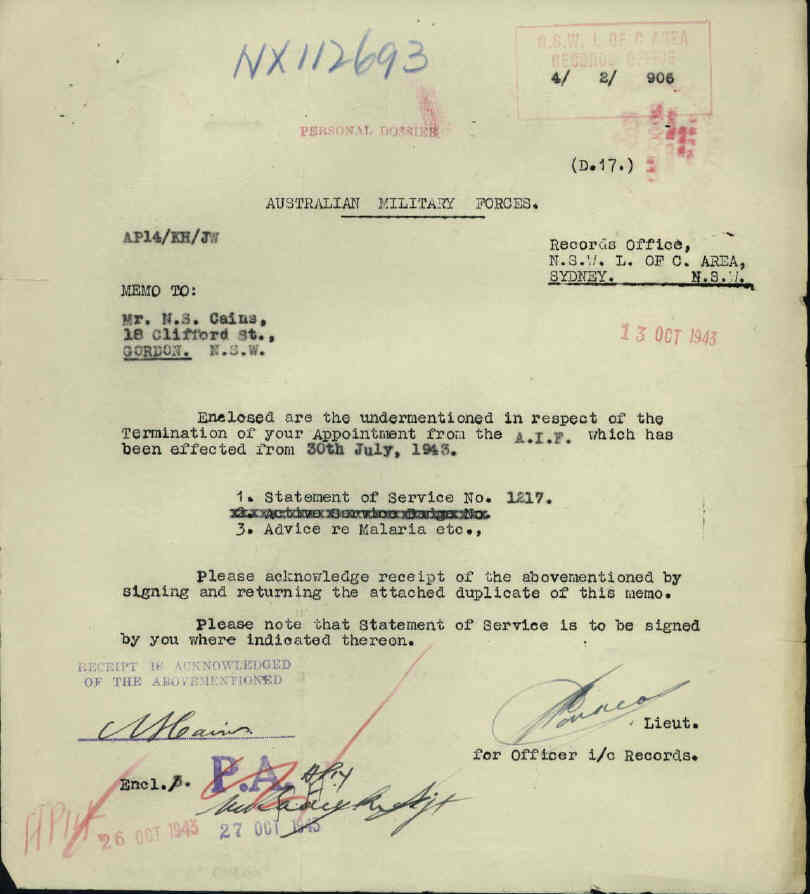


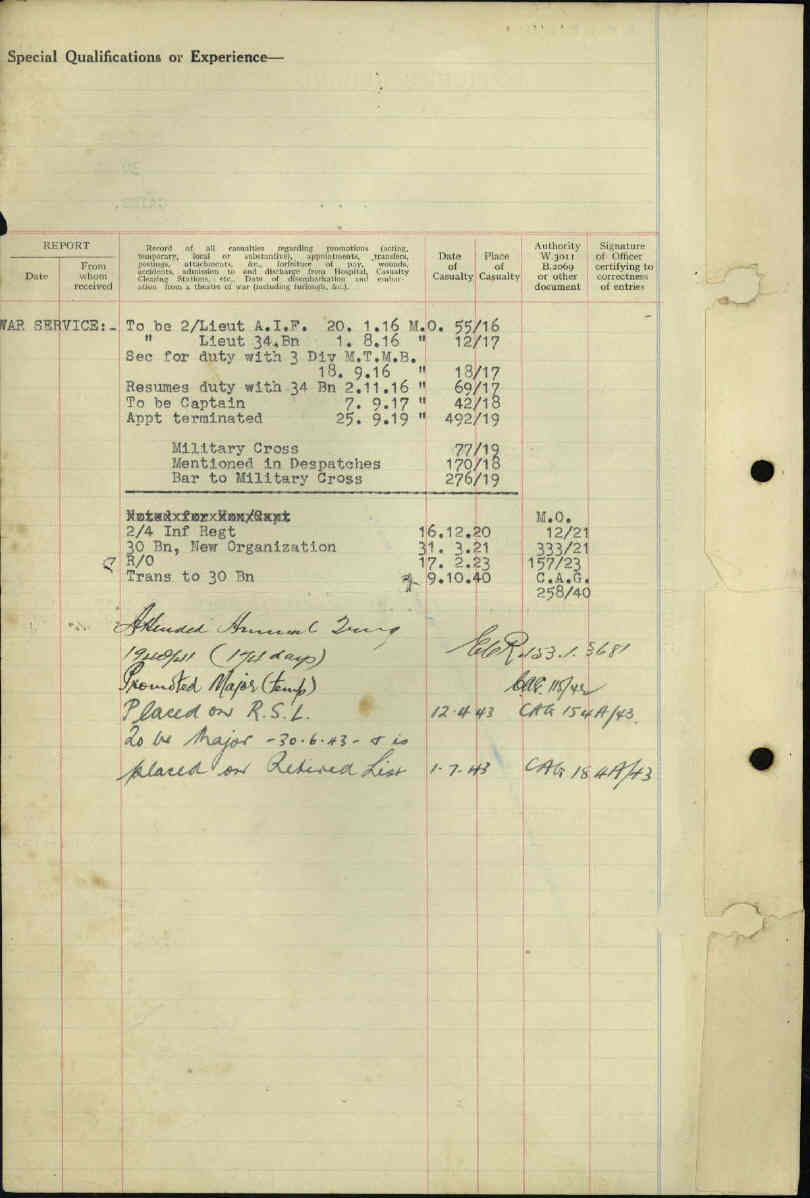
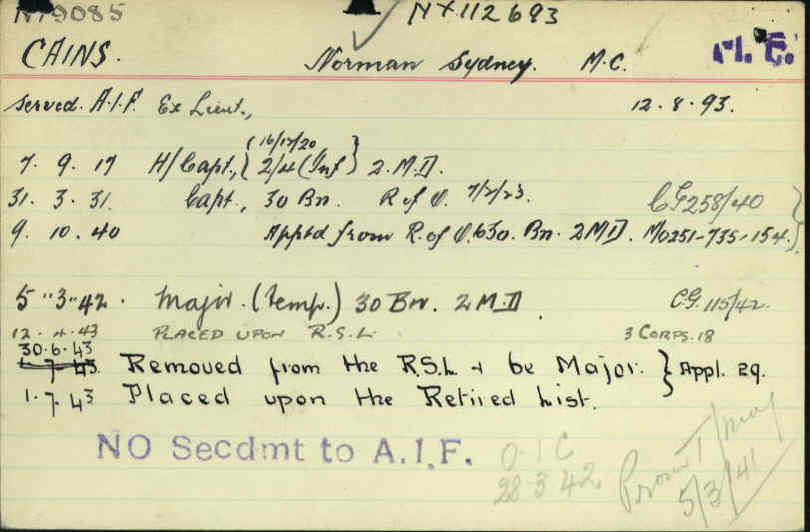

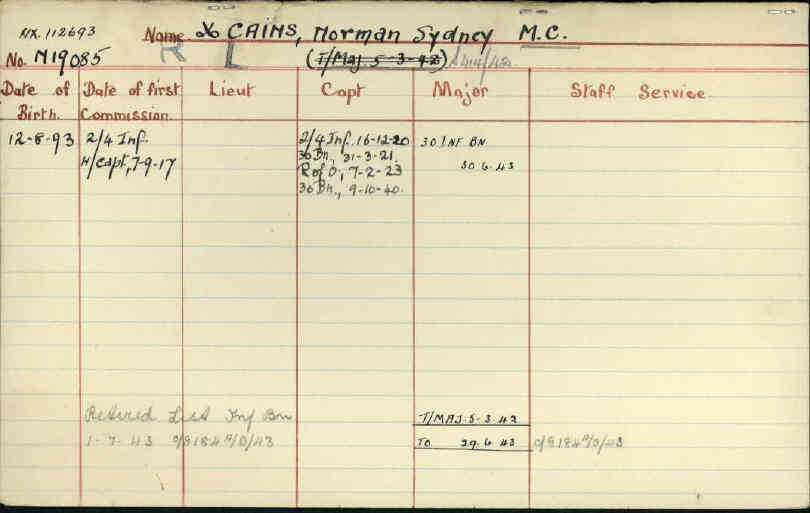
© Commonwealth of Australia (National Archives of Australia)
Under Construction; 06/11/2010-15/07/2020.
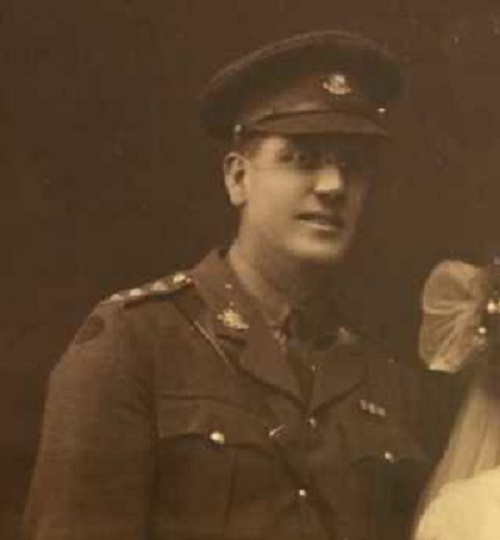
 KARLSRUHN OFFICERS CAMP.24th June 1918.
KARLSRUHN OFFICERS CAMP.24th June 1918.